|
| PRE-INCORPORATION WEST TAMPA |
| From the
National Register of Historic Places Inventory-Nomination Form,
Sept. 7, 1963 and The Sunland Tribune,
(1981) "West Tampa Cigar Factories Reminders of Area's Past Boom,"
Sunland Tribune: Vol. 7 , Article 22.
Conceived by its developers as a community
independent from Tampa, the City of West Tampa had its own
commercial district, supporting industry, and residential areas.
Brick cigar factories scattered throughout the downtown area are
surrounded by one and two-story wood frame dwellings, usually in
close proximity to commercial structures.
At the time of its incorporation in
1895, West Tampa had no formal plan but was a series of separate
subdivisions that had been surveyed and platted by the various
landowners. Little or no provision was
made, therefore, for public squares, parks, or other city owned
properties set aside for the municipal government or the public
welfare.
|
|
HUGH MACFARLANE, "THE
FATHER OF WEST TAMPA"
Most of the
info in this feature is from
"Hugh Macfarlane: West Tampa Pioneer" by Glenn Westfall,
Hillsborough Community College at USF Digital
Commons. TampaPix has presented Westfall's article and
has used it to find more details and supporting
evidence. Where no evidence found that proved
otherwise, Westfall's findings are presented.
Changes have been made to some of his article, which are
presented with source evidence in various sections of
this page. Some info below is also from
"The History of West Tampa, Get to Know the Story Behind
the Real Cigar City" by Rodney Kite-Powell.
It is suggested that you read both of these excellent
works.
Hugh Macfarlane's settlement
and efforts in
Tampa turned his immigrant dreams into a reality and
resulted in an invaluable
benefit to his city, state, and newly adopted nation.
Hugh Campbell Macfarlane
was born in Scotland on December 28, 1851. His middle
name was his mother's maiden name. When
two-and-a-half months shy of his fourteenth birthday,
Hugh, his three sisters, two brothers, and his parents migrated to the United States.
They arrived first at the Port of New York in October
1865 and soon settled in Fall River, Massachusetts where
his father and brothers took jobs in the many textile
mills. In
late 1869 or early 1870, when Hugh was around eighteen
years old, the family moved to Raymond, Minnesota, which is about
95 miles west of Minneapolis/St. Paul. At St.
Paul, Hugh
attended St. John’s College and upon graduating, he alone
moved to Boston. There he worked for a short time as a
newspaper reporter before enrolling full time as a law
student at Boston University. Upon graduation, he was
admitted in January 1879 to the Massachusetts bar.
Hugh married Sarah A. Brown the next month and soon
became active in civic and political organizations.
In May 1879
he joined with an older, more experienced lawyer as a
two-man law partnership.
According to Westfall,
Hugh's marriage was a short one; some time after giving
birth to a son, the couple were divorced. Hugh decided to
begin a new life by moving to New Orleans.
It was in the sunny
Southern city that Macfarlane first heard about Tampa, a
tiny coastal village along Florida’s west coast. Stories
of the village evidently intrigued him, since he decided
to move to the sleepy Gulf Coast settlement in 1884,
when he was thirty three years of age."
In Tampa, Macfarlane
quickly blended into the local political activities,
joining prominent Tampans in organizing the Tampa Board
of Trade, May 7, 1885. As a member of the Board of
Trade, Macfarlane heard the requests for information
concerning Tampa’s climate, transportation facilities
and local support to their industries. His legal advice
and assistance made him a well respected member to
Tampa’s "Old Guard" families on the Board. By
1887, he was appointed Tampa’s city attorney for a three
years and helped Tampa to reincorporate as a city.
The
recently completed Plant
railroad gave Tampa markets
access to the nation; expansion
of shipping interests, and the
phenomenal expansion of Ybor
City’s immigrant population
convinced him to capitalize on
real estate investments and
cigar making. In the late 1889s
he purchased two
hundred acres of land on the
west side of the Hillsborough River which was nothing
more than a combination of marsh and wilderness.
|
|
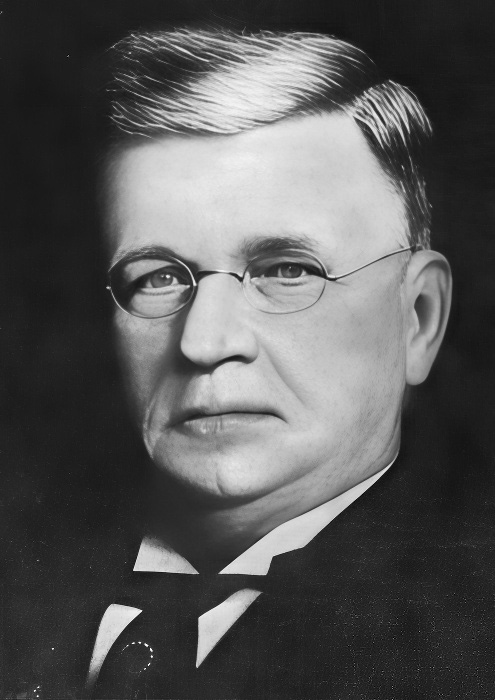 |
In the spring of 1892, Hugh
Macfarlane, who by this time was a prominent Tampa lawyer and real
estate investor, formed the Macfarlane Investment Company to develop
a new cigar manufacturing community west of the Hillsborough River.
The company consisted of himself, his cousin George Rae
Macfarlane, and his brother-in-law (his wife's brother,)
attorney Noah Brooks Kent (NBK)
Pettingill. The Pettingills were a prominent family in
Maine.
After
leaving Tampa, NBK Pettingill became
Puerto Rico's first appointed federal judge
to the U.S.
District Court in Puerto Rico from
1899 to 1900.
|
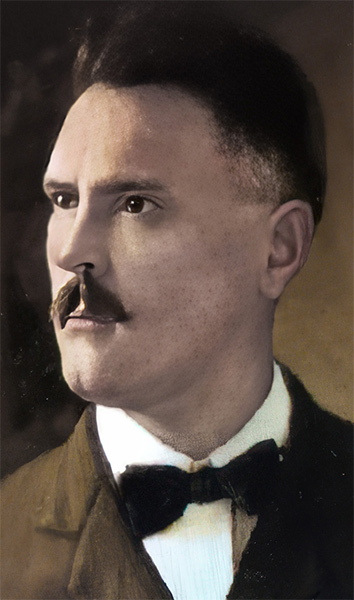
|
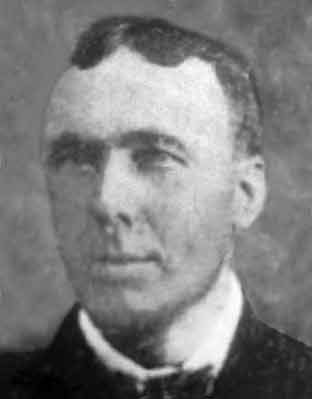 |
|
Hugh Campbell Macfarlane
c.1900
Courtesy of Andrew
Macfarlane |
Hon. Noah Brooks Kent Pettingill
c.1899
Courtesy of Portfolio of Judicial
Portraits by David Wells Roth
|
George Rae Macfarlane
1891-1892 Tampa City Councilman, Fire Chief, and
Real Estate Investor
|
|
Since
Puerto Rico's change of sovereignty in 1898 when the
U.S. acquired it from Spain, there have been thirty-two
United States judges in Puerto Rico. The first, Noah
Brooks Kent Pettingill, was appointed in 1899 to be the
Judge of the Provisional United States Court established
on June 27, 1899 by the military government pursuant to
General Order No. 88. The Provisional Court was in
existence until the Civil Government for the Island was
formed in 1900 by an Act of Congress. In 1900, Congress
also organized the first United States District Court
for the District of Puerto Rico and provided for one
judge to be appointed for a four year term. Judge
Pettingill was then succeeded by the first true United
States District Judge appointed for Puerto Rico, William
Henry Holt.
|
|
Macfarlane's first West Tampa
subdivision was filed April 22, 1892* and was an eleven block tract
that formed the heart of West Tampa, including a central square at the present
intersection of Main Street and Howard Avenue. The square, however,
never served any public function, and in 1894 the O'Halloran cigar
factory was built on it.
*The image of the plat of this filing has not yet been located by TampaPix.
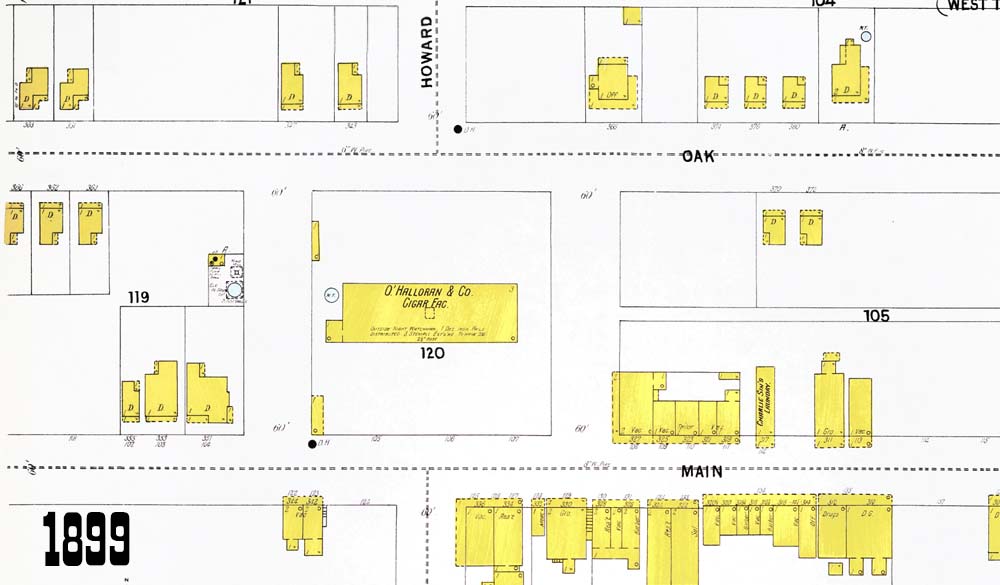
Hugh named Howard Avenue after his son, Howard
Pettingill Macfarlane. His middle name was his
mother's maiden name.
|
|
THE FIRST FORTUNE
STREET BRIDGE
In 1892 Hugh Macfarlane
financed and paid for the construction of an iron truss
bridge with a wooden roadbed to connect Fortune Street
in Tampa to Arch St. on the west side of the river. Opening the way for the labor forces to easily commute
(by foot or wagon) or even move
from from Ybor City and Tampa, the Fortune Street Bridge was a major factor in the growth of
West Tampa. Macfarlane had cigar factories built on the west side of the river and enticed large
manufacturers such as Ellinger and Roberts to move there. Many more
followed.
This bridge is frequently described as a
drawbridge, but it was not. A drawbridge is opened by lifting one
end of the draw span while the other end remains on the roadway.
Some drawbridges are double drawbridges with opposing
draw spans opening at the center, such as today's
Kennedy Blvd. bridge.
The
Fortune street bridge was an iron truss swing bridge, which rotated
horizontally at a central pivot point, much like a horizontal wheel
mounted on a vertical axle. By rotating the truss span
parallel to the river banks, tall boats could pass between the pivot column and the river bank.
The Fortune Street bridge
was turned manually, by one or two men, who would insert
the shaft of an iron "T- bar" wrench into a hole in the
center of the bridge. The handles spanned about half the
width of the road bed. It served as a giant wrench
which was fixed to the turnstile support column beneath
the road bed. By pushing on the handles, the force
of their feet pushing on the roadbed would turn the
truss span. The wrench itself did not turn;
instead of the wrench turning and the men walking in
circles around it, the bridge turned under their feet
until the span was parallel with the riverbanks.
Below is a rare view of
the original Fortune Street bridge built in 1892; it is
the only known existing photo that wasn't taken during its 1926
demolition.
Taken Mar. 13, 1924 by Al Burgert, it
wasn't even the subject of his photo. He was more
interested in capturing the "picturesque" landscape and
structures of the Mirabella fish docks on Lozano Ave.
north of the bridge. The photo is a crop of a larger
photo and the
view is looking south with West Tampa at the right
side of the photo. The pier-like structure is the
West Tampa approach to the bridge.
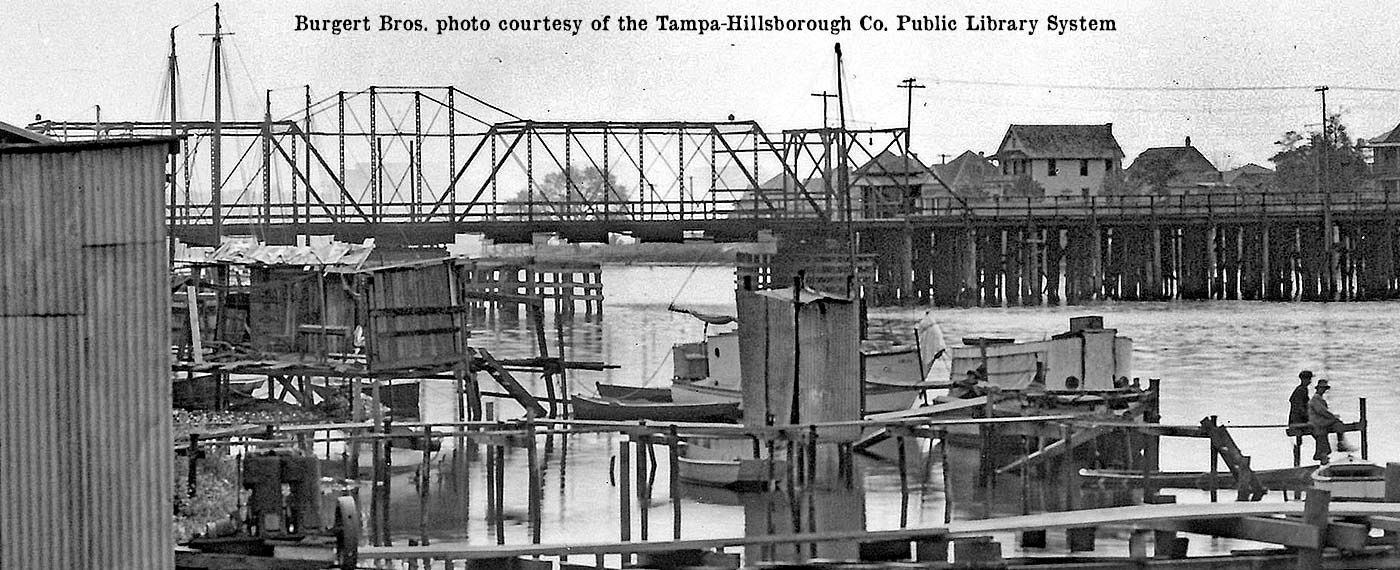
The tract on the west landing of
the bridge was originally owned by Matthew Hooper who for decades ran "Hooper's
Ferry"
service to cross the river here. In 1890 Hooper had his land
surveyed and filed the plat as "Riverview Park Subdivision." With
Hooper's cooperation and the rest of
Macfarlane's financing, which included land owners on the west side
of the river who provided $15,000 in funds and land, the bridge was
built. No City of Tampa funds were used but in later years,
the city bought the bridge.
Notice the long approach
to the truss span on the West Tampa side. This was because
the deepest part of the river was nearer to the east
bank. Also in view at the far right is the
"luxurious" Buena Vista hotel and apartments in West
Tampa.
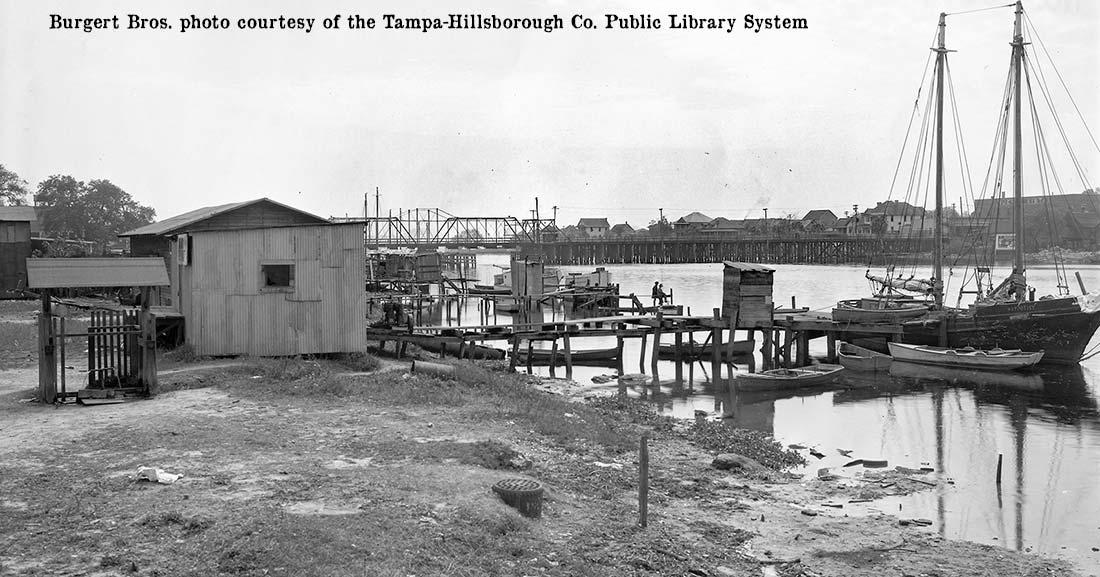
ABOUT MIRABELLA'S: If you go downtown to the
Riverwalk, near the Platt St. Bridge, you'll see a
historic marker that claims it marks the area where Bastiano Mirabella started his seafood company and where
their docks were located. Yes, the docks were there,
LATER, but Mirabella's didn't start there. The area in this photo
is where Mirabella started. In 1895, Bastiano and
Concietta (Spano) Mirabella of Catania, Sicily, built a
fish house fronting the Hillsborough River just north of
the Fortune St. Bridge. In 1900, 38-year-old Bastiano,
along with his 32-year-old wife of 14 years, Concietta
and four children, Josephine, Mario, Francesco and
Maria, lived on Fortune Street near the Hillsborough
River at Spring Street.
Read about the Mirabellas and their seafood business at
TampaPix.
|
This bridge was used for nearly
THIRTY FIVE years and required hundreds of repairs;
it was unreliable from early on, breaking down and
jamming in the open position, and often cutting off
thousands of West Tampa cigar factory workers from
their jobs who lived in Tampa and Ybor City. A
long-term breakdown was the cause of a widespread
factory worker strike, and with near riots in the
streets.
Read more about the Fortune Street Bridge here at
TampaPix |
|
|
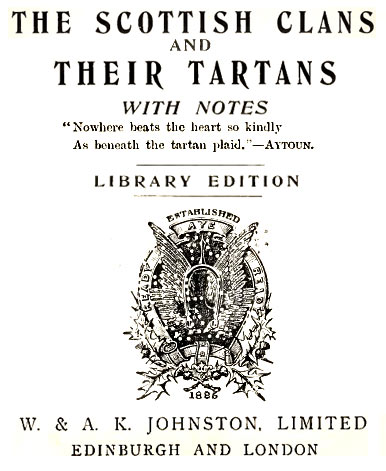 MACFARLANE
ROOTS MACFARLANE
ROOTS
THE CLAN MACFARLANE
The Tartan pattern used for the background of this page
is the tartan of the Macfarlane clan found in "The
Scottish Clans and their Tartans" published in 1886.
The
MacFarlane ancestral homeland is located in the
highlands of Scotland between Loch Long and Loch Lomond,
having the same boundaries as the Parish of Arrochar.
For over five centuries this area was held by the Chiefs
of Clan MacFarlane and before them by their ancestors,
the Earls of Lennox.
Info and images from
"History of Clan MacFarlane" by James MacFarlane,
published under the auspices of the Clan MacFarlane
Society, 1922.
The history and traditions of the Clan
Macfarlane are amongst the most romantic and entrancing
of the folklore of the Scottish Highlands. The early
history of the Clan is so interlinked with that of the
ancient Earls of Lennox, from which the clan sprung, that the
story of one is practically that of the other, until the
extinction of the original house of Lennox, in the reign
of James the First of Scotland.
Similarly, when the title of Earl was
bestowed upon John Stewart, a close relationship was
maintained through almost the entire period of the Darnley
period of rule.*
The first Chief of MacFarlane was a son of
the second Earl of Lennox, and the second Chief cousin
and son-in-law of the fourth Earl, while the tenth Chief
of MacFarlane was a son-in-law of the first Darnley
Earl.

|
* |
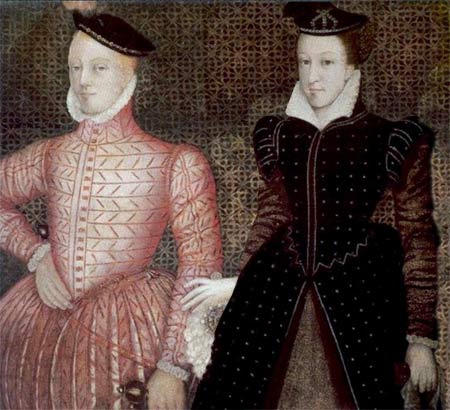 It
was in Feb. 1567 that the second husband of
Mary Queen of Scots, Henry Stuart, Lord
Darnley, was murdered in the middle of
Edinburgh. By all accounts it was to have
been a spectacular demise for the 21-year
old king, with the house he was staying in
was blown to bits by several sturdy barrels
of gunpowder. In the end his naked body was
found strangled in a nearby orchard, along
with that of his valet; they’d been caught
in attempting to escape the house and
quickly silenced. It
was in Feb. 1567 that the second husband of
Mary Queen of Scots, Henry Stuart, Lord
Darnley, was murdered in the middle of
Edinburgh. By all accounts it was to have
been a spectacular demise for the 21-year
old king, with the house he was staying in
was blown to bits by several sturdy barrels
of gunpowder. In the end his naked body was
found strangled in a nearby orchard, along
with that of his valet; they’d been caught
in attempting to escape the house and
quickly silenced.
Mary on the
left, Henry on the right. |
|
From The
History Press "The
Diabolical Death of Henry, Lord Darnley" |
| |
*Written
in 1816, 'MacGregor's Gathering'
is one of Sir Walter Scott's (1771-1832)
most famous poems.
This song
harks back to the time that the name
MacGregor was banned (1603), indeed in
1613 by Act of Council, MacGregors faced
the death penalty if discovered in
groups greater than four. ‘Grigalach’
was the Clan’s war cry as well as this
song of defiance, Sir Walter Scott
through his novel ‘Rob Roy’ made the
Highland Freebooter and outlaw Rob Roy
MacGregor known world-wide. (From
ElectricScotland.com)
The moon's
on the lake and the mist's on the brae
And the clan has a name that is nameless
by day
Then gather, gather, gather Grigalach!
Gather, gather, gather Grigalach!
Our signal
for fight, that from monarchs we drew,
Must be heard but by night in our
vengeful haloo!
Then haloo, Grigalach! haloo, Grigalach!
Haloo, haloo, haloo, Grigalach!
Glen
Orchy's proud mountains, Coalchuirn and
her towers,
Glenstrae and Glenlyon no longer are
ours;
We're landless, landless, landless,
Grigalach!
Landless, landless, landless, Grigalach!
But doom'd
and devoted by vassal and lord,
MacGregor has still both his heart and
his sword!
Then courage, courage, courage,
Grigalach!
Courage, courage, courage, Grigalach!
If they
rob us of name, and pursue us with
beagles,
Give their roofs to the flame, and their
flesh to the eagles!
Then vengeance, vengeance, vengeance,
Grigalach!
Vengeance, vengeance, vengeance,
Grigalach!
While
there's leaves in the forest, and foam
on the river,
MacGregor despite them, shall flourish
for ever!
Come then Grigalach, come then Grigalach,
Come then, come then, come then
Grigalach!
Through
the depths of Loch Katrine the steed
shall career,
O'er the peak of Ben Lomond the galley
shall steer,
The rocks of Craig-Royston like icicles
melt,
Ere our wrongs be forgot, or our
vengeance unfelt!
Then gather, gather, gather Grigalach!
Gather, gather, gather Grigalach! |
| |
|
The MacFarlane Clan occupied the
safe refuge of the Arrochar mountains for some six
hundred years. The Colquhouns were their traditional
enemies, while their friends and allies were "the clan
with a name that is nameless by day"*—the MacGregors.
They were generally not unfriendly with their neighbors
to the west, the Campbells. The principal castles or
houses of the chiefs were at Ardleish, Inveruglas,
island Vow, and Arrochar. Along with Clan
Donnachaidh (Robertson), the MacFarlanes are said to
have been the earliest of the clans to hold their lands
by feudal charter. Robertson and MacFarlane possess
another conjoint distinction in that they are the only
clans to bear the Royal Crown of Scotland in their
crests.
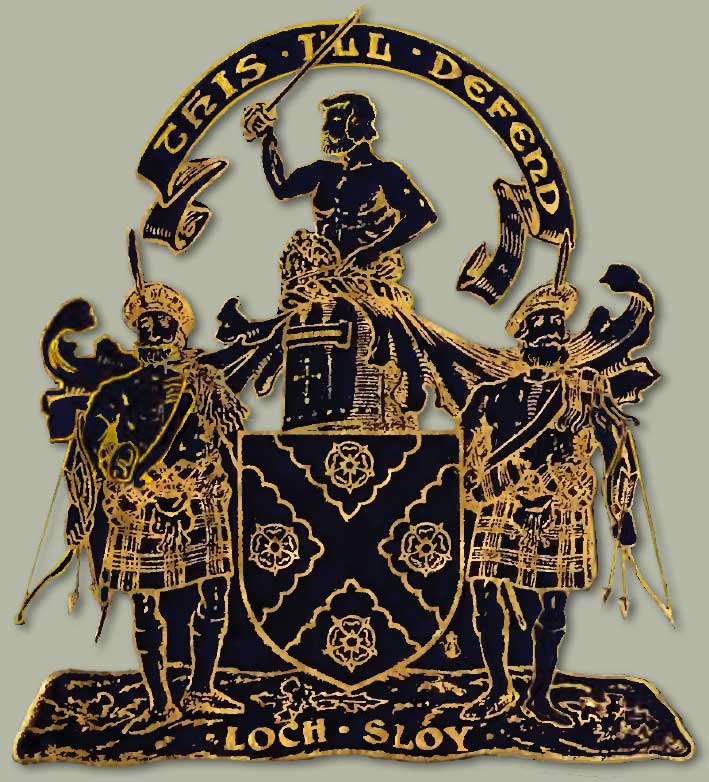 The MacFarlanes of Arrochar, according to the
language of the times, were amongst the families of good
account in the Lennox, in the period between the I2th
and 14th centuries, and took a greater or less share in
the important events transacted in that district. The MacFarlanes of Arrochar, according to the
language of the times, were amongst the families of good
account in the Lennox, in the period between the I2th
and 14th centuries, and took a greater or less share in
the important events transacted in that district.
Concerning the six great baronies or
maarmarships of the Highlands—Gallgael, Moray, Ross,
Garmoran, Caithness and Ness:
"In the Gallgael
maarmarship we have the five great clans of Cuinn,
Gillevray, Eachern, Donnachie, and Pharlane."
Thus the house is amongst the most ancient. The name has
been variously spelled, from time to time, MacPharlane,
MacPharline, MacFarlin, MacFarlane, MacFarland, and
MacFarlan.
The Gaelic rendering is Parlanach, from
early Irish, Partholan, and in Latin, Bartholomew. It is stated that the MacFarlanes once owned six large estates besides
Arrochar, which, itself, contains 31,000 acres. They
intermarried with some of the noblest of the families of
Scotland, such as those of Livingstone, Glencairn,
Stewart of Ochiltree, and others.
Earls of Lennox, Scottish Rulers
Alwyn the 2nd Earl, reign of Alexander
II, 1214-1239 and Malduin the 3rd Earl, reign of
Alexander III., 1249-1286, and Gilchrist, the founder of the family of
Mac Farlane, was either the fourth or fifth son of Alwyn,
the second Earl of Lennox. From his brother, Earl Malduin,
he obtained for his patrimony, the lands and barony of Arrochar in the upper part of the earldom of Lennox, as
is shown by the following extract from the original
charter:
"The lands of Upper Arrochar down from Luss,
lying between the small brooks which are called Aldyvach
and Oldquchulin on one side and the small brooks which
are called Hernan Kings and Trostan on the other side,
together with the islands of Elanvow, Elanvanow,
Elanrouglas and Elaig."
This charter bears no date, but
was granted in the reign of King Alexander II., between
1225 and 1239, probably in the first mentioned year,
upon Malduin becoming Earl of Lennox by the death of his
father, Alwyn. The terms of this charter were
subsequently confirmed in a similar document granted to
John, the seventh Chief of MacFarlane, on 13th February,
1420,under the Great Seal of King James I. of Scotland.
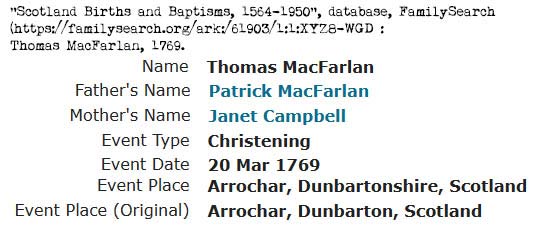 THE ORIGIN OF THE TAMPA MACFARLANES THE ORIGIN OF THE TAMPA MACFARLANES
Based on some info
from "History of
the Clan Macfarlane" by Mrs. C. M. Little, pub.
1894. (with
details from later sources added.)
The
Macfarlanes of Tampa derive their descent from Thomas(1)
Macfarlan, a "Heilanman" (Highlands man) of
Arrochar, Scotland, who at a young age settled at Pollokshaws,
just south of Glasgow around the year 1780.
In 1894, [when this source was published] many of his
direct descendants still lived there, and were people of some
influence.
|
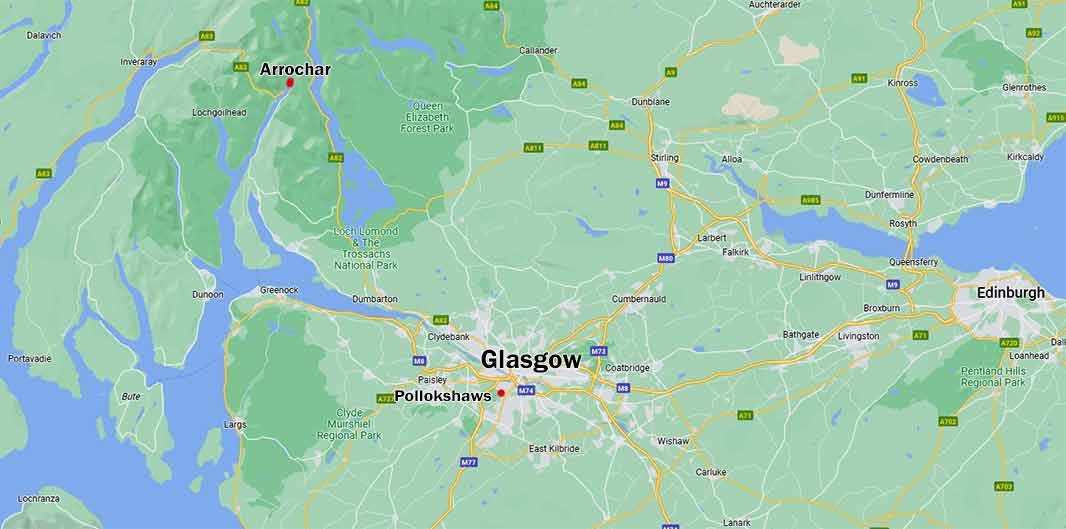
| Pollokshaws was originally a
village predominantly dedicated to weaving in the 17th century. A group
of Flemish weavers were brought to the area in the 19th century by the
landowners, the Maxwells of Pollok, on account of their
exceptional weaving skills. Pollokshaws was granted a
charter to become a Burgh of Barony in 1812. It
became a police burgh in 1858 and remained a burgh of
Renfrewshire until 1912 when it was annexed to the City
of Glasgow.
|
|
|
POLLOKSHAWS AREA IN 1858
Near the time the Macfarlanes left Scotland for America.
At various times in Hugh
Macfarlane's life in Tampa, the press has published his
birth place as "near Glasgow", Pollockshaws, Langside, and
Crossmyloof. These three towns are within about a
half-mile of each other and about 2 1/2 miles south of
Glasgow around the time Hugh was born.
Courtesy of National Library of
Scotland:
Renfrewshire, Sheet XIII Survey date: 1858, Publication
date: 1863
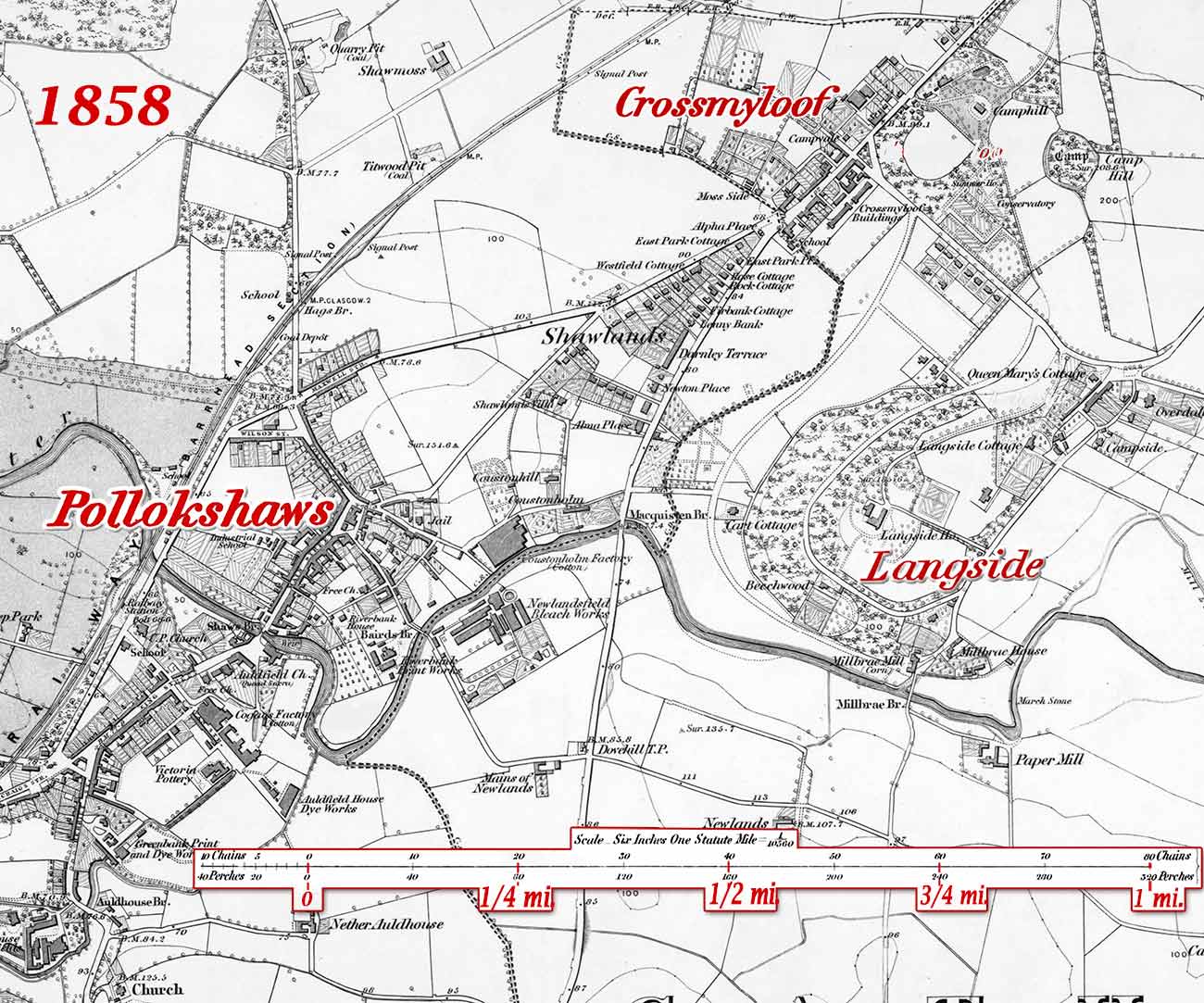
These towns were about 2 1/2 miles from Glasgow in those
days.
Today they are all part of Glasgow.
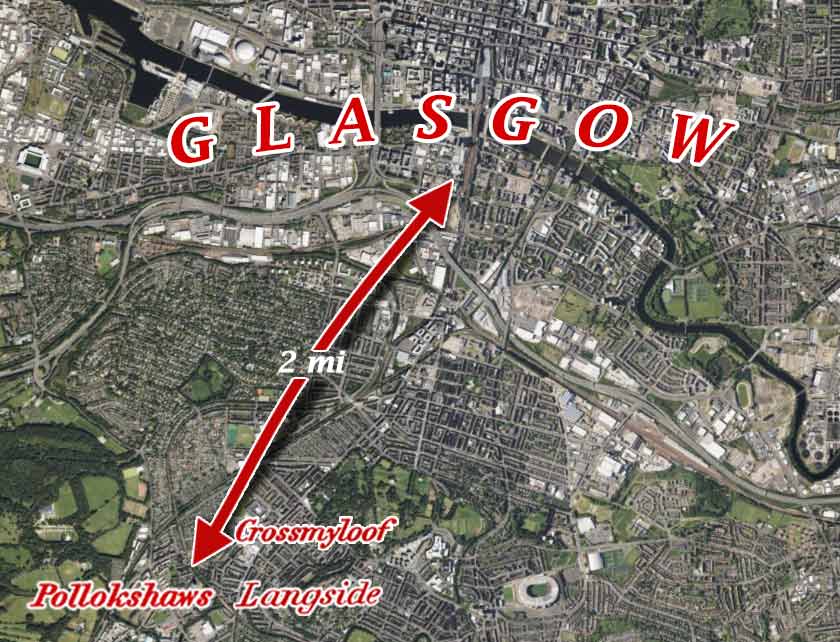
|
Thomas1 Macfarlan(e) of Arrochar married Margaret Walker
in Eastwood, Renfrew, Scotland on Aug 18, 1798.
OF
FOUR SONS OF THOMAS
MACFARLANE1 of ARROCHAR and wife MARGARET WALKER,
TWO SONS CAME TO NORTH AMERICA,
GRANDSONS THROUGH TWO OTHER SONS ALSO CAME.
|
|
Thomas2 Macfarlane
was born in 1799 in Renfrew, Scotland and was a son of Thomas1 of Arrochar and wife Margaret
Walker. Thomas2 was married to Catherine McAlpine in Refrewshire
in 1826 and for lack of information about
them, it is assumed they remained
in Scotland.
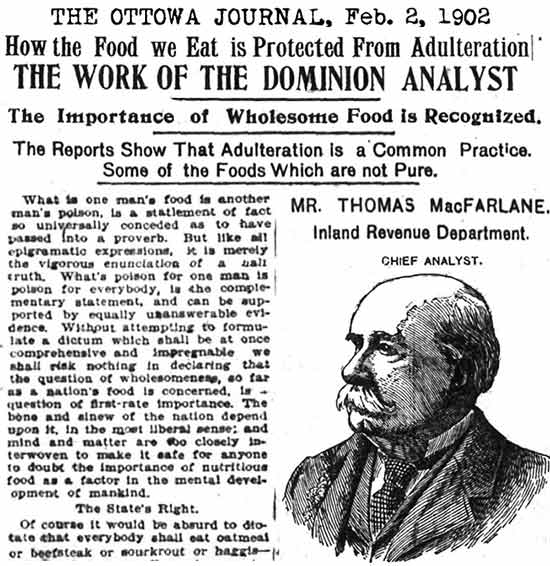 The younger of
their sons, Thomas(3A) Macfarlane
was born
in 1834 in Renfrewshire, Scotland.
He married Margaret Skelly (b. Ireland) in Scotland in 1858
and
after having spent several years in Norway
as director of chemical works, they came to Canada in the mid-1860s
Thomas3A was a chemist and manager
of mines when he took a job on the 1866 geological
survey of Canada. One of his most remarkable
achievements at this time was the discovery of the
celebrated "Silver Inlet" in Lake Superior, one of the
richest deposits of silver in the world at the time.
Thomas3, who resided in Ottawa, Canada, was appointed
Dominion Analyst of the Canadian Government in 1886, and
became a trusted authority in food purity testing and
chemistry, having published several scientific works.
Later he held important government positions in Canada. The younger of
their sons, Thomas(3A) Macfarlane
was born
in 1834 in Renfrewshire, Scotland.
He married Margaret Skelly (b. Ireland) in Scotland in 1858
and
after having spent several years in Norway
as director of chemical works, they came to Canada in the mid-1860s
Thomas3A was a chemist and manager
of mines when he took a job on the 1866 geological
survey of Canada. One of his most remarkable
achievements at this time was the discovery of the
celebrated "Silver Inlet" in Lake Superior, one of the
richest deposits of silver in the world at the time.
Thomas3, who resided in Ottawa, Canada, was appointed
Dominion Analyst of the Canadian Government in 1886, and
became a trusted authority in food purity testing and
chemistry, having published several scientific works.
Later he held important government positions in Canada.
According to Mrs. Little's book,
Thomas3A & Margaret's two sons, Norman and Arthur,*
were merchants in Tampa. Thomas3A's lengthy obit in the Ottawa Citizen on Jun. 11,
1907, names surviving sons Arthur and Thomas4 in Ottawa,
and Worrie in Montreal. Then names four daughters by
their husband's names in Canada, and one daughter "Miss
Macfarlane" of Ottawa.
See his obit.
*No evidence of an Arthur Macfarlane
of this period has been found in Tampa. Thomas3A and Margaret's 1871 and 1881
Censuses in Quebec, Can. show their children as Norman (b.1860),
Cashemire/Catherine (b.1862),
Margaret/Marguereta (b.1864), Hock/Thomas4.1 (b. 1866),
Jessie (b. 1869), and A.C./Arthur (b1871). The
1881 Census shows Thomas3A was a geologist, born in
Scotland, wife Marguereta born in Ireland, and their
oldest son Norman born in Scotland. The rest
of their children were born in Quebec.
|
|
Parlan/Parlin/Parlane Macfarlane,
Born 1801 in Renfrewshire, Scotland, he was a son of Thomas1 of Arrochar
and wife Margaret Walker. Parlan
emigrated to America sometime in the 1820s and was for
many years an Indian trader in the Northwest territory,
and one of the pioneers of St. Paul and St. Anthony,
Minnesota. He was well and favorably known in that
entire section during his lifetime, and is was
remembered by the old settlers of Minnesota (1894). He
married Catherine Garman in Michigan in
1843. On
the 1865 Census of Hennepin, St. Anthony, Minn., he and
his wife Catherine had three sons. No ages
were recorded on this census.
Thomas(3B) Campbell
Macfarlane
(b.1843 Detroit, MI ) was the eldest
son of Parlan and resided near Sauk Center. More about
his wife and children are presented later. Parlan and wife Catherine's
second son, John, resided at Minneapolis.
There was a third son, Joseph. Parlan died Mar. 13,
1875 in Stearns Co, Minn.
|
|
Andrew Macfarlane,
born 1805,
in Renfrewshire, Scotland, son
of Thomas1 of Arrochar and Margaret Walker, has no history
in Mrs. Little's book except that he had only one son,
George Rae Macfarlane.
George Rae Macfarlane, son of
Andrew Macfarlane and Margaret Rae,
was born in
Scotland on May 21, 1861 and immigrated to America
in 1886. After living and working in New York for
about a year, he came to Tampa
in 1887 because his cousins Hugh, David and
Matthew lived here. Upon arriving in
Tampa, George invested his means in land and managed
the Florida Real Estate and Loan Corp. He quickly
became identified with every interest of the city,
including Tampa's Fire Chief.
See more details of George R.
Macfarlane at "THE MACFARLANES IN TAMPA"
|
|
James Dick Macfarlane., born June
2, 1822
Renfrewshire, Scotland, son of
Thomas1 of Arrochar and Margaret Walker. (Before
James was born, Thomas1
and Margaret had a daughter, Mary, born 1811 and a son
William Peacock b. 1814.)
James married Anna
Campbell in Lanarkshire, Renfrew, Scotland on Oct.
4, 1845. Anna was born July 5, 1822 in Eastwood,
Renfrew, Scotland and was a daughter of Hugh Campbell2
and Mary Archibald. Hugh Campbell2 was a son of
Hugh Campbell1 and Elizabeth Burnsided.
THE CLAN OF CAMPBELL
Info and image below from:
The National Scot: Clan Campbell
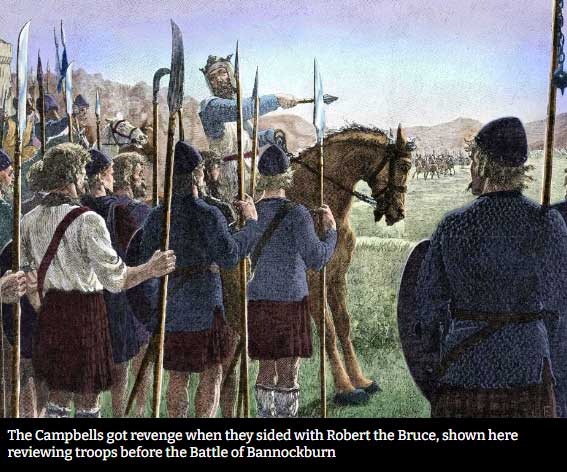 The
Campbell Clan was conspicuous during the reign of
the Stewarts, and afterwards, the mightiest and most
influential of the Highland clans for centuries.
Described by John and Julia Keay in their
Encyclopedia of Scotland as “not perhaps the most
popular Highland clan,” the Campbells have been at
the forefront of Scottish affairs for more than 600
years and have succeeded down the centuries by
having the remarkable attribute of being on the
winning side most of the time, albeit the clan
suffered grievous damage during some periods. The
Campbell Clan was conspicuous during the reign of
the Stewarts, and afterwards, the mightiest and most
influential of the Highland clans for centuries.
Described by John and Julia Keay in their
Encyclopedia of Scotland as “not perhaps the most
popular Highland clan,” the Campbells have been at
the forefront of Scottish affairs for more than 600
years and have succeeded down the centuries by
having the remarkable attribute of being on the
winning side most of the time, albeit the clan
suffered grievous damage during some periods.
One terrible atrocity has tainted
the Campbell name. The Massacre of Glencoe in 1692
is nearly always viewed as a Campbell war crime
against their great rivals the MacDonalds, but it
was more of a state persecution than a clannish
slaughter.
The Campbell origins are the stuff
of legend, and they have to be legendary and even
mythical because as always with Scottish history
there are precious few written records that survive
from before the reign of Robert the Bruce in the
early 14th century. A plausible origin of the
Campbells in Dumbarton and surrounding area, as they
may have been originally a Brythonic people and
Dumbarton was, of course, the ancient capital of the
Brythonic kingdom of Strathclyde. “According to
legend, here in An Talla Dearg, the Red Hall of Dun
Briton, was born the first ancestor of the Campbells
who appears in all three of the early Gaelic
genealogies, Smervie or Mervyn, son of an Arthur,
who became known as ‘the Wildman of the Woods’,
perhaps being a notable hunter. If the legend is
based upon a real character, he likely lived in the
11th or 12th century. However, those names at that
period can have absolutely no actual connection with
the legendary Arthur, whose possible existence is
said to have been many centuries earlier.”
JAMES MACFARLANE AND ANNA CAMPBELL MACFARLANE IN POLLOKSHAWS
| |
CHILDREN OF JAMES D. MACFARLANE & WIFE
ANNA CAMPBELL |
BORN |
BIRTH PLACE |
DIED |
DEATH PLACE |
|
1 |
Mary Macfarlane
(Brown) |
10 Feb 1846 |
Renfrew, Scotland |
26 Feb 1932 |
Fall River, Bristol Co., Mass. |
|
2 |
Margaret Elizabeth
Macfarlane (Macfarlane) |
9 Dec 1850 |
Renfrew, Scotland |
6 Oct 1916 |
Getty, Stearns Co., Minn. |
|
3 |
Hugh Campbell Macfarlane |
28 Dec 1851 |
Renfrew, Scotland |
7 Jan 1935 |
Tampa, Fla. |
|
NO |
Wilhelmina
Macfarland* |
20 Jul 1853 |
Cuddalore, Madras, India |
13 Aug 1853 |
Madras, India |
|
4 |
Jeanette Dick Macfarlane
(Lockhart) |
19 Nov 1854 |
Renfrew, Scotland |
25 Nov 1930 |
Tampa, Fla. |
|
5 |
David Stewart Macfarlane |
31 May 1857 |
ReRenfrew, Scotland |
15 Jan 1913 |
Edmonton, Can. |
|
6 |
Annie Macfarlane
(Burnside) |
22 Jun 1859 |
Renfrew, Scotland |
2 Oct 1933 |
Pawtucket, RI |
|
7 |
Matthew Biggar Macfarlane |
20 Mar 1861 |
Renfrew, Scotland |
21 Jul 1924 |
Tampa, Fla. |
|
8 |
Elizabeth Macfarlane** |
6 Oct 1863 |
Glasgow, Scotland |
Before 1866 |
Scotland |
**Knowledge of Elizabeth comes from
Scotland Births and Baptisms, 1564-1950 at Familysearch.org. It is a transcription, not an
image of the original record. Born on Oct. 6, 1863
in what was then Tradeston, Glasgow, Lanark,
Scotland, now Glasgow, Lanarkshire, Scotland, UK.
It indicates her parents were "James McFarlane and
Ann Campbell." It is assumed she died before
Oct. 1865 in Scotland due to her absence on the
Macfarlane's ship passenger record.
*The Protestant Church
birth and baptism records of
Madras, India "India, Births and Baptisms,
1786-1947" and burials in Cochin in 1853 list Wilhelmina
Macfarland's death and her burial the next
day, "daughter of James and Anna Macfarland."
She died of herpes at 24 days old. James and Anna
being such common names this is most likely not our Macfarlanes,
especially since the spelling of Wilhelmina's surname is
consistently "MacFarland" for her and her parents names
on her birth, baptism, death and burial records. The 1900 Census of Fall River, Mass.
shows that Anna (Campbell) Macfarlane
was the mother of nine children, seven still living,
which leaves the door open for Wilhelmina.
But Anna's 1907 obituary does not
mention any time India. Also, the name "Wilhelmina" is
so out of character with all Macfarlane family names,
it is more German than anything else. Their
other children, Mary,
Margaret and Hugh would have been around ages 7, 3
and less than 2 (Hugh) in 1853.
The United
Kingdom, British India Office of Births and Baptisms
also lists Wilhelmina Macfarland born Jul. 20, 1853, baptized
Aug. 8, 1853, in Madras Presidency, India, daughter
of James and Anna Macfarland. But there are some
Familysearch.org users that
include Wilhelmina as a daughter in this family on
the James D. Macfarlane family tree at this site.
These amateur users miss the fact that Wilhelmina's
baptism record indicates that James was a drummer in the
45th Regiment of the Madras Native Infantry (MNI)
Proof that this James MacFarland was a native of India.

|
|
|
JAMES D.
MACFARLANE & FAMILY COME TO AMERICA
The Macfarlanes
came to
America from Glasgow on the S.S Caledonia
arriving at the Port of New York on Oct. 16 1865
THE S.S. CALEDONIA OF
1865
Photo courtesy of "Sailing
to America: Peter & William at Sea"
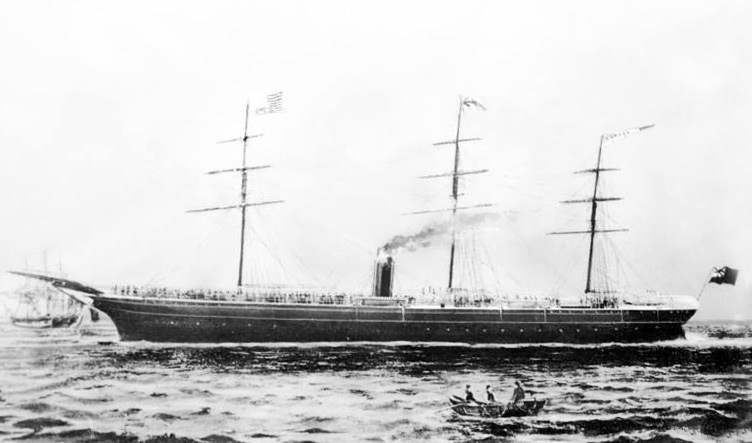
The direct route would
have taken about two weeks to three weeks, depending on the
weather.
S.S. Caledonia
Passenger Manifest
Arr. Port of New York Oct 16, 1865 from Glasgow,
Scotland
The Macfarlanes traveled in Steerage Class.
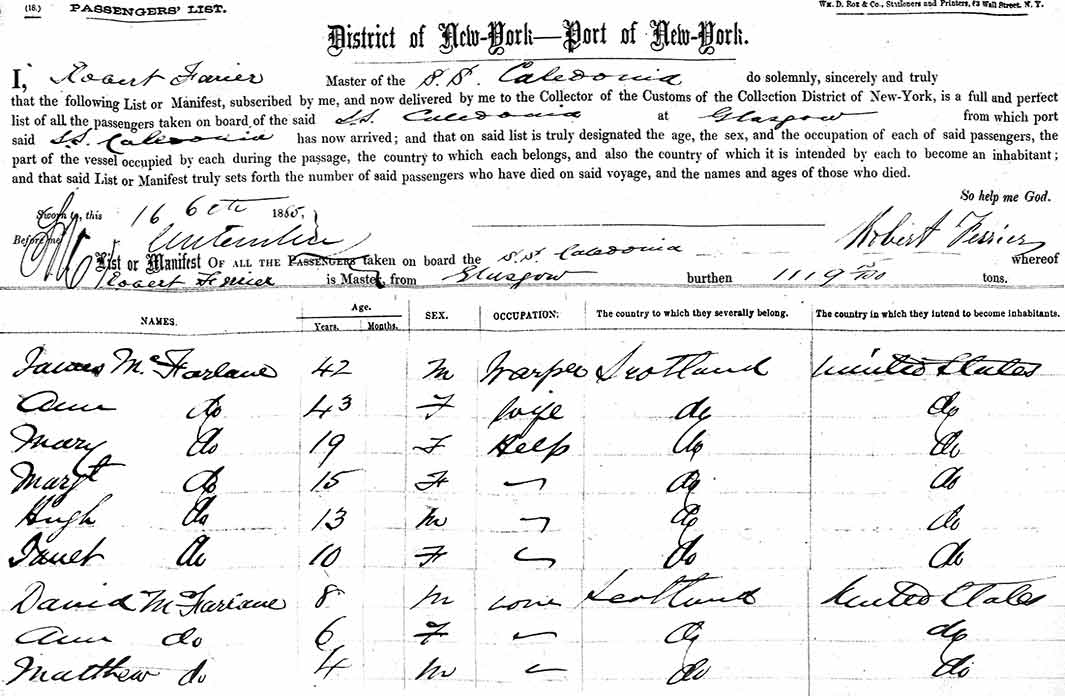 |
|
On the original manifest, David, Ann and Matthew were at the top of
the next page so this has been rearranged to better fit
this space. "do" means "ditto." Notice the writer
writes his "c" like a superscript, up high at the top
of the "F" making it look like "M" was his middle
initial.
James's occupation was
"Warper."
A warper or a warp beamer was a textile
mill worker who arranged the individual yarns or threads which
created the "warp" of the fabric upon a large cylinder
called a beam. ( "Dictionary
of Old Occupations.")
Listed after James was his wife, Anna, and their
children Mary, Marg't (Margaret) Hugh, Janet (Jeanette),
David, Anne, and Matthew.
After the Civil War, the need for
quickly producing cotton fabric in the North could have
been a high priority, and the need may have been known
around the world for their needed skills in the northern U.S. textile
mills.
Nothing is yet known as to how long the
Macfarlanes were in New York after arriving on Oct. 16,
1865. Evidence shows they first lived
in Fall River, Mass. where James took a job at a local
textile mill. They did not
arrive in time to be listed on the 1865 State Census of
Massachusetts. To this time, no information about
the Macfarlanes in Fall River from 1865 to 1868 has been
found.
|
|
THE
MACFARLANES BEFORE TAMPA
Some facts from records of
the period of the events revealed in this
feature differ from the current
generally accepted "story" of Hugh Macfarlane.
Where no
other sources could be found to validate events, Hugh's
pre-Tampa history is from the 1979 SUNLAND TRIBUNE'S
"Hugh
MacFarlane: West Tampa Pioneer" by DR. GLENN WESTFALL, Department of
History, Hillsborough Community College,
found at USF Digital Commons
CLUES FOUND IN HUGH
MACFARLANE'S APPLICATION FOR PASSPORT, July 1, 1909
-ADMISSIONS & OMISSIONS.
On his
application for passport on July 1, 1909 in Tampa, Hugh
stated that he was born December 28, 1851 near Glasgow,
Scotland, and came to America "on or about" Sept. 1865
on the S.S. Caledonia. As previously presented, he was not far off, and
it's probable that September is when the Caledonia
departed Glasgow. Hugh would have been a
couple of months shy of 14 years old at that time.
At various times in his adult life in Tampa,
the press has published his birth place as Pollockshaws, Langside, and Crossmyloof.
These towns are all within a half-mile of
each other and about 2 1/2 miles south of
Glasgow around the time Hugh was born.
Hugh stated he resided continuously in the USA since his
arrival, and names Fall River, Mass.; Stearns Co., Minn;
and Tampa, Florida.**
He doesn't mention any time spent living in New York
City, which supports the assumption that they didn't live
there or he didn't remember this.
 |
|
See his whole application
(with blanks removed.)
It gives a description of Hugh, and it witnessed by
attorney William Frazer Himes who attests he has known
Hugh for ten years.
|
**JUMPING
AHEAD
The often
repeated history and generally accepted
background of Hugh Macfarlane we have today
makes mention that before coming to Tampa in
1884 "as an experienced lawyer," he
lived in New Orleans. His passport application
doesn't support this and it might be because
he ran out of room. In a
1905 reporter's interview with him and his
two brothers, David mentions New Orleans was
where his brother lived before coming to
Tampa. |
THE
MACFARLANES SETTLED IN FALL RIVER FOR AS MANY AS FIVE
YEARS
According
to evidence from Macfarlane and related families censuses, newspaper
articles, obituaries, city directories, and other official records
such as birth, marriage and death records, the Macfarlanes first
lived in Fall
River, Mass. where Hugh's father, James D. Macfarlane,
continued his textile industry related occupation from
Scotland by working as a "dressertender."
No Massachusetts record of them before 1868 has been
located to this time.
|
City directories did not name
minor children living in their
parents' home, but many
directories in later decades
often listed the spouse's name.
The publication date indicates
they lived here in 1868.
|
|
James was the
only Macfarlane listed in Fall
River.
 |
|
A
dresser tender
was someone who operated a machine
that prepared
threads for weaving in the textile industry. |
|
FALL
RIVER DAILY EVENING NEWS, Apr.
15, 1905 - "ARE LEADERS IN
FLORIDA"
The article named above is an
important source of information
for this feature. It was
written by a reporter who
apparently interviewed the
Macfarlane brothers at length when
they went back to Fall River from Tampa to visit their mother who was ill
in 1905.
It presents information
presumably as told
by the Macfarlane brothers to
the best of their memory (and of
course, to the best of the
reporter's ability to listen and
take legible notes.)
The article
briefly discusses the
period from the Macfarlane family's arrival in the U.S.
to the time the brothers went
their separate ways from Fall
River. It then goes on in
more detail about each of the brothers'
lives and successes to that
point in 1905.
Information footnoted by
a blue "3"
in this feature is based on the
information presented in this
article, which itself will be
presented later.
|
MARRIAGE OF MARY MACFARLANE (SISTER OF
HUGH) 1869
|
|
The Fall River
town marriage records show that on
July 13, 1869, Mary Macfarlane, daughter of James & Annie, married
William Brown, son of
John and Sarah Brown.* Mary was 21,
William was 24 and worked as a carpenter.
It was the first marriage for both of them.
This marriage is an excellent indicator
that the Macfarlanes still lived in Fall
River at this time. |
 |
|
Notice if Mary's age on her
passenger record is correct, she would have
been around 23 at this time.
*Remember the names of William's parents,
John & Sarah Brown, you'll see them again. |
 |
|
THE
MACFARLANES IN MINNESOTA BY JUNE 1, 1870
Sometime after the
marriage of their daughter in July 1869 but before
the time of the 1870 U.S. Census in June, (a period
of about 11 months) the Macfarlanes moved to Minnesota
because James wanted to "try his hand at farming."3
The move was no doubt influenced by the presence of
James' brother (Parlan) living there with his family.
|
3. This same 1905
newspaper interview
claims that James was a baker around the
time he tried farming. The Jan.
1, 1869 Fall River city directory
presented earlier indicates he continued in
Fall River in the same line of work he was
in while in Scotland. Could he have
been a baker before 1869?
Possibly, but not likely.
He lived in a town in Scotland founded
primarily by the cotton mill industry, left
Scotland as a worker in a textile mill with
his entire family on a three week voyage
across the Atlantic in the fall of 1865 to settle in a town that
was dominated by cotton mill industry, and
with eight family members and himself, there
was very likely many opportunities in the
cotton mill industry for James. TampaPix is not convinced he would take a job or start a business as a
baker. At least, not in Fall River.
But read on. |
1870 CENSUS,
RAYMOND, STEARNS COUNTY, MINNESOTA
It is important to note at this time that this "town of
Raymond" in Stearns County was in the Raymond TOWNSHIP.
Raymond Township was organized in 1867, and named for
Liberty B. Raymond, a pioneer settler. It should
not be confused with Raymond in nearby Kandiyohi County
about 100 miles west of St. Paul. This Raymond was
platted in 1887, and named for Raymond Spicer, the son
of a first settler.
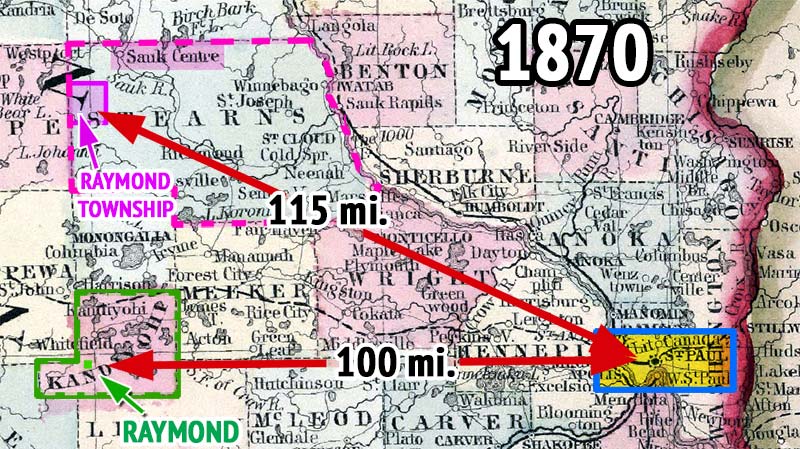
1870 Minnesota county map courtesy of ArcGIS James
and his family, along with William Brown and his wife Mary Macfarlane Brown
all lived in the township of Raymond, Stearns
Co., Minnesota, near Sauk Center, about 115
miles north-northwest of St. Paul. The choice of this
location may have been for James to be near his older brother, Parlan Macfarlane,
who would have been around 69 at this time. Parlan
was a farmer and
settled in this area with his family decades earlier.
It is said (according to Mrs. Little's book) that Parlan came to America in the late 1820s, was a trader
with the Indians in the then-Northwest Territory and an
early pioneer in the St. Paul - St. Anthony area.
At least one son of Parlan lived in Stearns County.
So why
did the 1870 Census show
James worked in a cotton mill? Because it's
true, past tense--it shows "WORKED." The Macfarlanes probably
just arrived and James had yet to
"try his hand" at farming. Rather than put "NONE"
for occupation, his previous line of work was recorded.
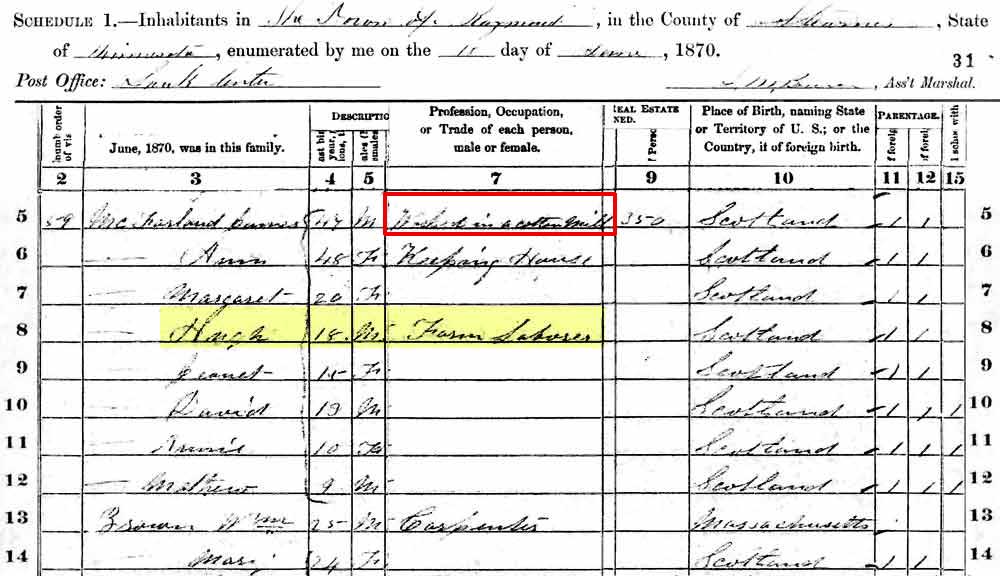
Mary
(Macfarlane) Brown is seen here on line 14, married to
Wm. Brown. Mary is 24. So Mary went from age 21 at
marriage to age 24 in just 11 months. Since Mary's
immigration age and her 1870 age are consistent,
it is sufficient to believe she was 23 when she married.
|
No record of
James Macfarlane ever being a
farmer or a baker has been
located. But they could
have been two occupations he
attempted in Minnesota;
there is some compelling
historical and geographical
evidence for James being a
farmer in Minnesota:
#1 REASON:
THERE WAS NO TEXTILE MILL
INDUSTRY IN STEARNS COUNTY.
It was a farming area.
From the Stearns County, MN
website:
The first large influx of
immigrants, most of German
Catholic descent, began to
arrive in the 1850s and settled in St. Cloud while
others settled in St. Wendel,
St. Joseph, St. Augusta,
Wakefield and Collegeville
townships.
Early arrivals came from
eastern states as well as
directly from Germany. There
were craftsmen who
pursued their former
occupations, but the majority
were farmers. Because
wheat and other cash crops
thrived in the rich Central
Minnesota soil, the county's
reputation for good farmland
spread quickly, and by the
beginning of the 20th century
the county's population had
grown to 44,464.
From Stearns County, MN
Genealogy & History:
Stearns
County
This county, established
February 20, 1855, was named for
Hon. Charles Thomas Stearns,
member of the council of the
Territorial Legislature, 1854
and 1855. The name, however, was
decided by a mistake, told
in the "History of the Upper
Mississippi Valley," as follows:
"The bill, as originally
introduced, both the name of
Stevens county, in honor of
Governor Stevens, then
prominently connected with the
survey of the Northern Pacific
railroad and passed both
branches of the Legislature n
that shape; but in the
enrollment of the bill the
change occurred from Stevens to
Stearns, and when discovered, it
was concluded best to let the
matter stand, as the name was
still in the line of honorable
mention, and Mr. Stearns well
entitled to public recognition
in this way."
GETTY
township was organized in
1865. "John J. Getty, in honor
of whom the town is named, was
undoubtedly the first permanent
settler. He came on the 6th of
July, 1857, and settled on
section nineteen, in what has
since been known as Getty's
Grove." (History, Upper
Mississippi, p. 416.) He was
born in Onondaga county, N. Y.,
September 15, 1821.
RAYMOND
township, settled in 1860,
but deserted from 1862 to 1866,
was organized in 1867, being
named in honor of Liberty B.
Raymond, one of its early
settlers.
There is no evidence of cotton
mill industry in the history of
Stearns County. In fact,
some specific historical
biographies mention men who
worked in the cotton mill
industries of Massachusetts who
moved to Stearns County and
became farmers.
|
|
|
MARRIAGE OF MARGARET
"MAGGIE" MACFARLANE (HUGH'S SISTER) IN MINNESOTA
On Dec. 26, 1873 in
Getty, Stearns Co, Minn., James & Annie's next
oldest daughter, Margaret Elizabeth "Maggie"
Macfarlane, married Thomas(3B) Campbell Macfarlane,
(b.1843 Detroit, MI) a son
of Parlan Macfarlane.
Their marriage license gives no other useful
information, not even their ages or that they were first
cousins. The Justice of the Peace who married them
made an error on his certification of when he performed
the marriage. He wrote Dec. 26, 1874 instead of
Dec. 26, 1873.
Looking at other marriages in the book it can be seen
that they were issued the licenses in consecutive order by dates in Dec. 1873, but the actual date of marriages was often in January the following
year. The J.O.P. filled in the
certification with the correct month and day of the
marriages of 1874, and
so wrote 1874 not noticing they had married the previous
month (and year). Why would a couple
wait a whole year to marry after applying for their marriage
license in Dec. 1873? Also, no license is valid
for a year before the marriage. Margaret and Thomas
would have both been over 21 in Dec. 1873.
The 1900 census finds
Thomas3B and Maggie with nine
children in Getty, Stearns Co, Minn. Their children were
Charles G. (1875), Anne Louise (1876), Thomas P. (1879),
Robert James D. (1880), John Arnold (1882),
Fred
Campbell (1884), Margaret "Maggie" (1885),
Matthew B. (1887), and Katherine J. (1890). All
the
children were born in Minnesota.
|
|
HUGH
MACFARLANE ATTENDS ST. JOHNS UNIVERSITY IN
MINNESOTA
Hugh
attended Saint John’s University at Sauk Center in
1873-1874 and may have also "taught school"3
while there. This could have been anything from tutoring school
children as a source of his own income to assisting
students at the university.

St. John's Students - M –
CSB+SJU
According
to Dr. Glen Westfall's "Hugh
MacFarlane: West Tampa Pioneer,"
after graduating from St. John's,
Hugh went
to Boston alone, but this doesn't really explain what
the rest of his family did.
DEATH OF
PARLAN MACFARLANE. STEARNS CO. MN, 1875
James's brother, Parlan
Macfarlane, died in Stearns County, Minn. in March 1875
at age 74. He may have been sick for quite a while
so James and family stayed around until after Parlan
died and probably after his affairs were in order.
MACFARLANES ON THE 1875
MINNESOTA STATE CENSUS
The 1875 State Census of Minnesota (Census date May 1)
shows definite proof that James and Anna, with their
youngest unmarried children, remained in Raymond after the death of Parlan,
James' brother. Hugh is not present, having left
for Boston; he would have been 24 years old.
1875 State Census of Minnesota, town of Raymond,
Stearns County.


This census did not record occupations. He very
well could have been a farmer.
|
|
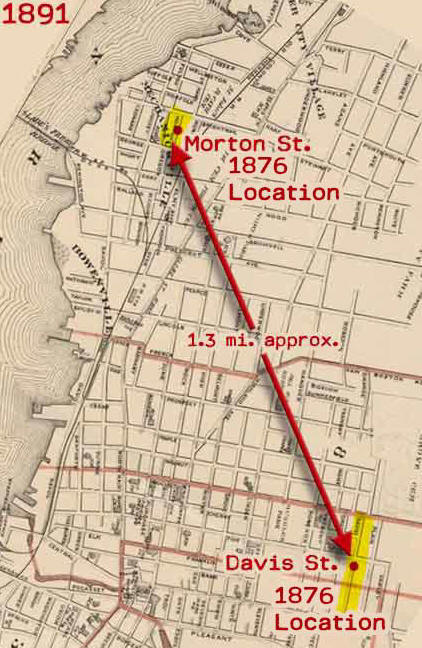
THE
MACFARLANES BACK IN FALL RIVER
The 1876 Fall River City Directory shows
TWO James McFarlanes as weavers, one at a boarding house at
32 Morton, and one on
Davis St. It's probable that James, Hugh's father,
is the one living in a house at 34 Davis St.
James' career as a farmer was over.

So which one is James D.
Macfarlane? Probably both are one in the same.
Having just arrived back in Fall River, they may have
first lived in a boarding house before finding a home.
These locations are about 1.3 miles apart.
1891 Map courtesy of the David Rumsey Map
Collection.
(Rotated 120 degrees clockwise so north is
at top.) |
| |
|
HUGH MACFARLANE IN BOSTON AND FALL RIVER
Newspaper reporter in Boston and law student at Boston University
|
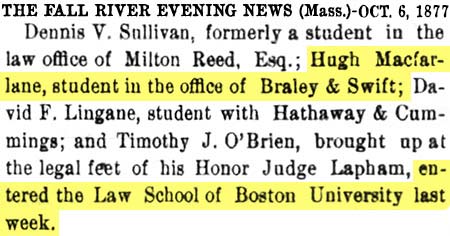
In these
times, a law student would take a position in a law
firm, "reading the law" and being tutored by the firm's
lawyers. Today we call the position a "Law Clerk." |
According to
Dr. Westfall, after arriving in Boston, Hugh took a job
as a newspaper reporter.
In late Sept. of 1877, Hugh enrolled in
the Boston University school of law
and
was accepted as a law student
with the law office of Braley & Swift.
It is assumed Hugh received his law
degree by late 1878, since he was before the Superior Court
on Dec. 26, 1878, to apply for admission to this court.
If no objection was made, he was to be admitted on Jan
1., 1879. It is assumed that he was found
qualified and admitted.
|
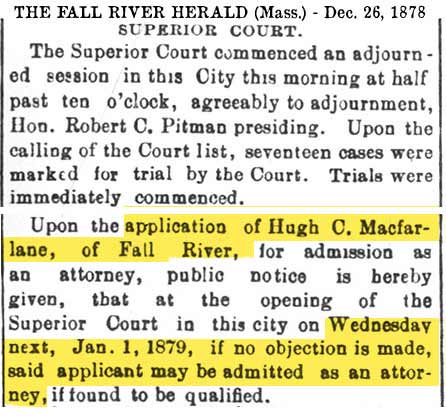 |
|
HUGH'S
BROTHER: DAVID S.
MACFARLANE MARRIAGE TO EMMA SIMMONS, FALL RIVER, Jan.
23, 1878
On Jan. 23,
1878, Hugh's brother, David S. Macfarlane,
married Emma A. Simmons, daughter of Andrew
S. Simmons and Mehetable Almy.**
David's occupation was "Carriage Man"
which was a carriage maker.
**Emma's
parents full names comes from her death
certificate of Sep. 1, 1936. Her marriage
record only shows "M" for her mother.
|
|
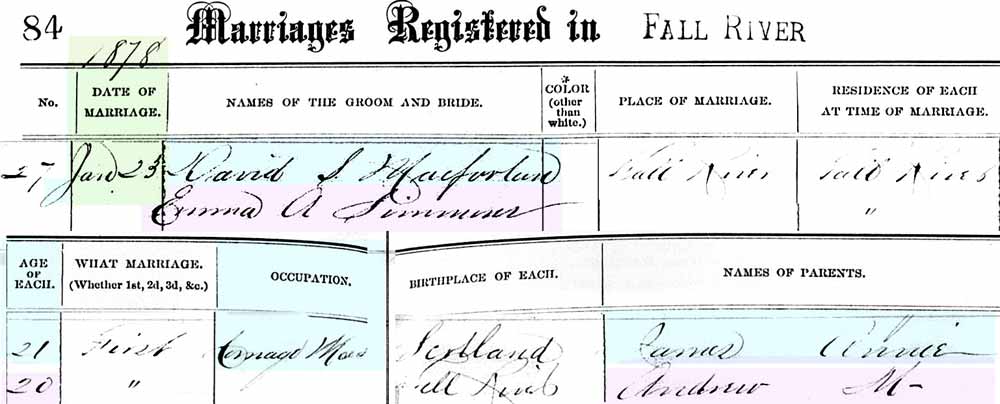
BIRTH OF DAVID & EMMA'S FIRST CHILD, ANNIE M.
MACFARLANE, 1878 IN FALL RIVER
The birth of their first child, Annie Margaret
Macfarlane, is recorded in the Fall River Clerk town
records. Born July 12, 1878 to David S. Macfarlane
of Scotland, and Emma born Fall
river. David's occupation was listed as a
"Wheelwright." This is a maker of wheels for carts
and carriages.

David and Emma had two more daughters in Fall River
after Annie, Sarah H. (1880) and Eliza
(1881) See further below. |
|
HUGH
MACFARLANE CIVIC CLUBS IN FALL RIVER |
|
Hugh was a member of the Caledonian Society
when on Jan. 25, 1879, he participated in
the club's celebration of the 120 yr.
anniversary of the Scottish poet Robert
Burns. |
Portrait of Robert
Burns by Alexander Nasmyth, 1787,
Scottish National Portrait Gallery,
courtesy of Wikipedia. |
Hugh was named Chief of the Caledonian
Society in early April 1879 and attended in
the club's meetings and events in the G.A.R.
Hall on Borden Block which celebrated
Scottish heritage |
|
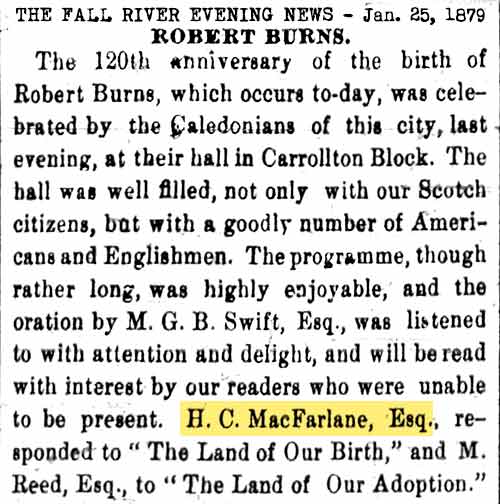 |
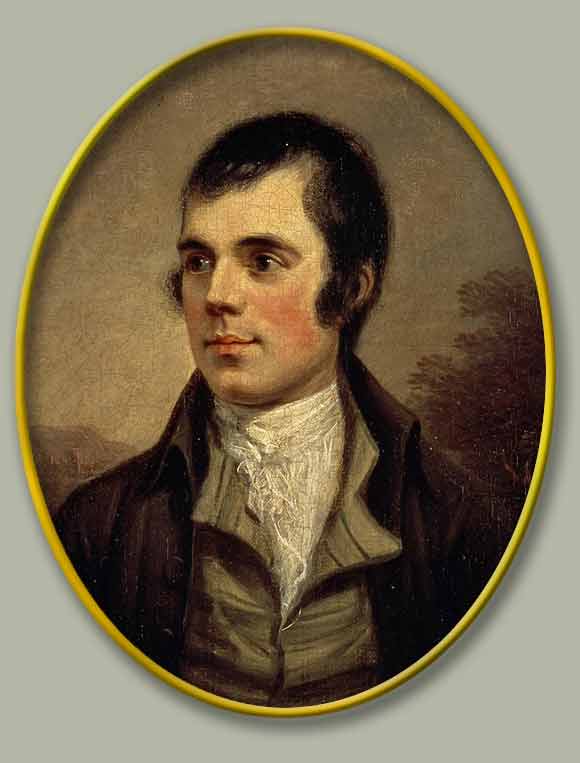
Burns' most well-known
work
is "Auld Lang Syne" |
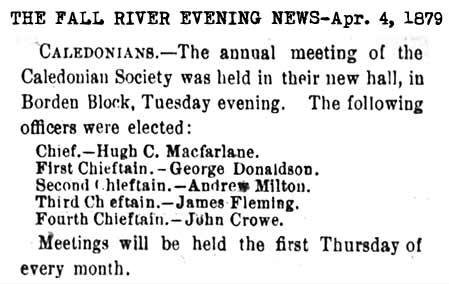 |
| HUGH MACFARLANE'S FIRST MARRIAGE
- SARAH A. BROWN 1879
Hugh married Sarah A.
Brown on Feb. 27,
1879 in Fall River. This state's vital records register records
her maiden name as "ROWEN" but the City
Clerk's register seen below shows
her name as "BOWEN." Later records
clearly show it was BROWN. Both registers state
her
parents' names were John & Sarah. Hugh indicated he was 26.
But he was born Dec 1851 and would have been 28 in Dec.
1879, so in Feb. he was 27. Sarah indicated she was 24.
Her 1870 Census age of 18 would have made her around 26
or 27 in Feb. 1879. |
|
The
record has been split and half and stacked so it may be
shown larger here.
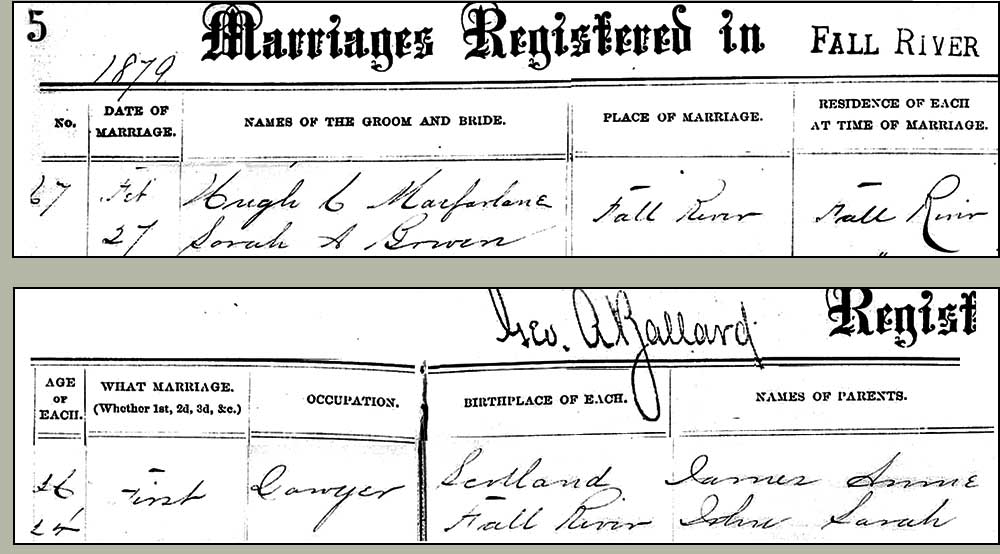 |
|
Sarah's 1860, 1865 and
below 1870 censuses confirm her parent's names as John
and Sarah Brown and hers as Sarah A. Brown. Her parent's
birth places of Ireland are confirmed on hers and Hugh's
1880 census The Browns were well off in real
estate. While very
few heads of house on this page owned real estate, with
those being in the $500 or below range, Sarah's father
owned $3,400 worth of real estate. He also owned
$400 in personal property, and his son John, a
lithographer, owned $600. This was a higher than
average amount for this page. Sarah's father and
brother James worked in a cotton mill, as did Sarah.
The Brown family on the
1870 Census
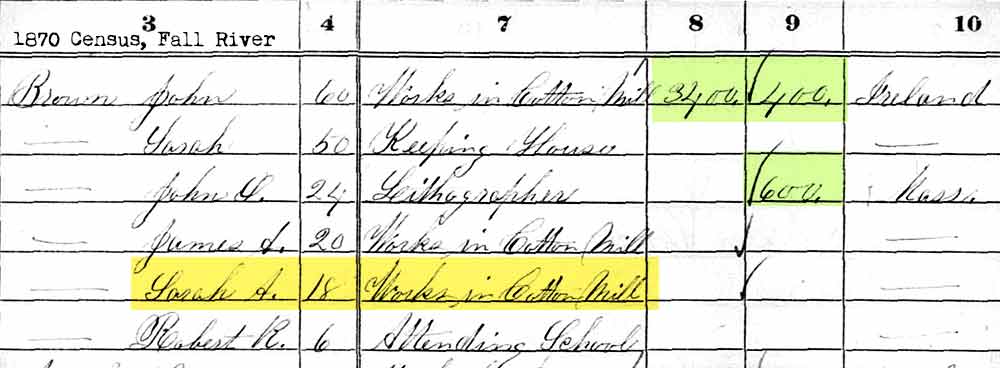
The Brown family on the 1860 Census of Fall River.
Sarah A. had an older brother named
William, age 16, who in mid 1869 would have
been age 24 to 25. The William who
married Mary Macfarlane in Fall River in
1869 also had parents named John and Sarah
and was 24. This is excellent evidence that
Hugh and his sister Mary each married siblings of this
Brown family and knew each other since the time of Mary
& William's marriage in 1869.
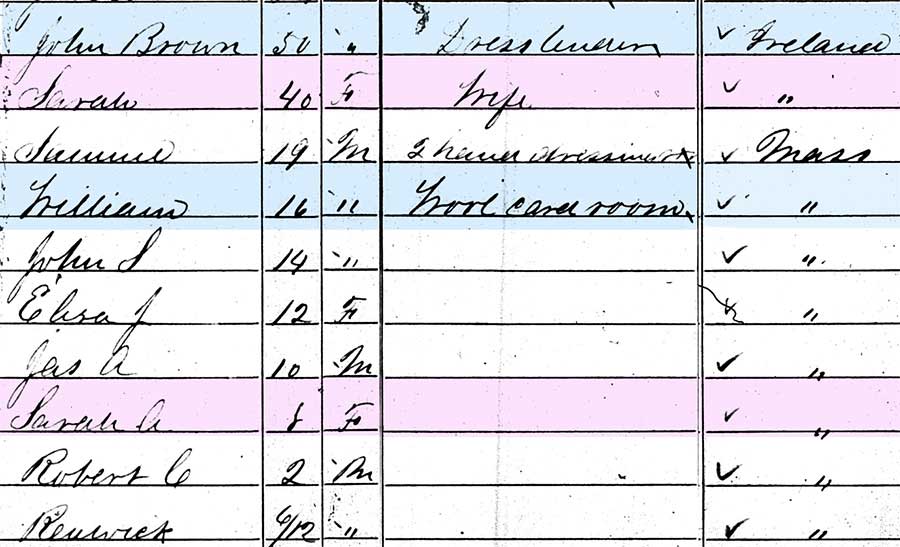
|
|
HUGH MACFARLANE'S FIRST MENTION IN A
LEGAL NOTICE
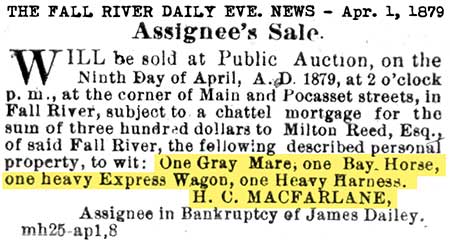
The first
of any type of legal notice found concerning Hugh was
this Assignee's Sale notice where he was assignee in the bankruptcy of James Dailey.
HUGH MACFARLANE'S FIRST LAW
PARTNERSHIP
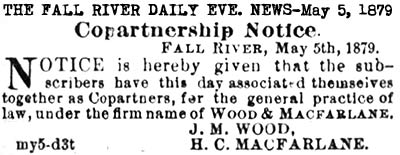
On
May 5, 1879, Hugh joined with Jonathan
M.
Wood to practice under the name of "Wood & Macfarlane"
located at rooms 19 & 20 of the Borden Block.
Censuses of Wood show he was
about twenty
years older than Hugh and in 1879 they would have been
around 48 and 27 respectively.
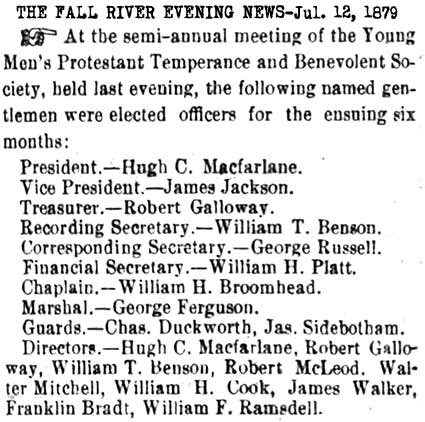
HUGH
ELECTED PRESIDENT OF A TEMPERANCE SOCIETY
At the semi-annual meeting of the Young
Men's Temperance and Benevolent Society on July 11,
1879, Hugh was elected as the president and a director.
Hugh was 28.
Later you
will read of a libel lawsuit Hugh files when a tabloid
publisher claims High is a drunk.
HUGH MACFARLANE IN THE NEWSPAPERS
|

The first ad located for Wood &
Macfarlane is from the Nov. 10, 1879 FRDH. The ad
indicates it was supposed to run through Nov. 10 of the
following year.
|
|
At
right: Later, handful of cases
appear in the legal section of the Fall
River newspapers where J. M. Wood represents
one of the parties in the suit, such as in
#797 at right Cain vs Hall. The defendant was
represented by J. M. Wood, the plaintiff by M.G.B.
Swift of Braley & Swift. No mention of
Macfarlane.
Below, the verdict for case 797
is for the defendant, Wood's client.
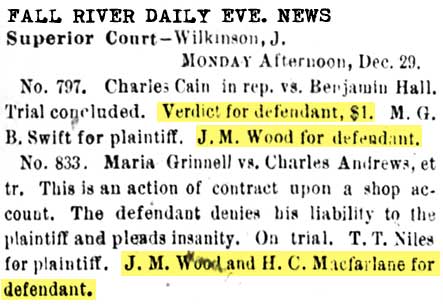
At right, Wood & Macfarlane prevail for the
defendant. |
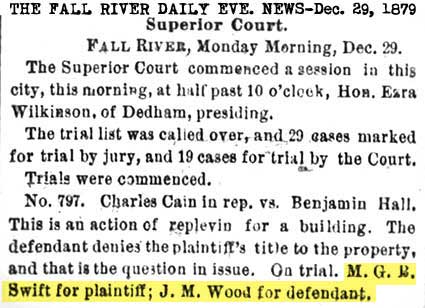
Case 833 below it shows Wood and
Macfarlane working together representing the
defendant who denies liability but pled
insanity, and prevailing over the plaintiff.
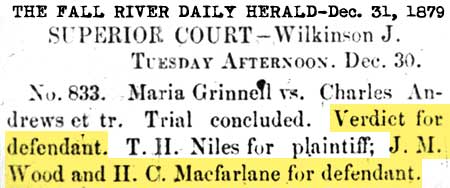
|
| BIRTH OF HUGH AND SARAH'S SON JAMES,
FALL RIVER, Mar. 5, 1880
Hugh and Sarah had a son
on March 5, 1880, they named him James Dick Macfarlane
after Hugh's father.
|
|
 |
|
1880 FALL RIVER CITY
DIRECTORY
Hugh worked at Wood & Macfarlane which was at 19 & 20
Borden block, while his home was at 120 Third.
His father, James, was a weaver
and lived at 43 Walnut.

It is not known if the other Macfarlanes
were related to them.
|
|
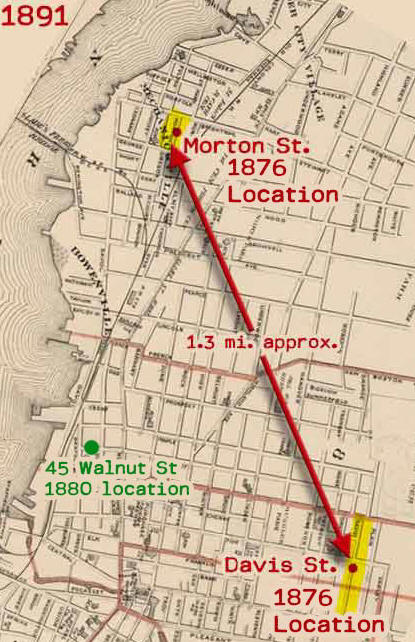
THE MACFARLANE FAMILY ON THE 1880
U.S. CENSUS IN FALL RIVER
At right, the locations of the two James
Macfarlanes, weavers, from the 1876 Fall River city
directory, compared to the Macfarlane's 1880 location.
Below: 45 Walnut was about 2 blocks from
the Bristol Co. Courthouse.
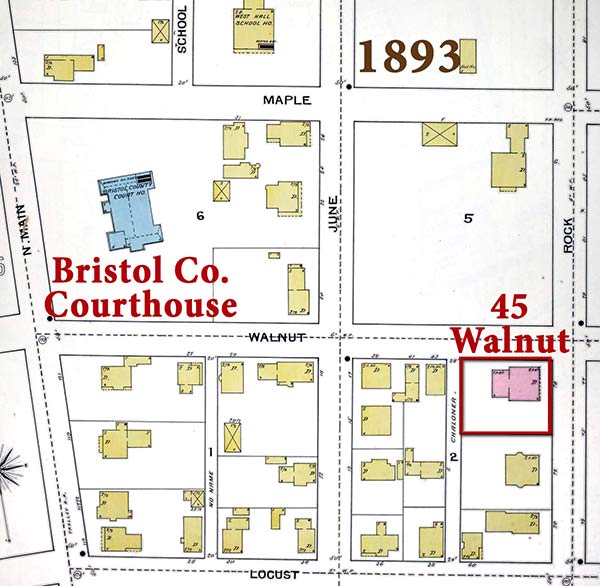
Keep in mind this map is THIRTEEN years after their
census.
Their home may not have been a brick
structure as seen here.
The 1880 Census of Fall River, Bristol
Co, Mass. shows the Macfarlanes living at 45 Walnut St.
As can be seen on the map, it was a large lot which
probably took up two addresses, 43 & 45.
It shows Hugh (28) and his wife (27) and son living in
Hugh's parents'
home, line 18. On line 19 is his wife Sarah
(Brown), daughter-in-law to the head of house. Then on line 20 is their son James at 3 months old. Col. 7 shows
he was born in March.
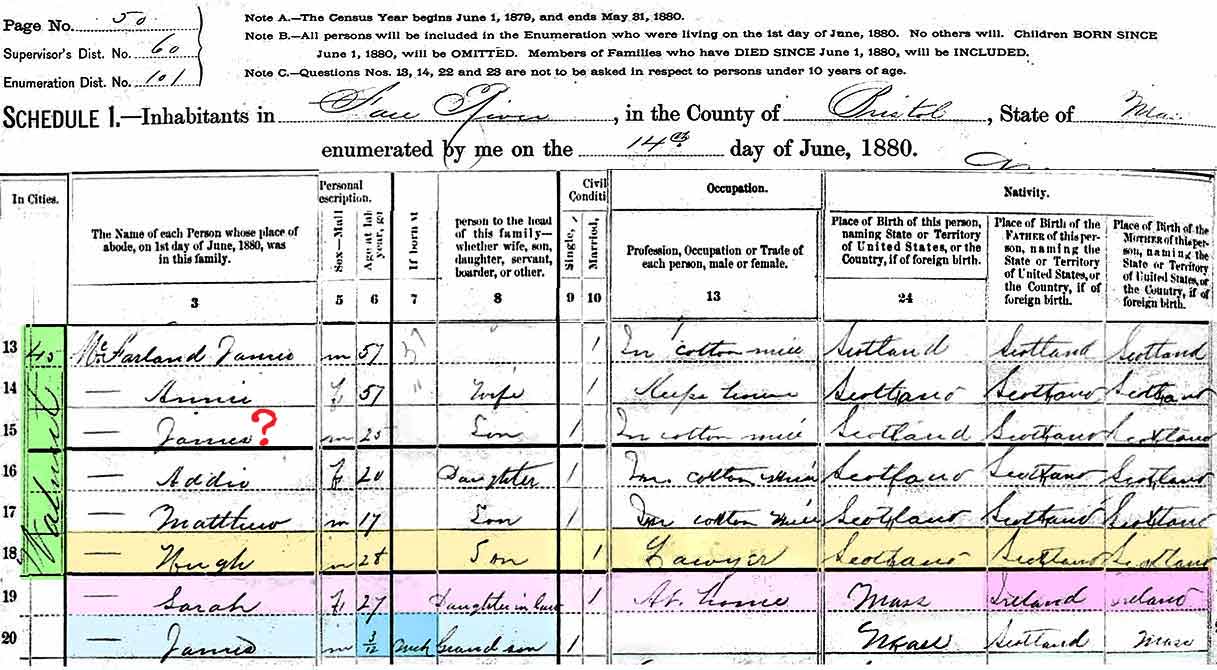
WHO IS SON JAMES AGE 25?
There is an issue with
"James" age 25 on line 15. It is known that there was no
son of James and Annie named James. David S.
Macfarlane is not listed here because he married in Jan. 1878 in Fall River and is
found on the 1880 Census living with his wife Emma their
two daughters, in the home of her parents, so this is
not an erroneous reference to David.
The most plausible explanation
is that the only persons home at the time
the enumerator visited in 1880 was Hugh's
wife Sarah and son James. Other than
Annie, Hugh's mother, all others had jobs in
cotton mills and Hugh was a lawyer, so all
could have been out working and Annie may
have been out. Sarah, being a new
member of the household, may have thought
Hugh had a brother named James who was
about 25 and out working at a cotton mill.
|
| DAVID
S. MACFARLANE ON THE 1880 CENSUS OF FALL
RIVER - LIVING WITH THE SIMMONS FAMILY
On the 1880
Census in Fall River, David was
enumerated as "McFallen" in the
household of Emma's parents, Andrew and
Mehatable Simmons at 17 Freedom
St. Perhaps Emma's parents
weren't too familiar with David's name, or
the enumerator recorded what he heard,
accented-"McFahlane."
David was a "Carriage Man" as he was in 1879
when he married Emma. In addition
to their daughter Anna Margaret, they have
another daughter, Sarah, who is 6 months old.
Notice Emma's
brother, William T. Simmons, bookkeeper.
You will read about him soon.
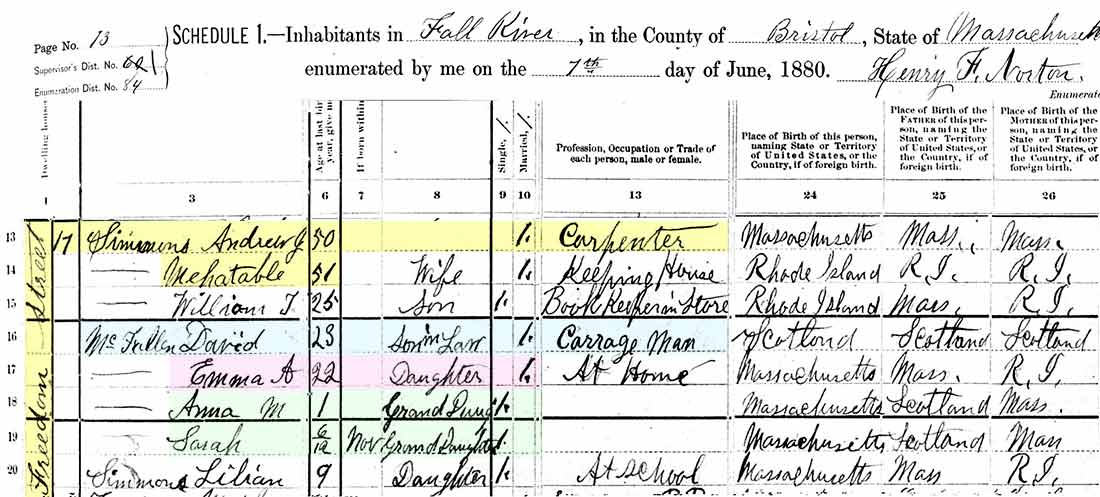
The census relationships are all with
respect to the head of house, hence Son in
law, daughter, and granddaughters.
Sarah was 6 months old, born in Nov. 1879. |
| |
|
DAVID S. MACFARLANE
APPOINTED AS A
CONSTABLE IN FALL RIVER, 1881
At the June 22, 1880 meeting of the Fall River Board of
Alderman (a form of City Council,) David S. Macfarlane
was confirmed as a Fall River constable. This was
a job which usually did not provide a salary but instead
paid the constable with a small fee for each service of writ
or summons/subpoenas. Constables did not carry a
weapon and were more along the lines of what we call
today a "neighborhood watch" or "night watchman."
His job was to peaceably keep the piece, as well as
serve process. He may have had the authority to
make arrests on the basis of his suspicion.
Charles F. Emery was also
appointed constable. Remember that surname, you'll
see it again soon.
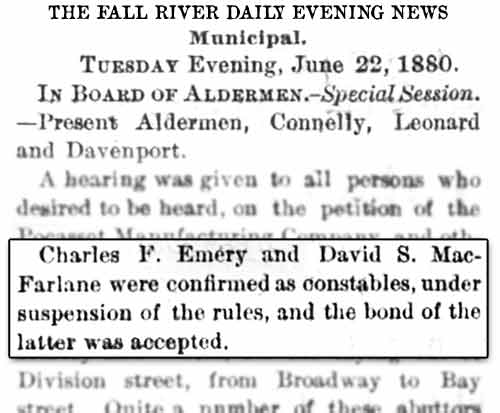
In the United States, there is no consistent use of the
office of constable throughout the states; use may vary
within a state. A constable may be an official
responsible for service of process: such as summonses
and subpoenas for people to appear in court in criminal
and/or civil matters. They can also be fully empowered
law enforcement officers. Constables may have additional
specialized duties unique to the office. In some states
the constable is an elected or appointed position at the
state or local level of local government. Their
jurisdiction can vary from statewide to county/parish
and local township boundaries based on the state's
laws. Prior to the modernization of law enforcement in
the middle 19th century, local law enforcement was
performed by constables and watchmen.
Constables were appointed or elected at the local
level for specific terms and, like their UK
counter-parts the Parish Constable, were not paid and
did not wear a uniform. They were often paid a fee by
the courts for each writ served and warrant executed. (Info
from Wikipedia: Constables in the United States.)
Lawsuit filed against David in Nov. 1881, a
"constable of the City of Fall River."
At
first glance it looks like he's being sued for work he
did on modifying a horse wagon, but that is not the
case. Seeing that constables didn't earn
much, David probably continued his work as a carriage
man. Especially since Emma was expecting her third child
very soon.
 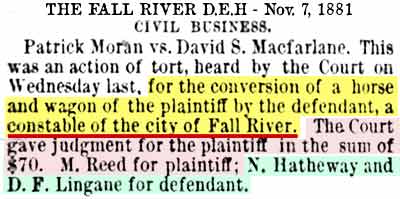
The "conversion of a horse..." etc. does not
appear to mean a physical modification to a
horse, wagon and harness, but instead
appears to be similar to a repossession.
Apparently a constable had the power to
serve these types of writs, which David did
because he believed the mortgage of the
property was given in fraud of the creditor,
Thomas Moran, a brother of the plaintiff
Patrick Moran. David served the writ
in favor of William H. Greene of Providence,
R.I., believing Greene's claim of being the
rightful owner and the property was not
Thomas's to mortgage to his brother Patrick.
The judgment was given in favor of the
plaintiff for $70. Notice David's
attorneys, N. Hathaway and D.F. Lingane.
You will see those names later as political
candidates endorsed by their friend, Hugh
Macfarlane.
DAVID &
EMMA'S THIRD DAUGHTER, ELIZA, FALL RIVER,
Dec. 11, 1881
On Dec 11,
1881, David & Emma had their third daughter,
Eliza B. Macfarlane, born in Fall River.
David's occupation was "overseer."
You will see this was in a cotton mill.

MACFARLANES ON THE JAN. 1, 1882 FALL
RIVER CITY DIRECTORY.
As the directory was released on Jan. 1, the
addresses would be where they lived and what
their occupations were in 1881. Notice
Hugh is missing. The other Macfarlanes
are the same as the previously seen
unrelated ones in 1880.

DAVID S. MACFARLANE
A "SECOND HAND" AT COTTON
MILLS 1881 - 1883
From 1881 to
around 1883,
David worked in the carding rooms at the Pocasset mill
and the Stafford mill in Fall
River.
His "overseer" position seen in
his above marriage record would
indicate a supervisory role, and two other
sources show David
was a "second hand" in the carding
rooms at the mills.3
Mills had a hierarchical structure, with
sections of each room under the supervision
of “Second Hands,” who reported to the
Overseer or “Boss” of the Room, who reported
to the Superintendent of the Factory. (From
"A Family Tradition, 175 years in N.C's
Textile Industry.)
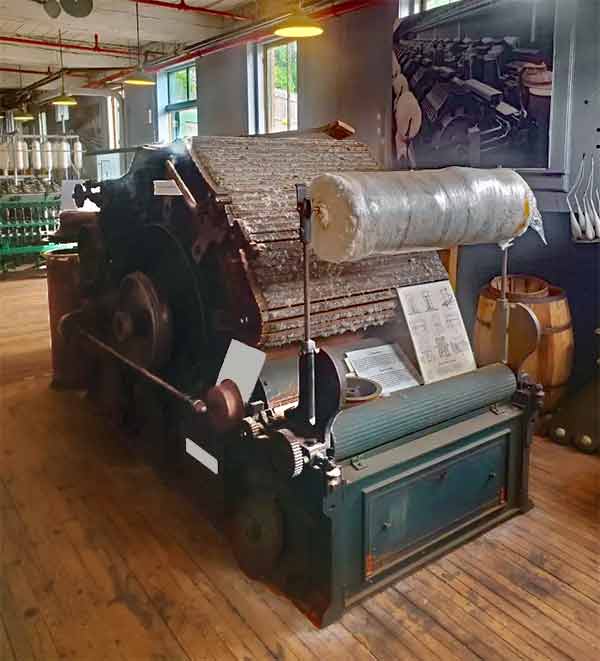 This
industrial carding machine seen at right was
manufactured around 1890 by the Saco-Lowell
Company, which had plants in Maine and
Massachusetts. Carding machines replaced
hand cards – hand-held steel brushes with
wooden handles once used to comb raw cotton
or wool to get all the fibers aligned, a
prerequisite for spinning. Carding
machines were much faster than carding by
hand, but they were also more dangerous. The
center of the carding machine is a massive,
rotating steel drum set with steel bristles,
against which also rotated a belt of steel
“flats,” which also had bristles.
Frequently, carders – the workers who
operated carding machines – got fingers,
hands, or arms crushed by the heavy drums,
or severed by the powerful gears.
Carders were paid by the amount of slivers
that they produced, so they often felt
pressured to “speed up,” thereby increasing
the chances of accidents. Here in
Willimantic, until World War II, carders
were all men, as the job was considered too
dangerous for women. Beginning during World
War II, though, women also became carders.
Carding machines were powered by big leather
belts, stretching up to heavy
drive-and-pulley systems mounted on the
ceiling, which in turn were powered either
by central waterwheels (before the 1870s) or
steam engines (after the 1870s). In the 20th
century, electric motors slowly replaced
steam as the main source of power. Carding
machines are massive. This
industrial carding machine seen at right was
manufactured around 1890 by the Saco-Lowell
Company, which had plants in Maine and
Massachusetts. Carding machines replaced
hand cards – hand-held steel brushes with
wooden handles once used to comb raw cotton
or wool to get all the fibers aligned, a
prerequisite for spinning. Carding
machines were much faster than carding by
hand, but they were also more dangerous. The
center of the carding machine is a massive,
rotating steel drum set with steel bristles,
against which also rotated a belt of steel
“flats,” which also had bristles.
Frequently, carders – the workers who
operated carding machines – got fingers,
hands, or arms crushed by the heavy drums,
or severed by the powerful gears.
Carders were paid by the amount of slivers
that they produced, so they often felt
pressured to “speed up,” thereby increasing
the chances of accidents. Here in
Willimantic, until World War II, carders
were all men, as the job was considered too
dangerous for women. Beginning during World
War II, though, women also became carders.
Carding machines were powered by big leather
belts, stretching up to heavy
drive-and-pulley systems mounted on the
ceiling, which in turn were powered either
by central waterwheels (before the 1870s) or
steam engines (after the 1870s). In the 20th
century, electric motors slowly replaced
steam as the main source of power. Carding
machines are massive.
Info and image courtesy of
WINDHAM TEXTILE AND HISTORY MUSEUM – THE
MILL MUSEUM |
|
LOCATIONS OF THE STAFFORD AND POCASSET MILLS
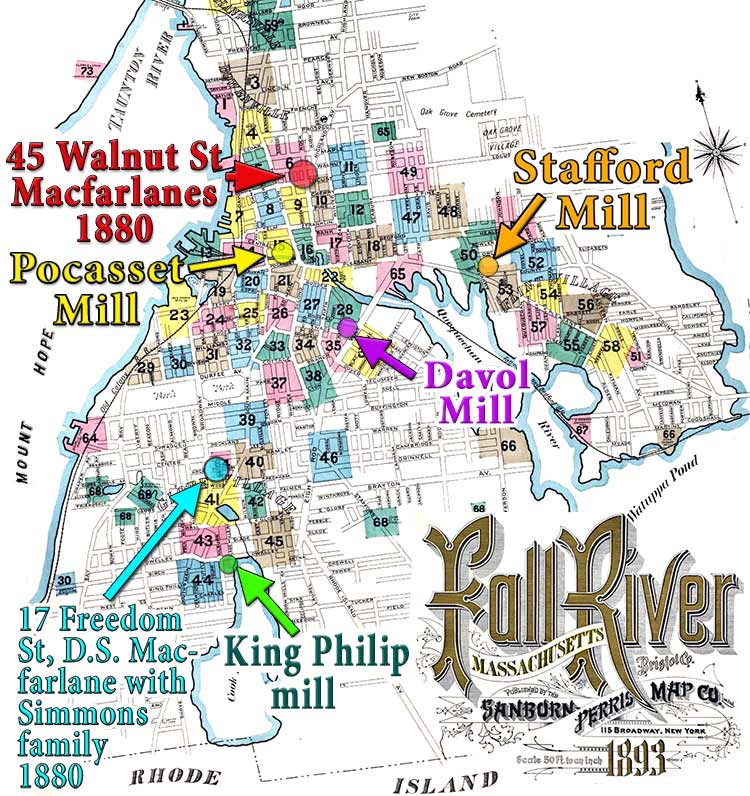
The Davol Mill and the King Philip Mill are
where David's brother Matthew worked.
|
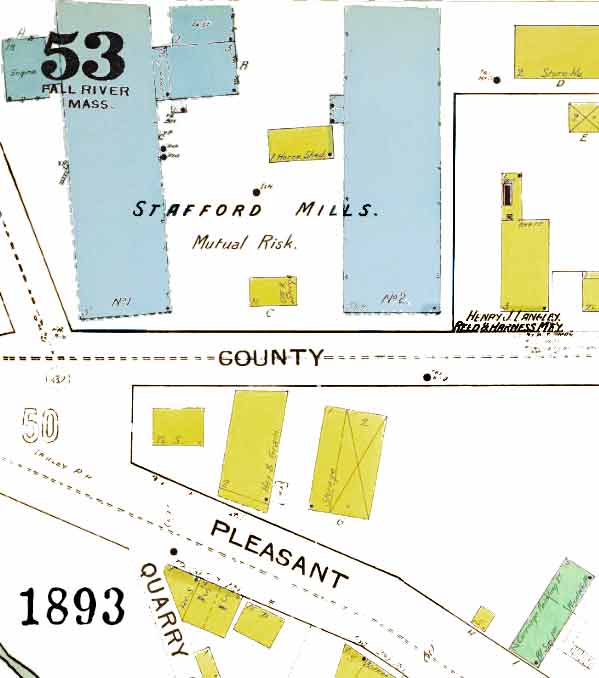
STAFFORD MILLS
Stafford Mills is a historic textile mill
complex located on County Street in Fall
River, Massachusetts, USA. Founded in 1872,
it is a well-preserved late-19th century
textile complex, typical of the mills built
in Fall River during its period of most
rapid growth. It is noted in particular for
its exceptionally fine Romanesque brick
office building. The complex was added to
the National Register of Historic Places in
1983.
The Stafford Mills company was
incorporated in 1870 with Foster H. Stafford
as its first president. The two mills
were built in 1872 and 1888, and the
office building was added in 1892. The company
produced print cloths, and operated until
1929 when it was closed. Today, the complex
is occupied by a variety of small businesses
and a discount furniture store. The
intersection of County Street, Pleasant
Street and Quarry Street in front of the
mill is known as Stafford Square. Stafford
Mills had a major fire on January 13, 2020
displacing many of the tenant companies and
damaging the structure.
Mill No. 1 on the left, No. 2 on the
right.
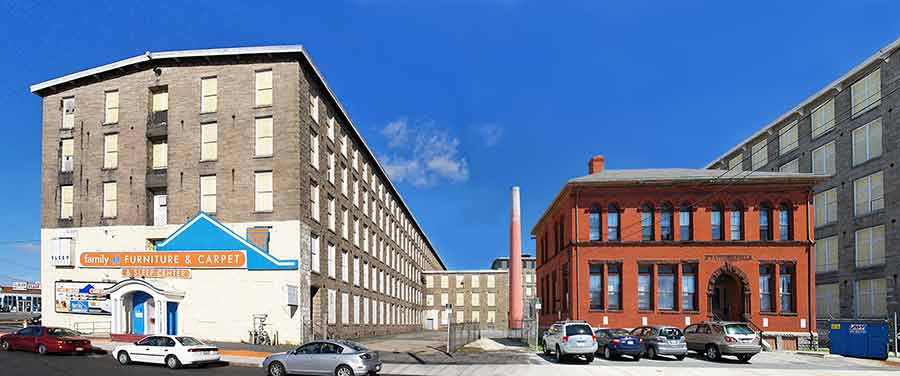
Building No. 1 on the left, Building No. 2
on the right, office building in between.
Two photos
from Wikipedia were seamed together to
create the image above.
|
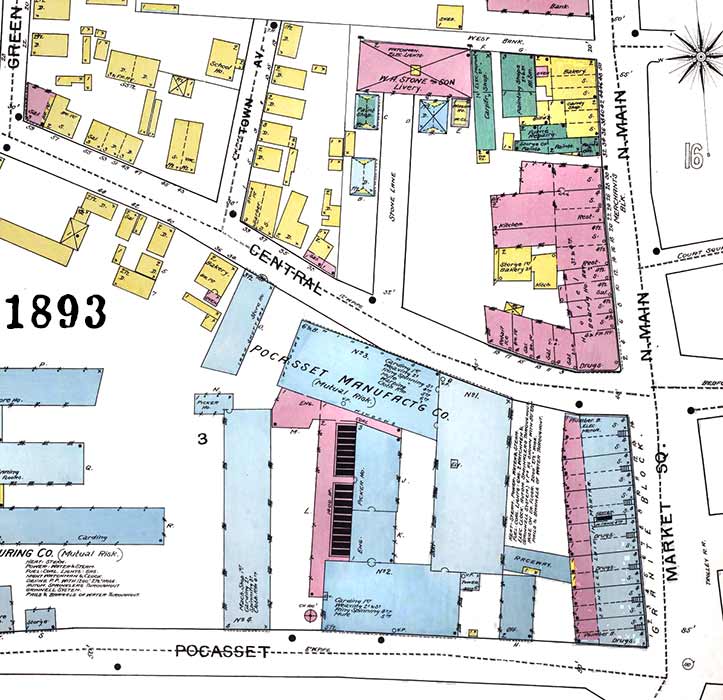 POCASSET
MILLS POCASSET
MILLSPocasset
Manufacturing Company was a cotton textile
mill located in Fall River, Massachusetts.
It was located just west of Main Street
across the second falls of the Quequechan
River. It was organized on August 15, 1821.
The mill began operation in 1822, with
Samuel Rodman of New Bedford as the
principal owner. Oliver Chace, served as the
mill's agent until 1837. Nathaniel Briggs
Borden was named clerk and treasurer. The
Pocasset Mills were the site of the origin
of the Great Fall River Fire of 1928. The
mills were destroyed along with a vast
portion of the city's business district.
Postcard courtesy of Fall Rivers Historical
Society Museum & Library.
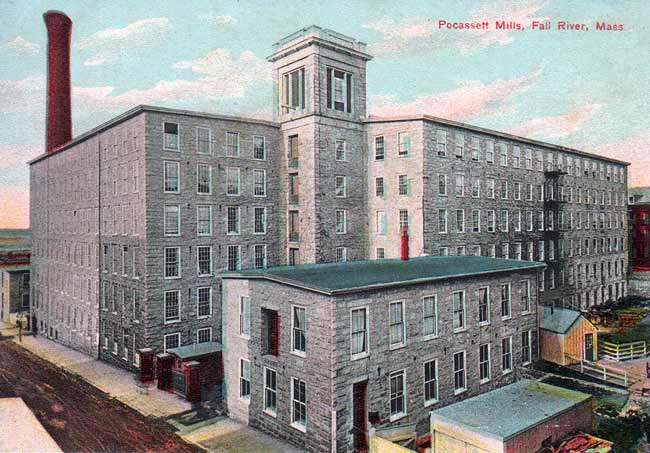
By 1877, the company employed 550 and owned
fifty four tenements. The number of
stockholders increased to twenty one. In
1899, a complete electric light plant was
installed. In 1905 the Pocasset replaced
16,000 mule spinners with 13,000 frame
spindles. That same year, the company also
acquired the mill of the Fall River
Manufacturing Company, operating it as Mill
#5. By 1917, the Pocasset Manufacturing
Company was capitalized at $1,200,000 and
had a capacity of 123,000 spindles and 2,874
looms. It produced satins, twills and plain
cloths. The mills operated until 1926, and
were destroyed by fire in 1928 during
dismantling.
Pocasset Manufacturing C. at
Wikipedia
|
HUGH
MACFARLANE THE PRO-LABOR DEMOCRAT ACTIVIST
|
| Hugh was an avid supporter of laborers
rights and often spoke at Democrat rallies to promote
Democrat candidates. At one
in particular in mid-September 1879 outside Fall River
City Hall, Hugh
was a well-recognized speaker promoting the Democrat
party for the Massachusetts legislature.
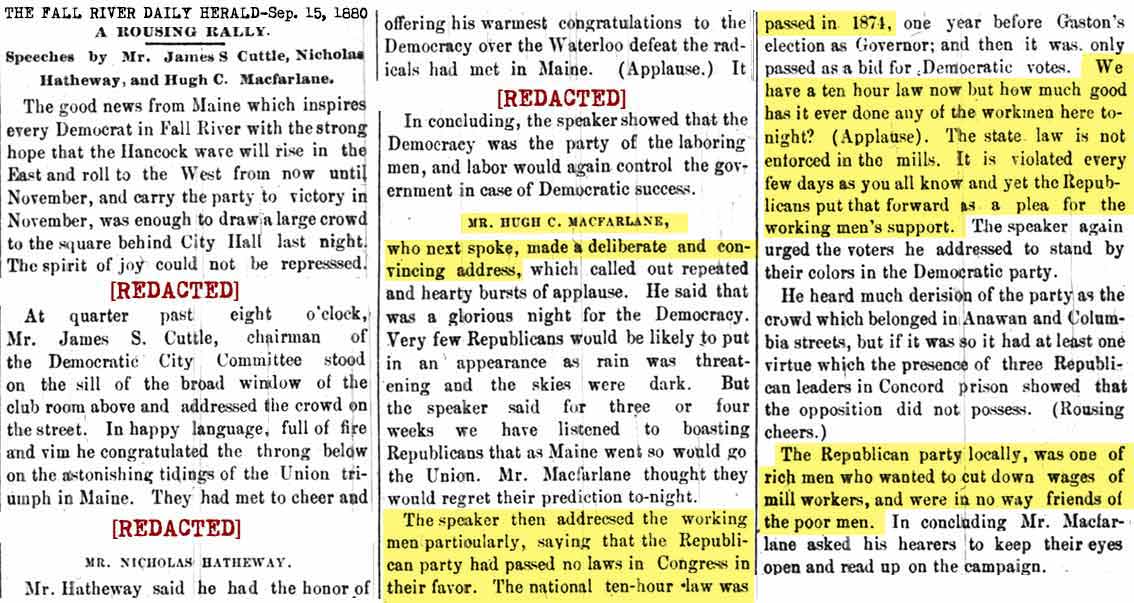
FALL
RIVER EVENING NEWS IS HARSH ON HUGH
The Fall River Evening News also
reported on the event and was not so quick to applaud,
critically picking apart Macfarlane's speech. "Mr.
Macfarlane will learn that working men are not fools,
but thinkers, and if he intends to address them again,
he should think over what he is going to say, or leave
the party's platform out of the discussion." This
was from a pro-democrat newspaper.
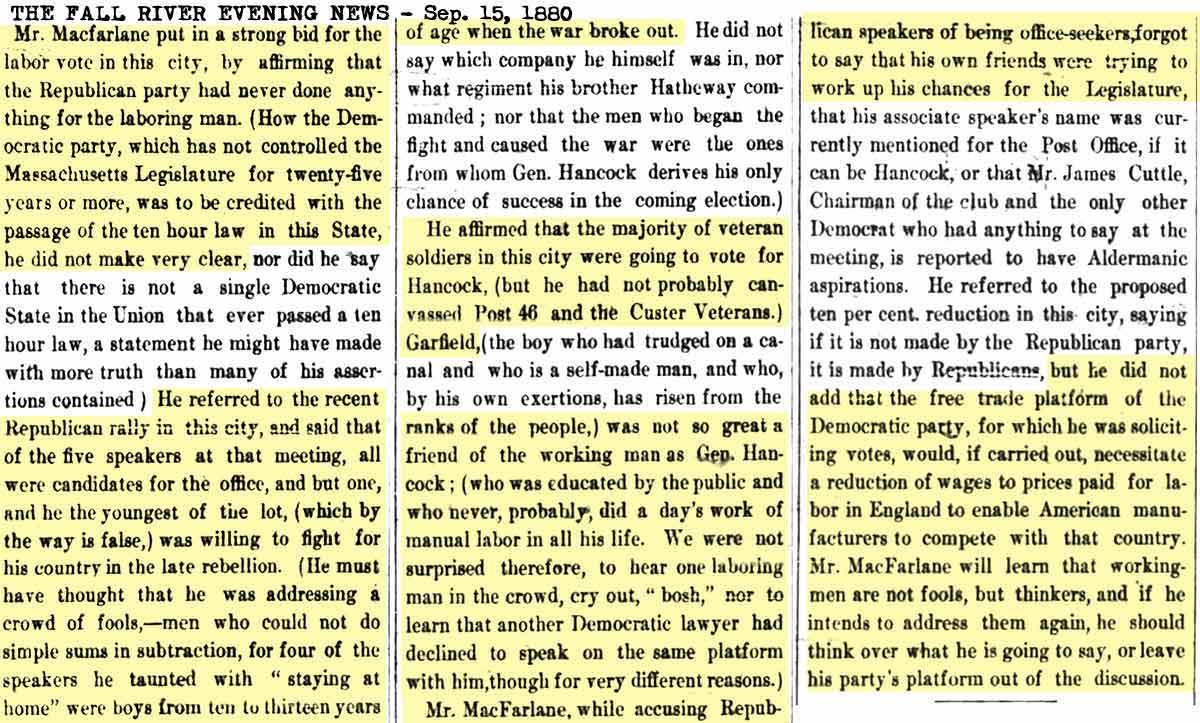 |
|
HUGH
MACFARLANE FILES A LIBEL SUIT AGAINST GEORGE GUNTON
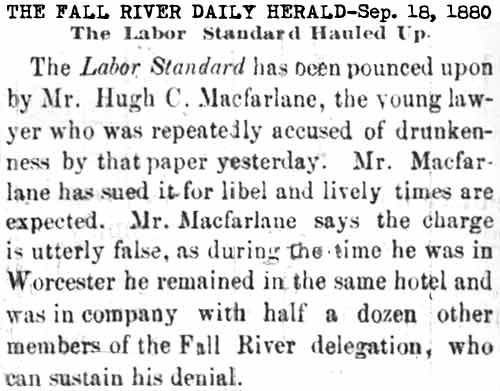 On
Sept. 17, 1880, Hugh filed a libel lawsuit against a
local pro-labor newspaper called the "Labor Standard"
and its owner and publisher, George Gunton, for its
Sept. 17 issue which repeatedly accused Hugh of
drunkenness at the recent Democratic rally.
Hugh said the charge was utterly false and admitted he
was in Worcester at a political rally with many members
of the Fall River delegation who could sustain his
denial. Gunton was also a pro-labor activist promoting
his own political candidates and was arrested on Sept.
22. made bail, and stated to the Fall River Daily Herald
that he is capable of substantiating the charges he
made. On
Sept. 17, 1880, Hugh filed a libel lawsuit against a
local pro-labor newspaper called the "Labor Standard"
and its owner and publisher, George Gunton, for its
Sept. 17 issue which repeatedly accused Hugh of
drunkenness at the recent Democratic rally.
Hugh said the charge was utterly false and admitted he
was in Worcester at a political rally with many members
of the Fall River delegation who could sustain his
denial. Gunton was also a pro-labor activist promoting
his own political candidates and was arrested on Sept.
22. made bail, and stated to the Fall River Daily Herald
that he is capable of substantiating the charges he
made.
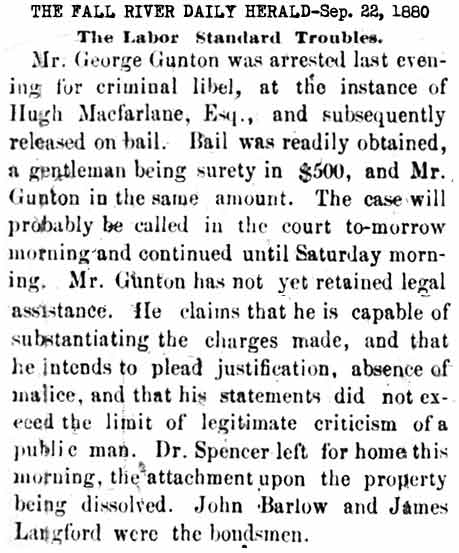
SUMMARY OF THE
FALL RIVER DAILY EVENING NEWS ARTICLE -
Sept. 25
A preliminary hearing was held on Sept
25, 1880, where it was revealed by the deputy sheriff,
that when serving the writ on Gunton at his newspaper
office, there was a bulletin posted at the entrance in large letters: "Closed for telling the truth." At the hearing,
witnesses testified in behalf of Macfarlane, including
Mr. Braley (of the firm Braley & Swift where Hugh studied as a law clerk.) Hugh stated that
he attended the Democratic convention in Worcester but
was not drunk there. He had never offered himself
up as a candidate, but his name was used in that
respect in Gunton's paper. Hugh admitted to drinking three glasses of
lager and lemonade and smoking an abundance of cigars.
He said he never drank hard drinks and had a lemonade
and sherry. He also explained that there was a
great noise going on at the hotel with lots of excited
political activity, when an officer was about to arrest
a man, Hugh interfered. The officer told him to
mind his own business. The court found sufficient
evidence to prosecute Gunton and he was bound over to
the Superior Court in the sum of $500.
THE FALL RIVER
DAILY HERALD HAD FAR MORE TO SAY ABOUT
HUGH'S TESTIMONY. (Blue)
NOTE: Hugh refers to all alcoholic drinks as
"liquor" even lager beer. What is
called "liquor" today he called "hard
drinks" and abstained from them.
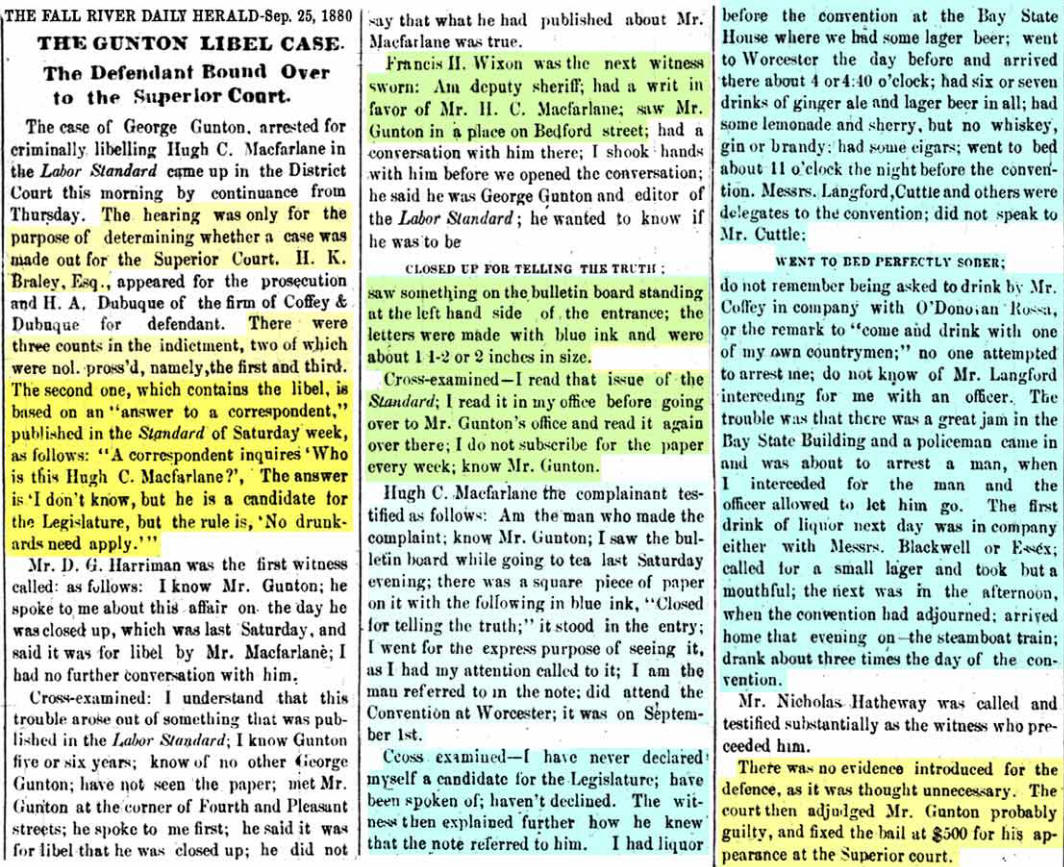
|
|
HUGH IN
THE NEWS OFTEN The last ad found for Wood &
Macfarlane was on Oct. 9, 1880. The ad itself indicates
it was supposed to run through Nov. 10.
|
On Oct. 22, 1880, the FRDH praised Hugh as an excellent man to send to the
Legislature. "Mr. Macfarlane is well-known, able,
and highly respected. He has done hard work for
his party and deserves to be remembered."
(Hugh testified at the pretrial hearing that
he did not announce himself as a candidate
at the Democratic rally but that his name
was used in that respect.)
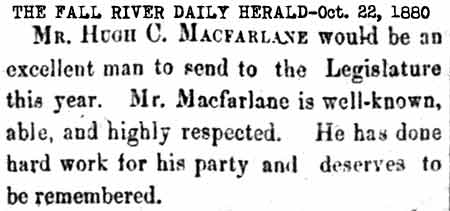 |
|
Hugh made news the
next day for
representing 85 men in Boston for the purpose of
naturalization and succeeding with 84 of them.
Hugh didn't become a naturalized citizen of
the U.S. until Mar. 1, 1912 in Tampa. |
On the same day, the FRDH urged readers to
get their naturalization papers in order and
advised they call on Hugh to assist them.
The Herald appears to encourage this so that
they may be able to vote. |
Hugh and two other attorneys each had
friends in a "very active contest" for the
office of City Solicitor. One possible
candidate was D. F. Lingane. (David
Macfarlane's attorney) |
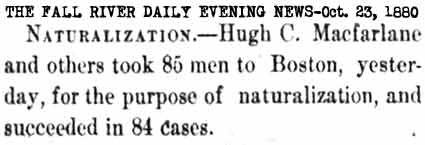 |
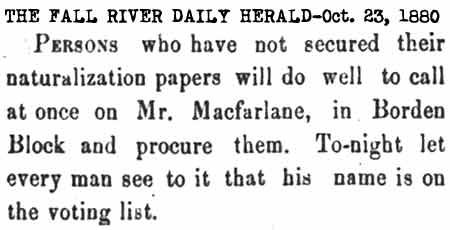 |
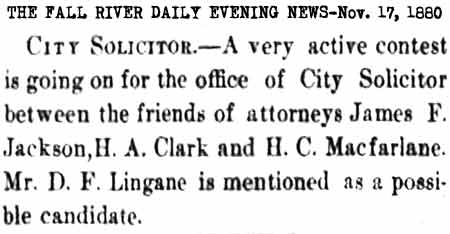 |
GUNTON IN
THE NEWS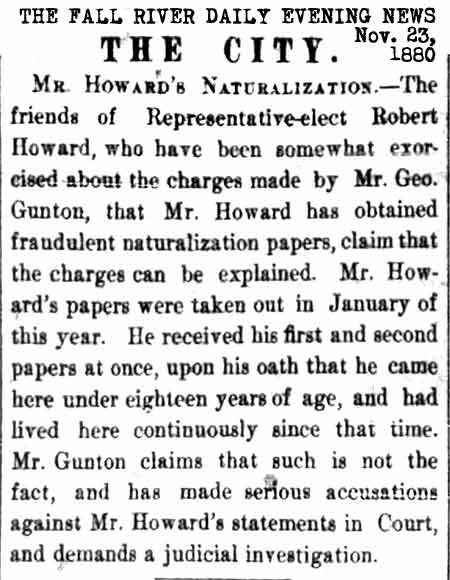
A few days
later, George Gunton was in the news again, this time
he charged that a Representative-elect,
Robert Howard had obtained his naturalization with
fraudulent papers, claiming Howard's claim of filing in
January was false. Howard claimed he received
first and second papers at once, and taking an oath that
he was continually in this place since he came at the
age of under 18.
MACFARLANE VS. GUNTON LIBEL SUIT CONTINUED UNTIL MARCH
TERM NEXT YEAR
In mid-December 1880, George Gunton was
indicted by the Grand Jury for criminally libeling Hugh
C. Macfarlane, Esq. The case was expected to be tried on
Dec. 23rd, 1880, but was continued at that time by the
judge until the March 1881 term of the court.
Hugh's lawyer was H. K. Braley of Braley & Swift.
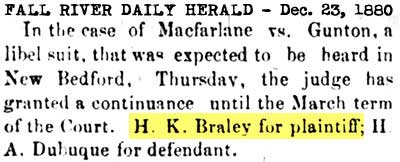
January 1, 1881 - The soonest Hugh and
Sarah could have separated. (You
will see why this is worth mentioning, 9 months from this
date.)
|
|
HUGH
MACFARLANE AND JONATHAN WOOD FOR THE DEFENDANT - Jan.
11, 1881
|
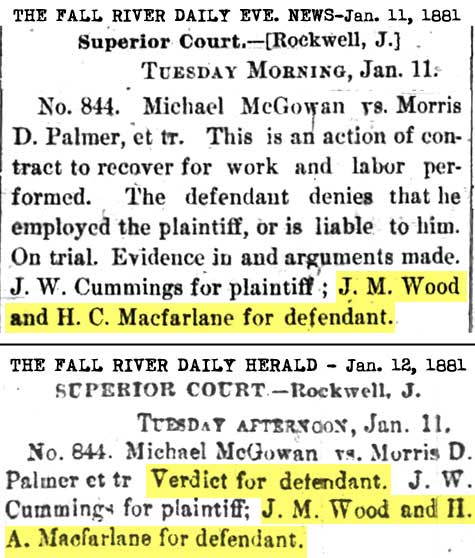
On Jan. 12, 1881,
Hugh
Macfarlane and J. M. Wood prevailed for the defendant
Morris D. Palmer in an action of contract to recover for
work and labor performed. Palmer denied that he
ever employed the plaintiff, or was liable to him.
The Jan. 12 article has misspelled Hugh's middle
initial.
HUGH ACCEPTS
A POSITION
AT BRALEY & SWIFT - Jan. 20, 1881
On
Jan. 20, 1881, it was published in the FRDEN that Hugh C.
Macfarlane had accepted a position in the office of Braley
& Swift on Borden Block. Through the months of
January to May of 1881, Hugh represented various clients
according to the legal news.

HUGH
MACFARLANE VS. GUNTON LIBEL LAWSUIT VANISHES FROM THE NEWSPAPERS
Although a
diligent search was performed, there was no news found concerning any further
legal action in the libel case of Macfarlane vs. Gunton.
Hugh may have dropped his lawsuit for an out of court
settlement, but this doesn't seem likely. He
probably would have rather cleared his name and reputation
publicly. He may have been advised to drop it if
he could not prove any damages.
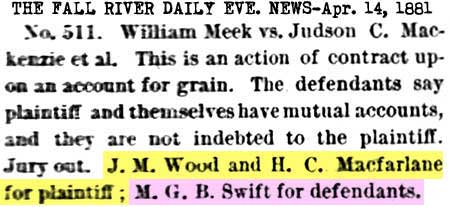
HUGH IS OPPOSING COUNSEL AGAINST SWIFT, STILL CO-COUNSEL WITH
WOOD - Apr. 14, 1881
AT RIGHT:
Even though Hugh had
accepted a position at Braley & Swift, three months later,
on April 14, 1881, Macfarlane was still practicing with J.M. Wood with case no. 511, Meek vs. Mackenzie et al,
and surprisingly, the opposing counsel is M.G.B Swift. It
appears that Hugh not yet joined Braley & Swift.
Perhaps they had an agreement that allowed Hugh to
finish up with clients he had already done work for.
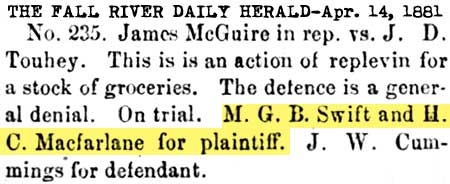 HUGH
IS CO-COUNSEL WITH SWIFT - Apr. 14, 1881 HUGH
IS CO-COUNSEL WITH SWIFT - Apr. 14, 1881
AT LEFT: On
the same day as case no. 511, we find Case 235, McGuire
vs. Touhey, April
14, 1881, Macfarlane is representing the plaintiff with M.G.B. Swift.
This is the only case published where Swift & Macfarlane
represent the same party.
The next day, Wood and Macfarlane's client Meek,
prevailed in
case no. 511 Meek vs. Mackenzie
over Swift's client,
Mackenzie.
Apr. 15, 1881
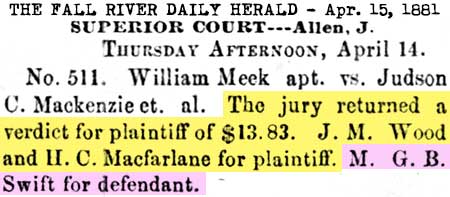

Apr. 23,
1881- This is the last case found in the papers handled by Hugh.
He may have been practicing alone at this point.
|
|
NOW YOU SEE HIM, NOW
YOU DON'T
|
|
JUN.
24, 1881 - HUGH
HAS MYSTERIOUSLY DISAPPEARED
On June 24, 1881, the FRDEN published
"Hugh C. Macfarlane, Esq, attorney at law, has mysteriously disappeared.
He has with him a number of keys belonging to Braley &
Swift, one of which is a safe key."
|
JUN. 29,
1881 - WHERE IS
HUGH MACFARLANE?
On June 29, 1881, the Fall River Daily
Herald published "Where is Macfarlane?" stating nothing
definite has been heard regarding the missing lawyer of
this city. "The
latest rumor is that he has obtained a
position on a United States steamer at
Newport." |
|
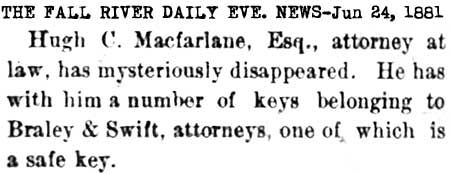 |
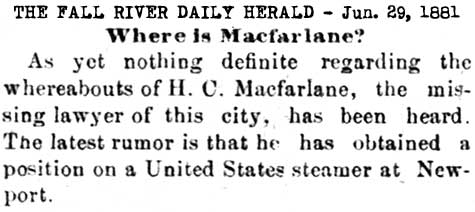 |
The Jan. 29th article
of the rumor being he "obtained a position" on a steamer,
doesn't necessarily mean he got a job on a steamer, it
likely means the rumor was that he had booked passage on a steamer.
So far, no outgoing
passenger lists from Newport have been found
online.
|
DIVORCE OF HUGH AND SARAH (BROWN) MACFARLANE
According
to histories of Hugh which mention his divorce, he and Sarah divorced
soon after the birth of their son.
But which son? He and Sarah had another son who is
not mentioned in histories that tell of his
first wife.
BIRTH OF
SECOND SON OF HUGH MACFARLANE & SARAH A. BROWN
Frank B.
Macfarlane was born Sept. 1, 1881 in Fall River Mass.,
about two months after Hugh was reported missing in Fall
River.
The information
below is from Fall River, Town Clerk Vital and Town
Records.
Frank's middle name was probably "Brown."
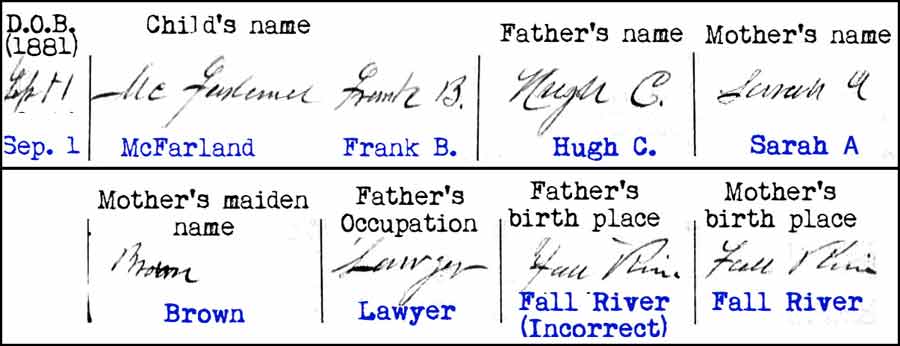
Their previous son, James D. Macfarlane, was born March
5, 1880, so James & Frank were born about 1yr & 5 mos.
apart.
If Frank was not premature, it means Hugh and Sarah were
together at least until Jan. 1, 1881 which was almost
six months before his disappearance in Fall River.
|
|
MARRIAGE OF
MATTHEW BIGGAR MACFARLANE
& MARY ALICE CORDINGLY, OCT. 13, 1880
Matthew was the youngest of the Macfarlane
children; he was born Mar. 20, 1861
in Pollokshaws, Renfrewshire, Scotland and
was four years old when he came to America
from Scotland with his family. He
was almost ten years younger than Hugh and
about four years younger than David.
Matthew
would have been around 15 when his family
moved from Minnesota back to Fall River
around 1876. By the time he was 19
years old (1880 Census) Matthew was working
as a loom fixer in a cotton mill.
On Oct. 18,
1880, Matthew married Mary Alice Cordingly
in Fall River, daughter of James & Anne
Cordingly of Fall River.
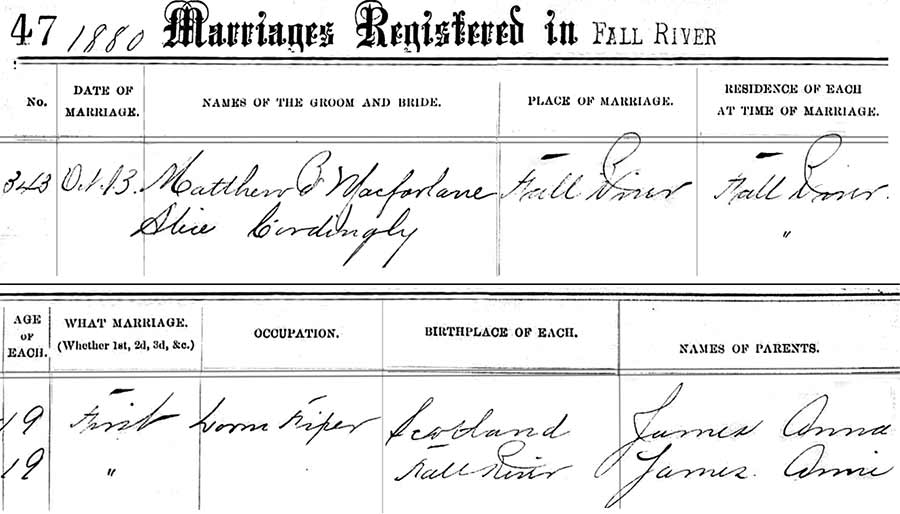
Matthew was still working as a loom fixer.
BIRTH OF MATTHEW & ALICE'S DAUGHTER,
ANNE MACFARLANE, FALL RIVER, 1881
Matthew and
Mary Alice's only child,
Anne Davenport Macfarlane, was born in Fall
River on May 22, 1881.
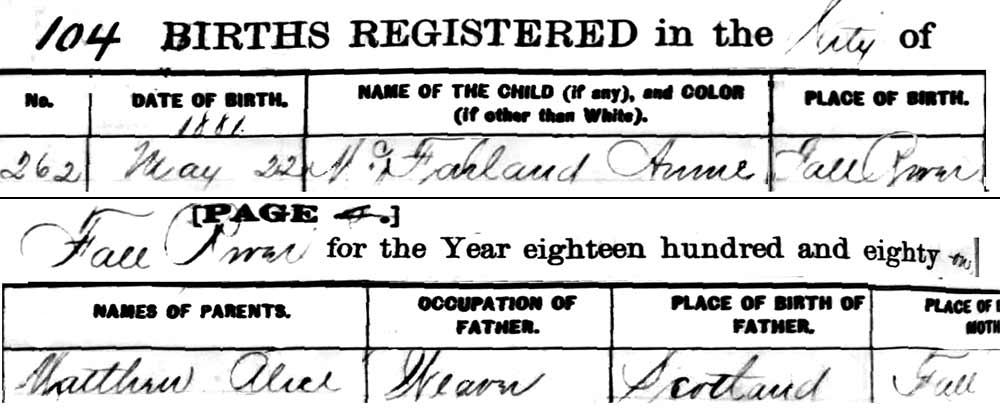
Matthew was working as a weaver when Anne
was born.
Matthew worked
as a loom fixer and a weaver in the cotton
mills of King Philip and the Davol mill for
the last two or three years they remained
in Fall River. Then he ended his
cotton mill career to head to Jacksonville
in late 1883 to early 1884.3
|
Locations of the King Philip and Davol mills |
|

1893 Sanborn Fire Insurance maps of Fall
River from Library of Congress.
|
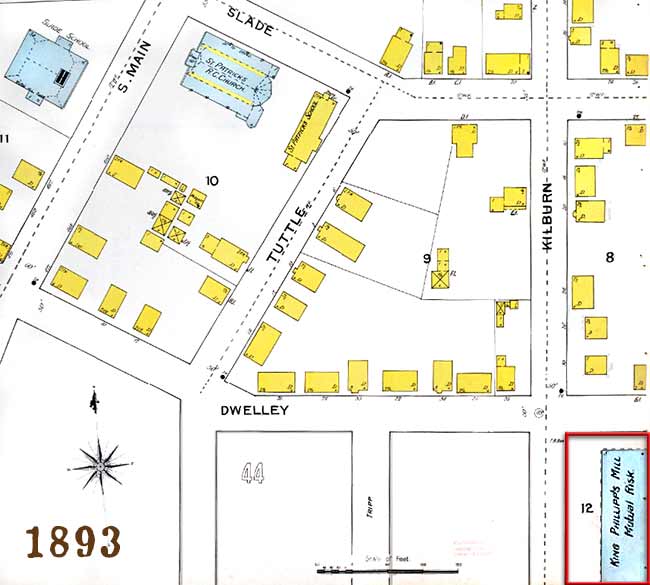 KING
PHILIP MILLS KING
PHILIP MILLSKing
Philip Mills is a historic cotton mill
complex located at 372 Kilburn Street in
Fall River, Massachusetts. Developed between
1871 and 1892, it was one of
the city's largest mills, and its building
inventory is still largely complete. The
complex was added to the National Register
of Historic Places in 1983
The complex was located in southern Fall
River, on the northwest shore of Cook Pond.
The complex was bounded on the north by Dwelly Street and the west by Kilburn
Street. It consisted of more than twelve
interconnected buildings. Mills 1 and 2
joined by a picker house to form a structure
with a unified facade 740 feet in length;
this is the longest such building in the
city.
The King Philip Mill was organized in
1871 and Mill No. 1 was built the same year.
In 1881 Mill No. 2 was built. Mill
No. 3 was added in 1888 for weaving. Mill
No. 4 was built in 1892. By 1917 the
company had a capacity of 134,000 spindles
and 3,000 looms. In 1930 the company
was acquired by Berkshire Fine Spinning
Associates which later became Berkshire
Hathaway. Textile production ended on
May 8, 1964, and the complex was used by a
variety of light industrial concerns. On the
morning of January 3, 2012, the former
office building of the mills was destroyed
by arson.
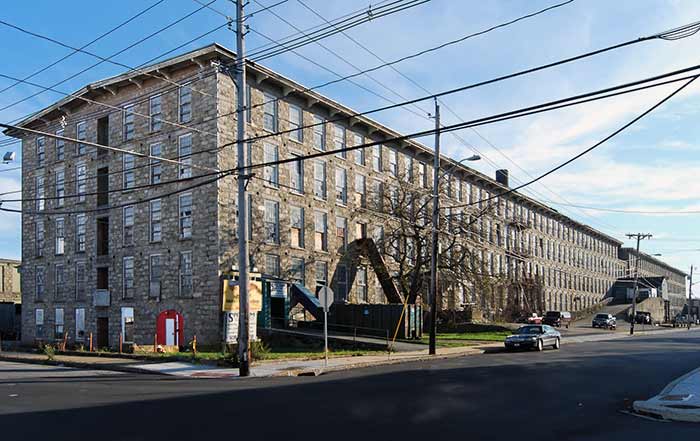
Image and info from Wikipedia
The 750,000 square foot mill property was
bought by developer Robert Kfoury in 2018,
with plans to build single-family homes
there. Demolition of the King Philip mill complex began
on May 29, 2018. All but one building was
demolished.
|
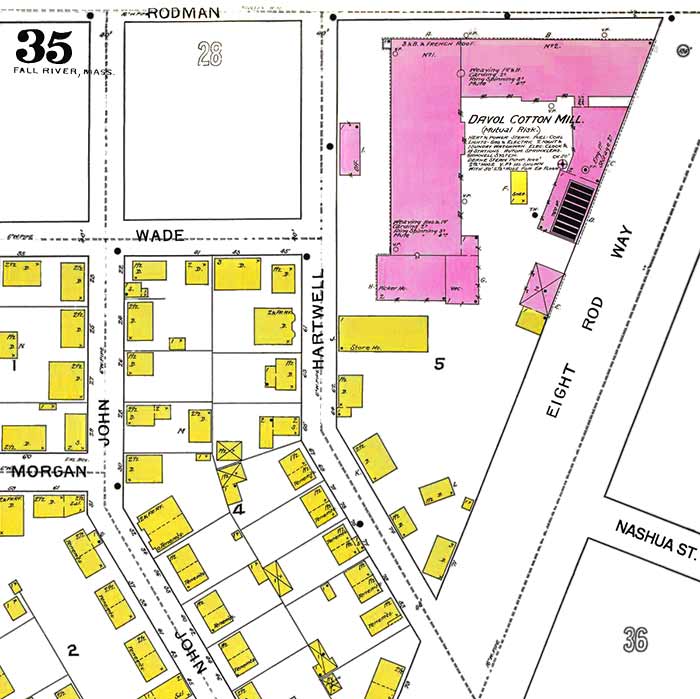 DAVOL
MILLS DAVOL
MILLSDavol Mills is a historic textile mill
complex located at the corner of Plymouth
Avenue and Rodman Street in Fall River,
Mass. It was built in 1867 and
expanded in 1871. It was added to the
National Register of Historic Places in 1983
as part of the Corky Row Historic District.
The Davol Mills Company was organized in
1866, with nineteen persons and named in
honor of William C. Davol, a machinery
builder who is credited with importing the
Roberts Self-acting Mule from Great Britain
to Fall River in the early 1840s. Mill No. 1
was built in 1867 at the corner of Rodman
Street and Eight Rod Way (now known as
Plymouth Avenue). The machinery was in
operation by March 1868. The Davol Mills
initially produced cotton shirtings,
sheetings, silesias* and fancy fabrics.
In 1871, Mill No. 2 was built along Hartwell
Street, connected to the first mill. By
1917, the Davol Mills contained 44,000
spindles and 1,258 looms. The company
acquired the nearby Tecumseh Mills in 1924.
It shut down in 1935.
*Silesia
(Sleazy, Slesia) was a thin twilled woven
cloth made of linenor cotton. The term
denoted a wide range of fabric grades from
greige goods to dyed and finished cloth.
Silesia was used for various linens, for
lining clothes, and in window blinds. Cotton
Silesia was calendered to obtain a gloss
finish.
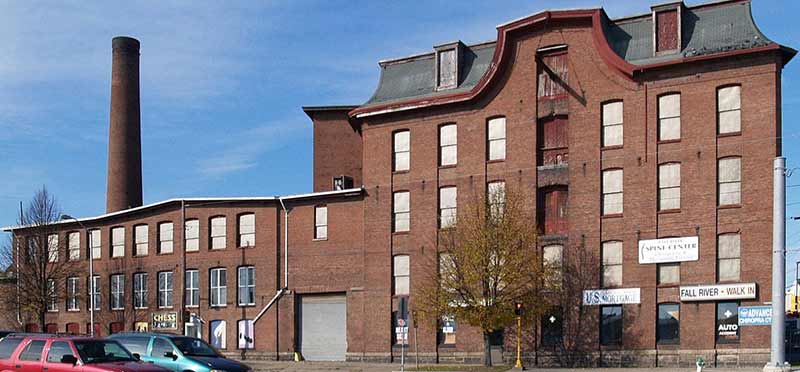
Davol Mills
mage and info from Wikipedia.
1893 Sanborn Fire Insurance maps of Fall
River from Library of Congress. |
|
|
MARRIAGE OF JEANETTE
D. MACFARLANE, YOUNGER SISTER OF HUGH,
TO JOHN A. LOCKHART, FALL RIVER, DEC.
26, 1881
On Dec. 26, 1881,
Jeanette Macfarlane married in Fall
River to John A. Lockhart, a wood dealer
from Ireland. Their entry in the
Massachusetts register of marriages
shows John was 26, Jeanette was 27.
He was a son of Alexander and Ann J.
Lockhart.

The Lockharts had six
children in Fall River: Annie J.
(Jul 1884), Mary E. (Mar 1886),
John A., Jr. (Nov 1887),
James Hugh (Dec 1891),
Sarah (Aug 1893), and Samuel
W. (1894). Sarah die d at age
20 days of Marasmus* and Samuel died of
cerebral meningitis in 1897 at age 3.
The Lockharts were in Fall River on the
1900 Census with their four children,
and still in Fall River in 1910 with
just their sons John (22) and James (18)
in the home, the daughters having
married. *See further below for
more about Marasmus.
|
JUMPING
FORWARD TO 1911 -
LOCKHARTS MOVE TO MACFARLANE PARK IN
WEST TAMPA
The
Lockharts moved to Tampa on Christmas
day, 1911, building a home on Maxwell
St. and Laurel St. at Macfarlane Park in
West Tampa. (This location today
is the median of Interstate 275.)
John was in business in partnership with
his son, John A. Lockhart, Jr. in the
heavy hauling and contracting business.
Jeanette's
husband John (Sr.) died of paralysis on
Jun 1, 1913 in Tampa due to a stroke he
suffered two weeks earlier. He was 57.
He was a devout Christian and a
well-loved and highly respected member
of the West Tampa community and all of
Tampa.
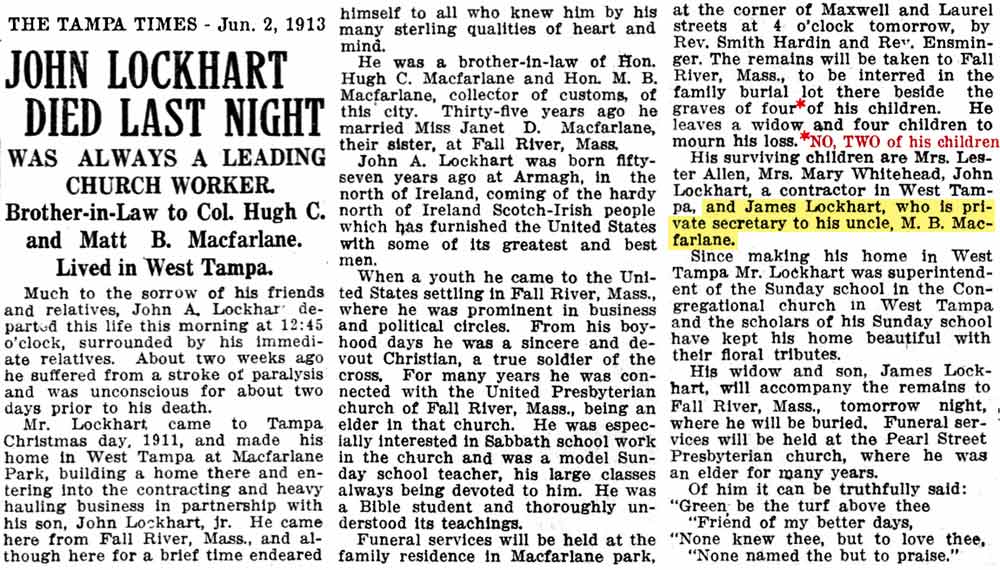 |
His son James Lockhart was a private
secretary for Matthew Macfarlane.
|
|
DEATH OF
FRANK B. MACFARLANE, SECOND SON OF HUGH & SARAH, FALL
RIVER, 1882
On Jan. 9, 1882, Hugh &
Sarah's second son died at the age of 4 months, 9 days,
in Fall River. His cause of his death was listed
as "Marasmus."
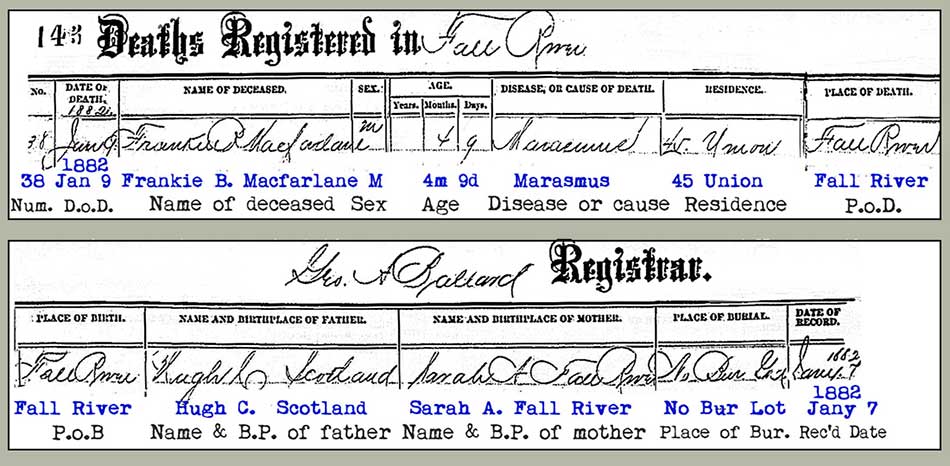
No articles could be found concerning Frank's birth, death, or his
parents' divorce, before or after Hugh's disappearance
and before his arrival in Tampa. As presented to this
point, Hugh was in the news before his disappearance
quite often for about his legal practice and libel
lawsuit. His family may
have known where he was, but apparently neither Braley &
Swift knew, nor did the press, at this point.
|
| MARASMUS Marasmus is a severe
manifestation of protein-energy malnutritio
which leads to overt loss of adipose tissue
and muscle. Nutrient deficiency is the main
cause of marasmus. It occurs in children
that don't ingest enough protein, calories,
carbohydrates, and other important
nutrients. This is usually caused by poverty
and a scarcity of food but not necessarily
the only cause. Certainly, the Macfarlanes
were not impoverished nor were they living
in an area where food was scarce.
There are several types of malnutrition.
Viral, bacterial, and parasitic infections
can cause children to take in too few
nutrients. Insufficient breastfeeding or
protein deficient mother's milk can be a
cause in infant marasmus if there is no
other source of nutrition. If mothers are
malnourished, they are unable to feed their
infants enough milk during breastfeeding.
This can increase the chances of
protein-energy malnutrition in infants.
These conditions are frequently associated
with infections, mainly GI. The reasons for
a progression of nutritional deficit into
marasmus rather than kwashiorkor are unclear
and cannot be solely explained by the
composition of the deficient diet (ie, a
diet deficient in energy for marasmus and a
diet deficient in protein for kwashiorkor,
which was more recently established as a
particular form of protein malnutrition.)
In the 19th Century, a malnourished child
may have had something other than marasmus
but be recorded as marasmus. Among the more
common types of malnutrition are serious
deficiencies in iron, iodine, zinc, and
vitamin A. As the medical arts advanced over
the years, specific causes of malnutrition,
such as an infant's or child's inability to
absorb certain nutrients from food, are
diagnosed rather than just diagnosing
"marasmus."
In 1895 in Boston, area child charity
groups were pressuring to get the State
Legislature to pass a bill that would raise
the age minimum of children for
insurability. They claimed parents
were abusing their children by various means
to the point of death just so they could
collect on their life insurance policy, and
that a diagnosis of Marasmus was proof.
At that time, the minimum age for life
insurance was one year
old. The charities claimed that
starvation was a means that parents caused
the death of their children, citing the number of children
who died of marasmus and naming several
cases along with their accusations of the
parents which also included exposure to
cold.
One such lobbyist was a Mrs. Atwood, whom
Dr. Wells said was disgracing the name of
the state by getting up in the state house
and making such a charge, saying "if that
were true, then they as citizens should hang
their head in shame..."
Dr. Wells proceeded to give a short
explanation of the nature of marasmus and
contend it was not equivalent to starvation,
reading a letter from a Harvard doctor of
children's diseases to them. He stated that
while "...marasmus was common among the
poor, it was not infrequent among the rich."
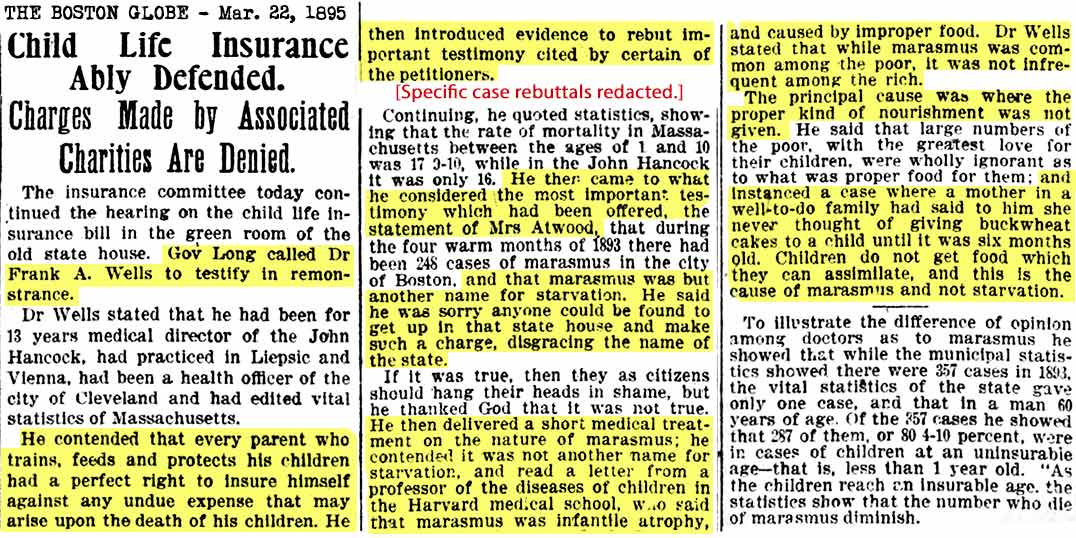
Marasmus: Definition, Symptoms & Causes (clevelandclinic.org)
Marasmus: Its Causes, Symptoms, Treatment,
and More (webmd.com)
Marasmus: Symptoms, Treatment, and More (healthline.com)
Marasmus: Background, Pathophysiology, Body
Composition (medscape.com)
|
|
THE OLD
STORY:
HUGH
MACFARLANE HEADS SOUTH TO "START A NEW LIFE"
"Hugh
decided to begin a new life by moving to New Orleans"
so the story goes. TampaPix has found no evidence of him
practicing law in New Orleans or Louisiana, on
any online official records or newspaper articles. This
may be due to the scarcity of New Orleans newspapers
online. To
practice law in Louisiana, he would have had to apply to
the courts to be admitted.
HOW DID HUGH
GET TO NEW ORLEANS?
If Hugh left
via Newport, RI by steamship, as
rumored, he would have sailed down the
U.S. east coast, maybe stopping at
various ports along the way--maybe
Charleston, SC, and maybe even Cuba.
Routes from Havana almost always included a stop at
Key West. From there, the common routes were to
Tampa by H.B. Plant steamer, and then from Tampa to New Orleans. So if he left Newport by steamer, the was a
very good chance his first knowledge of Tampa would have been
by seeing it, and not just by hearing about it in New
Orleans.
His
sudden departure from Fall River may be the reason for
lack of evidence of his presence in New Orleans. Hugh did NOT mention on his passport application of 1909 that he
spent any time in New Orleans.
The story
goes:
It was in the sunny
Southern city (New Orleans) that Macfarlane first heard about Tampa, a
tiny coastal village along Florida’s west coast. Stories
of the village evidently intrigued him, since he decided
to move to the sleepy Gulf Coast settlement in 1884,
when he was thirty three years of age.2
(He actually would have been 32.)
BUT DID
THAT REALLY HAPPEN?
Is this really why he came to Tampa? Because he was
"intrigued" by "stories" that he had heard? Or is this
old story a writer's conclusion? The writer uses
"evidently" and "since he
decided" which indicate these to be conclusions
not based on any evidence.
Find the
answer below.
|
|
|
|
DAVID MACFARLANE MOVES TO FLORIDA FROM
FALL RIVER, 1884
David
was the first of the Macfarlane brothers
to move to Florida.3
He came
to Jacksonville from Fall River by March
1884 with his wife and three daughters,
to join with his brother-in-law
William T. Simmons at W. N Emery boot and shoe
company.3
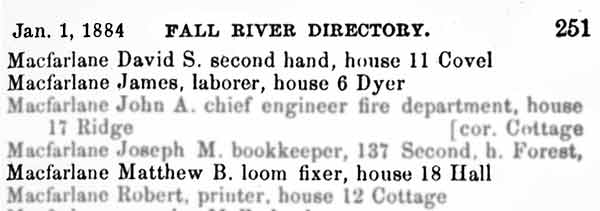

David was in Fall River in 1883, but
moved to Tampa by March 1884. Notice
also his brother Matthew B. Macfarlane
was not listed on the 1885 directory.
He too had moved to Jacksonville.
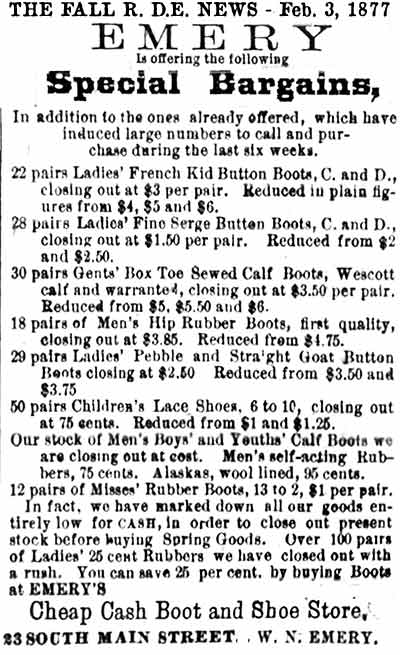 THE
EMERY BOOT & SHOE CO. THE
EMERY BOOT & SHOE CO.
Around 1876, William N.
Emery (son of British born
immigrant and shoemaker
Joseph Emery) opened a boot
& shoe business in Fall
River at 23 Main St. It
was a large store located across from
the Pocasset Mill Co. The
business thrived and by the
end of 1877 Emery purchased
the building for $4,000 from Wm S.
Remington from whom he had
been leasing.
In early Sep. 1878, on
account of ill health,
William N.
Emery disposed of all his
inventory to the Preble brothers
and leased the store to them
for "years." In Nov.
1878 Emery advertised
a large room, 18 x 50, next
to his store, partly
furnished and suitable for
any business, $20 per month.
In late Dec. 1878 Wm. N.
Emery decided to take a ship
from New York to Florida and
reside in Cedar Keys until
April 1, 1879 due to his
poor health. He
apparently regained his
health because in early May,
1879, he bought a two-story
boat house with French roof,
including land from the street to
the beach, at Stone Bridge,
Tiverton, R.I.
In the Jan. 19, 1880 Fall
River Daily Herald, it was
announced that William N.
Emery had gone back into the
boot & shoe business in
Jacksonville.
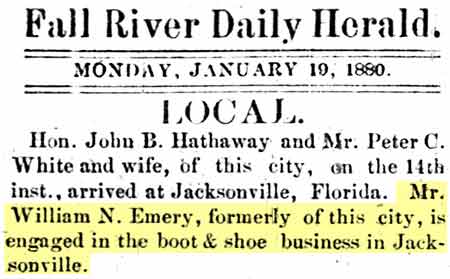
Emery's father, Joseph
Emery, "formerly in the boot
and shoe business," died at
age 70 in Fall River on May
9, 1880. His son
William was appointed
executor of his estate.
The May 12 FRDEN stated that
"Mr. Emery has closed his
boot and shoe business at
Jacksonville and will remain
in this city for the
present. He arrived home a
few hours before his
father's death and had a
very brief conversation with
him before he passed."
(As previously covered,
at this time, David, wife
Emma and their two daughters lived with
his wife parents and her
brother William T. Simmons
in 1880 in Fall River. In June that year,
Charles F. Emery
(relationship to William is
unknown) & David S.
Macfarlane were confirmed as
constables in Fall River.
David continued as a
carriage maker in 1880 after
which he worked in the
carding rooms of the Pocasset
and Stafford Mills.)
According to this Mar. 7,
1884 FRDEN article below,
W.N.
Emery re-opened the shoe
business in Jacksonville in 1881. (Computed from
the article's information.)
Now in 1884 he had two partners,
William T. Simmons, and
George Emery. William
T. Simmons was David
Macfarlane's brother-in-law, George Emery was
William's younger brother by
a few years.
The company
had TWO large stores in
Jacksonville, and branch
stores in Fall River, St.
Augustine, and TAMPA, "the
last having been recently
opened."
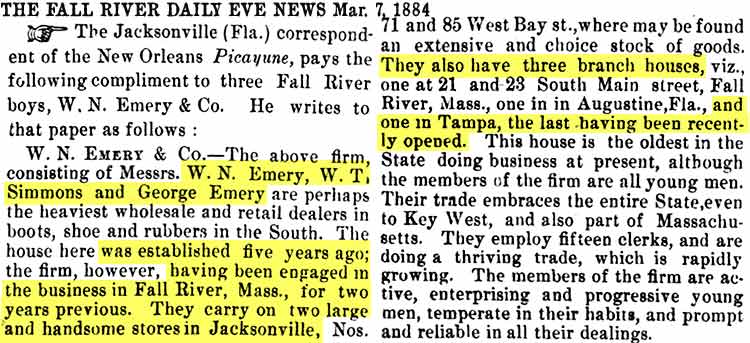
|
|
|
THE
MACFARLANE BROTHERS IN TAMPA |
|
DAVID
MACFARLANE, FROM JACKSONVILLE TO TAMPA
BY MARCH 1884.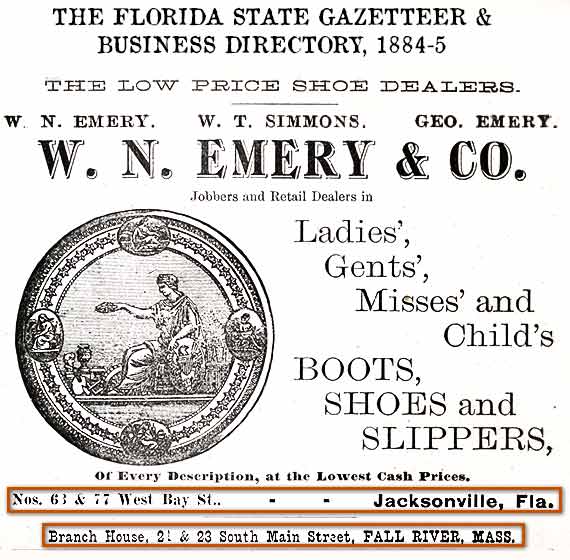
David was
the first of the Macfarlane brothers to
come to Tampa. From
Jacksonville, David and his family came
to Tampa in 1884 by March
to take charge of
the newly opened branch store for Emery, Simmons &
Emery3 on the 400 block of
Franklin St, next to Branch's opera
house. His
original position in Jacksonville was
replaced by his brother, Matthew.3
Matthew would have been around 23 years
old at the time. David was 26.
As
found on David's 1900 Census in Tampa,
David & Emma's daughter, Emma Simmons,
was born in Florida in March, 1884.
It is likely she was born in Tampa.
.
The Florida Gazetteer & Business directory
released for 1884-85 (which covers 1883)
doesn't list a branch in Tampa yet.
EMERY, SIMMONS & EMERY
BOOTS & SHOES, TAMPA
This photo below was dated "circa 1870" by the UF Digital Collection.
The actual date can
only be from 1884 to 1885. It is the south half of the 400 block of Franklin St.,
being the northwest corner of Franklin and Lafayette St, across
from Courthouse Square. Courtesy of the UF Digital
Collection, the photo is by J.C. Field.
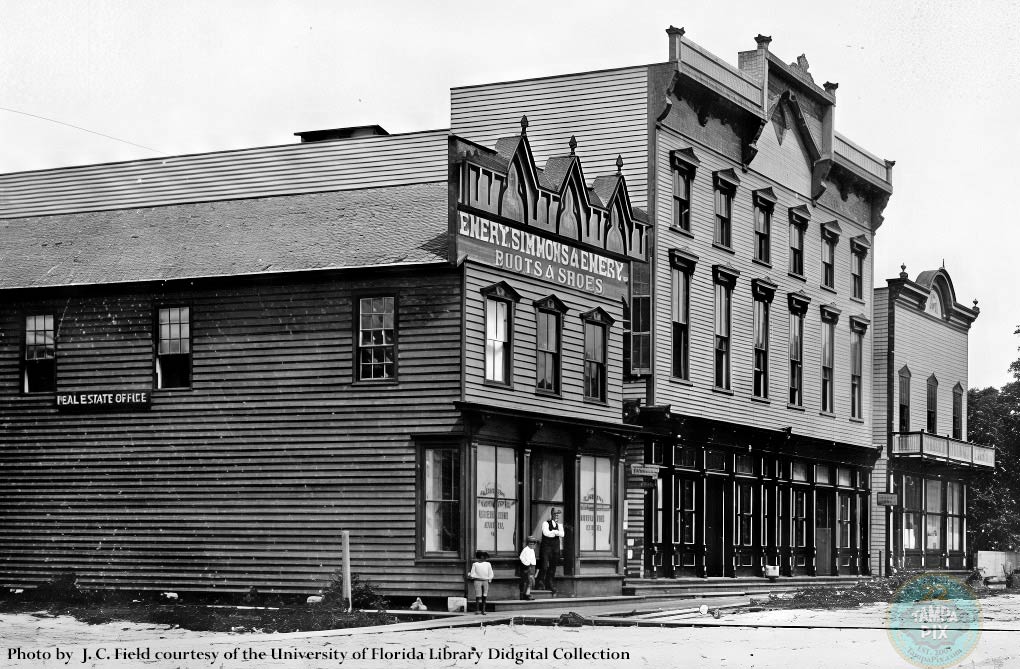
Photo by James C. Field*
PROOF OF ACTUAL PHOTO DATE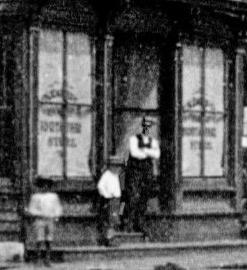
Already we know that on the 1880 census David was
in Fall River living with his wife and children in the
Simmons family home, including William T. Simmons.
So it's impossible for Emery, Simmons and Emery to have
existed in the 1870s.
William T. Simmons would have been 15 in 1870 and too young to
be a partner in any company. It has been shown
previously above that Emery,
Simmons & Emery didn't exist until 1881.
The photo above can be no earlier than March 1884 when the
store was opened and probably no
later than 1885 which at that time David had bought
out
the Tampa store and it became "Macfarlane & Co."
That could even be
David standing in front of the store.
|
|
DEATH CERTIFICATE OF JAMES COOLEY FIELD, COMMERCIAL
PHOTOGRAPHER, 1934
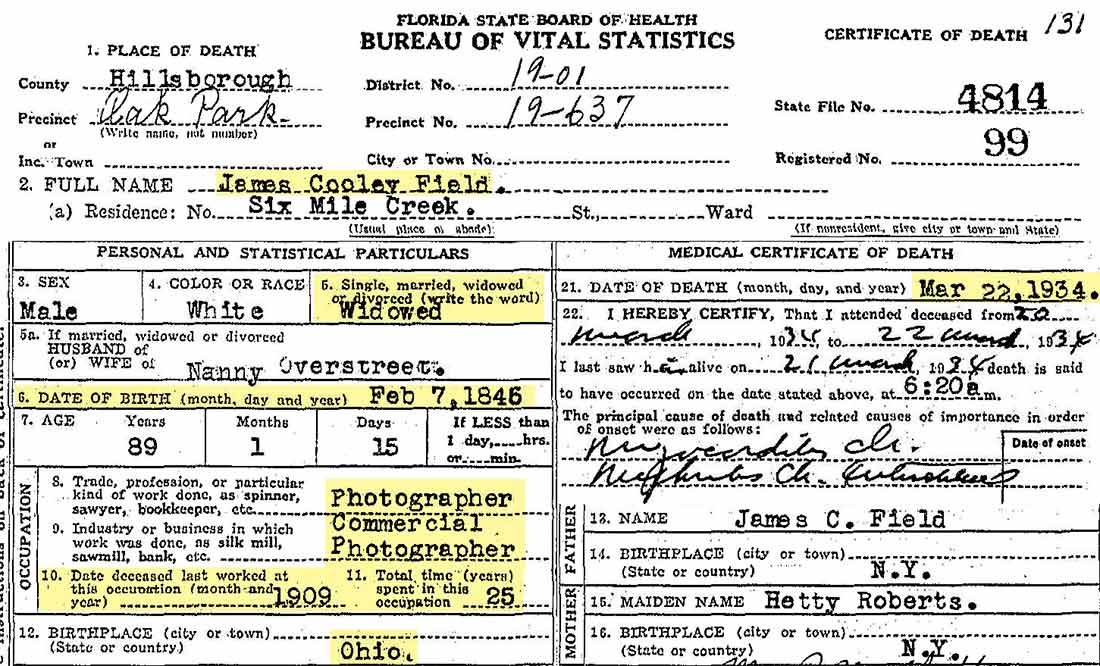
James Field's death certificate
shows he last worked as a photographer in 1909 and he
had been in the business for 25 years. This puts
his start in the business in 1884.
The first photo of the boot & shoe store may have been his
first commercial job. He was probably hired by Emery or Simmons, or even
David, to take pictures of the new store for
advertising purposes.
Click to see larger. |
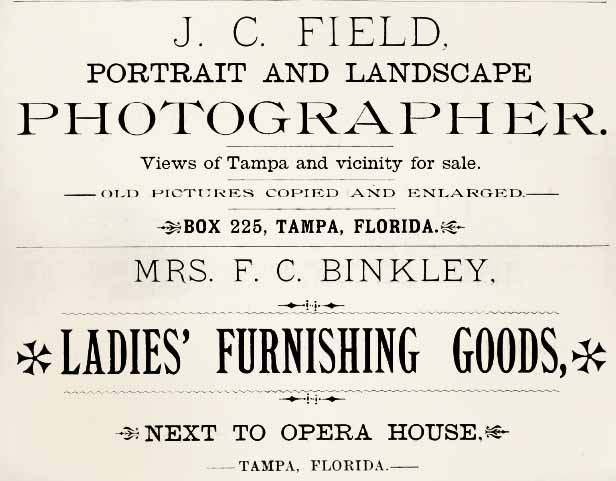 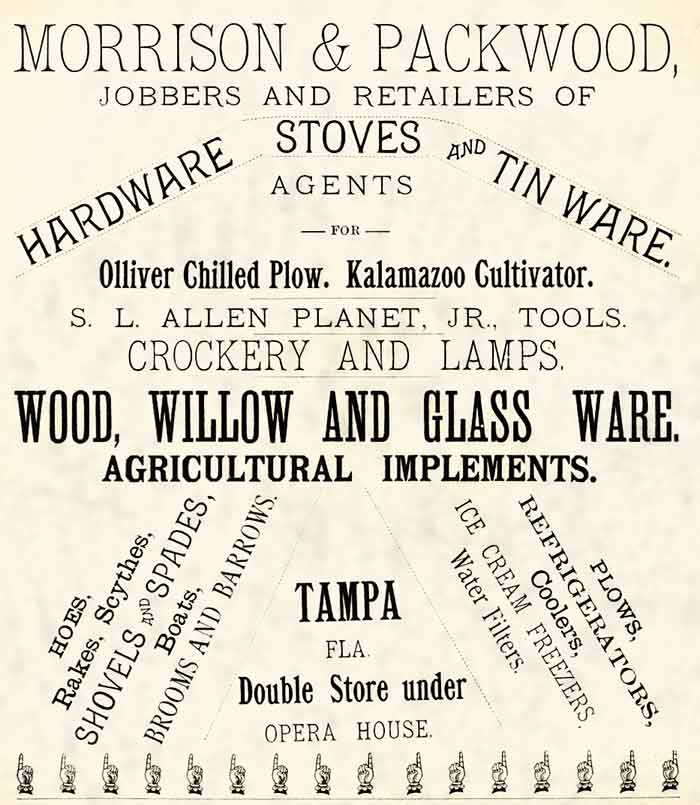
Courtesy of
Descriptive pamphlet of Hillsborough county, Florida by
Hillsborough county real estate agency, Tampa, Fla.
Publication date 1885
at Internet Archive.
WHEN DID
HUGH MACFARLANE ARRIVE IN TAMPA?
TampaPix has viewed every page of Hillsborough County on
the 1885 Florida State Census and no record of Hugh was found.
Unfortunately, there are no Tampa
newspapers that survived to
be scanned for the years 1884 & 1885. However, there is newspaper
evidence that Hugh was in Tampa by Feb 1885.
As the story goes, Hugh arrived in Tampa
in March of 1884 as an experienced lawyer with a law degree from
Boston University and six years (some say eight years) of practice experience.2
(Depending on the exact date, this is around at least
one to four weeks after David's arrival.)
It is concluded here that
Hugh actually practiced law in Fall River for a period of
only TWO
years, FIVE months. (From Jan. 1, 1879, the date he was
admitted to practice in Fall River, through June 22,
1881, the time of his disappearance.) He
would have been around 29 and a half years old when he
left Fall River and just a few months past his 32nd
birthday when it is said he arrived in Tampa.
If Hugh left Fall River at the time the
papers reported his disappearance, June 1881, and
if he arrived
in Tampa in March 1884, he would be missing 2 years,
9 months in between. Assuming Hugh was in
New Orleans and had been admitted to
practice law the entire time he was there,
his total time of
practicing law before Tampa would be five years, two
months, at the longest.
1Assumed
2Generally accepted modern history.
3THE FALL RIVER DAILY EVENING NEWS, Apr. 15,
1905 "Are Leaders In Florida."
EMERY & SIMMONS WERE INTO MORE THAN THE SHOE BUSINESS
IN TAMPA
On Jun. 10, 1885 Emery & Simmons filed a subdivision plat for a
development surrounding the east, north and west borders
of Oaklawn Cemetery. They may have seen that the
City would be needing more cemetery space and had
purchased the land with intent to resell it. By
the end of the 1880s, the City of Tampa would be looking
for more cemetery space. Today, Constant St. is Laurel
St. Notice Emery Street which does not exist
today.
PLACE YOUR CURSOR ON THE MAP TO SEE THE AREA TODAY
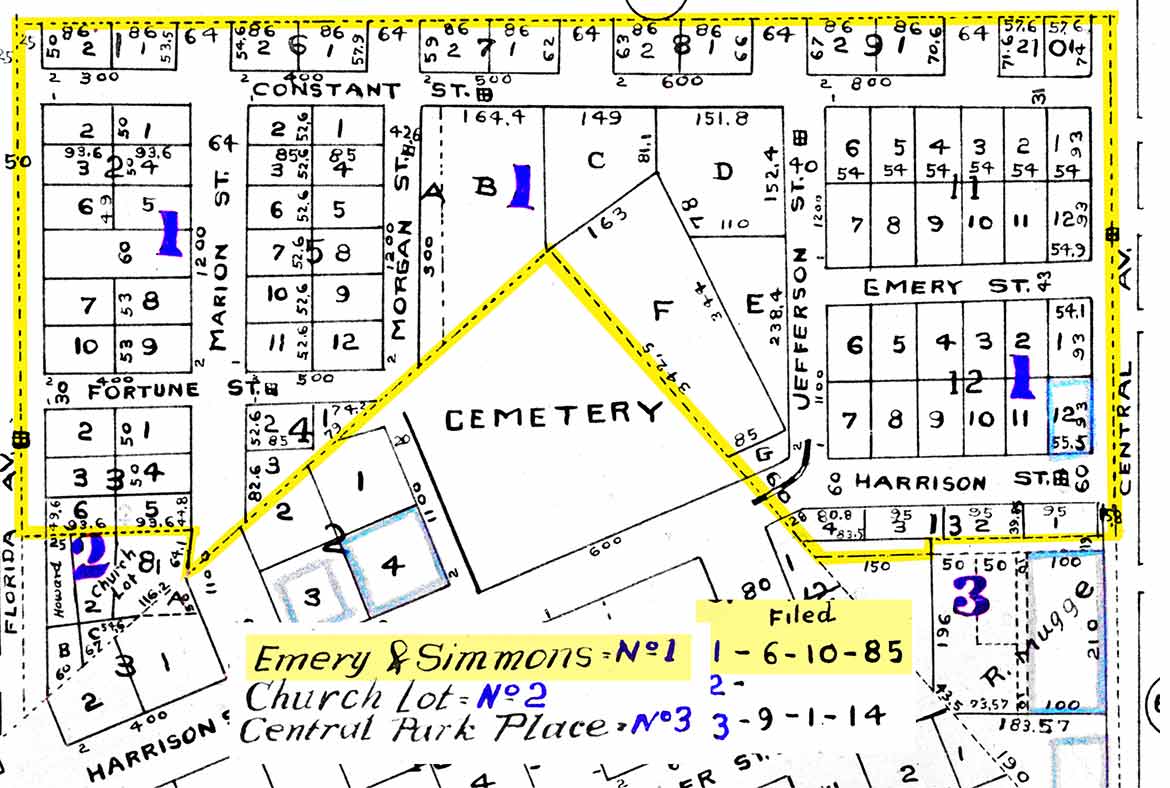
|
After David
arrived in Tampa, he "sent for Hugh in New Orleans"3
The old history of
why Hugh came to Tampa, "stories of Tampa he heard
in New Orleans must have
intrigued him because he
came to Tampa..." etc. is a
conclusion reached by
writers who could only guess
why Hugh came here.
They were not
aware that David came here
first and sent for his
brother to come from New
Orleans. It is not
known how long after David
arrived in Tampa that he
contacted Hugh in New
Orleans. |
HUGH
MACFARLANE IN TAMPA WAS EDITOR OF J.T. MAGBEE'S
TAMPA GUARDIAN NEWSPAPER
Hugh and James T. Magbee were
both missed by the 1885 Florida State Census
enumerators in April 1885, but Hugh's 1885 whereabouts
were published in the Weekly Floridian**, a Tallahassee newspaper, in
February that year. Concluded from this article in
a Tallahassee newspaper, Hugh Macfarlane had become an
editor of The Tampa Guardian, the newspaper of attorney
and former infamous judge, James T. Magbee. One
possibility as to why they both were missed by the
census would be that Hugh may have been renting a room
in Magbee's large home.
**Magbee's adopted son, Archie Donnelly
Magbee, worked as a printer of the Weekly Floridian.
|
At right: A
sketch of the Guardian
building which appeared on
the paper's subscription
information page. The
left end of the house was
where the print shop was
located (according to D. B. McKay.)
Magbee's second wife, Julia
Henderson Magbee, had been the assistant editor for
several years, but she died in January 1885. The death
of this "brilliant and pungent
writer" was a heavy blow to the aging lawyer
and newspaperman. The Pensacolian newspaper wrote
"Mrs. Magbee was a very
estimable lady, favorably
and widely known in this
State, and had been
associated with her husband
in |
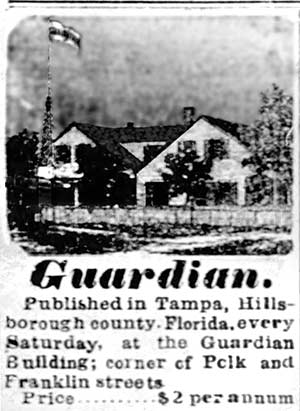 |
-HC-Macfarlane-retired-fro-editorship-Guardian.jpg)
Above: This Feb. 10, 1885 article from THE WEEKLY
FLORIDIAN shows Hugh Macfarlane had been the editor of the Guardian
for an unspecified period of time and had
left the position at this time. A. D. Magbee
was James and Julia Magbee's adopted son, Archie Donnelly
Magbee, who attended the Fla. Seminary school in
Tallahassee and had become the printer of its newspaper, and
worked for the Weekly Floridian in the printing room.
|
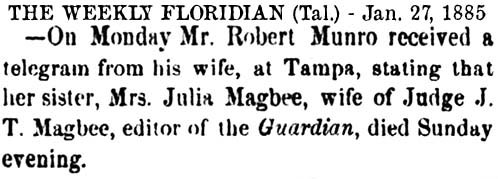 the
editing of his paper."
Magbee
may have hired Macfarlane
after Julia's death or even
before if she had been too
sick to work on the paper. Magbee lived
on the north side of Polk Street between Tampa St. and
Franklin St. and it was from here, in the "Guardian
Building" that Magbee, for ten
years, published his highly opinionated newspaper in his final years.
It is highly unlikely he was
overlooked by any enumerator
of the 1885 census, as
Magbee was well-known and
his home/office was quite
large. He and
Macfarlane may have just
been away. the
editing of his paper."
Magbee
may have hired Macfarlane
after Julia's death or even
before if she had been too
sick to work on the paper. Magbee lived
on the north side of Polk Street between Tampa St. and
Franklin St. and it was from here, in the "Guardian
Building" that Magbee, for ten
years, published his highly opinionated newspaper in his final years.
It is highly unlikely he was
overlooked by any enumerator
of the 1885 census, as
Magbee was well-known and
his home/office was quite
large. He and
Macfarlane may have just
been away. |
| According to D. B.
McKay's Pioneer Florida,
V.2, Ch. 10, "A
Self-Made Scalawag" 1959: |
|
Magbee owned the entire
block bordered by Franklin,
Cass, Tampa and Polk
streets. His fine home was
on the site now occupied by
the J. C. Penney store
(1959), and adjoining the
residence on the west was a
large building (for those
times) in which he had a
modern printing plant. From
this plant he issued a
weekly newspaper, the Tampa
Guardian.
D.B.
McKay claims that as a young
boy, he worked for Magbee in
his print shop. McKay
would go on to become the
owner and publisher of the
Tampa Times and the mayor of
Tampa for four terms. |
Magbee also owned
property in what
became Tampa Heights, including the area of the spring we now call
the Ulele Spring. Back then it was known as the Magbee
spring. Could Hugh have seen all this land
on the east bank of the Hillsborough River, and looked
across at the west bank seeing no development? Could
this have been Hugh's first interest in developing West Tampa?
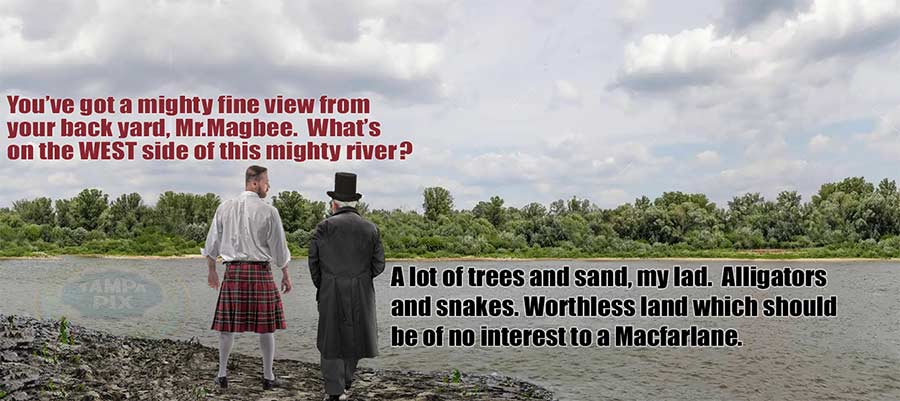
(Not a proven encounter.)
|
THE TAMPA BOARD OF
TRADE ESTABLISHED - May 7, 1885
In the 1870s, a period in Tampa referred to as the
"Dismal Decade," Tampa had shrunk to approximately 726
citizens by the time the 1880 census was taken. Tampa
was struggling for growth. After this population
decrease, there were signs of revitalization. Still, in
1883, there were few businesses, no real port, and few
prospects until Henry Bradley Plant extended his South
Florida Railroad into Tampa in late Jan. 1884 as the
line between Tampa and Kissimmee was completed.
H.B. Plant's railroad led to sudden growth in Tampa, and
by 1885, Tampa’s population had grown to nearly
3,000 residents. That’s the way it was, on Thursday
night, May 7th, 1885 when a mass meeting was called at
Branch’s opera house for the purpose of taking on on
some of the area's biggest problems: heavy traffic, lack
of bridges and how to attract new businesses.
Read
more about the coming of the railroad to Tampa here at
TampaPix's James T. Magbee feature.
READ ABOUT THE DR. FRANKLIN BRANCH FAMILY OF TAMPA
PIONEERS AND BRANCH'S OPERA HOUSE
THE TAMPA BOARD OF
TRADE'S ROLE IN THE FOUNDING
OF YBOR CITY
|
DAVID MACFARLANE AND FAMILY ON THE 1885 STATE CENSUS
OF FLORIDA
David is listed as "D. S. Macfarlane" on the first page
of the Florida state census in April 1885. He is with his wife
Emma A. (Simmons) and four
daughters. Their first three
daughters, Annie M (Margaret)., Sarah H. and Eliza were
born in Mass., Daughter Emma was born
in Florida and her age indicates David and
his family came to Florida in 1883 or 1884. The
Macfarlane's might be living upstairs over the store at
this time.

The next person enumerated after the Macfarlanes was
Harry E. Cleveland. He was 23, five years younger
than Daivd, and also a merchant.
The ad below shows that by
1885, David had bought the boot & shoe business from
Emery, Simmons & Emery and partnered with Harry E.
Cleaveland to operate "Macfarlane & Cleaveland" at the
same location at Franklin St. & Lafayette.
Nothing more can be found about Harry
Cleaveland. David probably partnered with him to
buy the business from Emery Simmons Emery.

Courtesy of
Descriptive pamphlet of Hillsborough county, Florida by
Hillsborough county real estate agency, Tampa, Fla.
Publication date 1885 at Internet Archive.
This photo below appears
to be taken around 1885 to 1886 judging by the lack of Emery
Simmons signage on the building,
and only a "Boots & Shoes" sign. It shows the
opera house in the center and grocery store on the
right, is from the Theodore
Lesley collection and was published in "Tampa Town" by Tony Pizzo.
The caption in this book says David was
in business with Harry Cleveland.
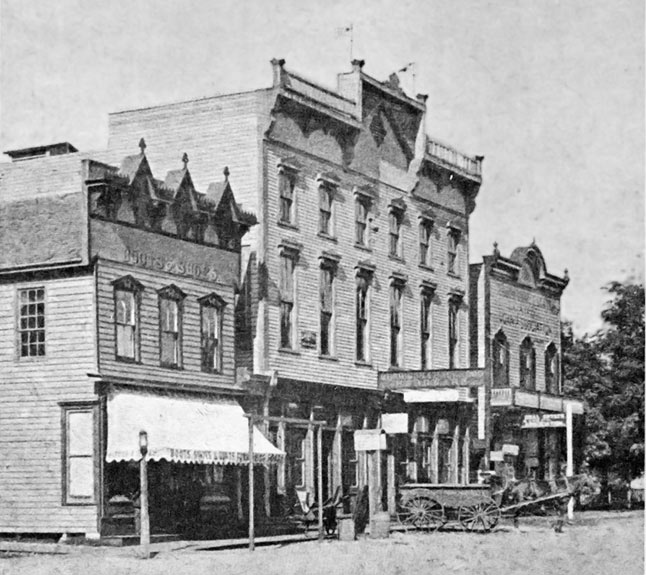 |
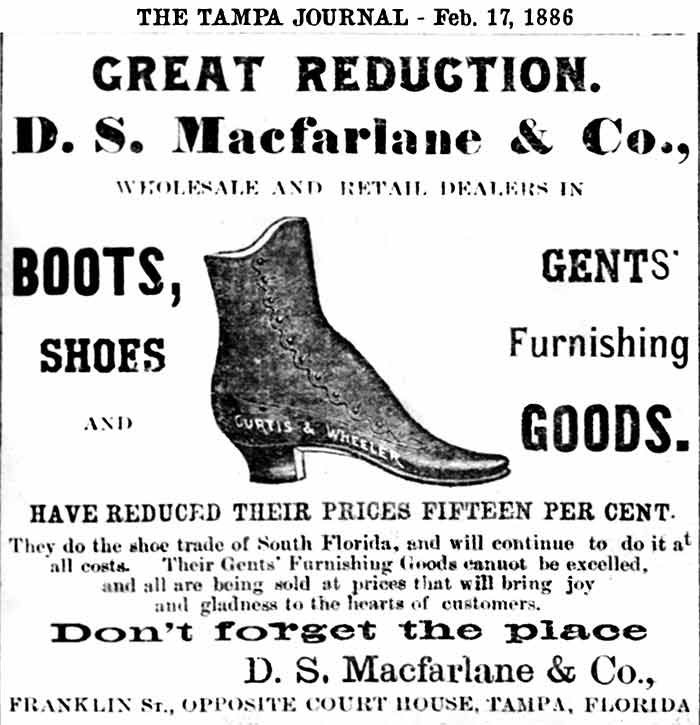
HARRY
CLEAVELAND GONE
Above: David's advertising of early Feb. 1886
is for "D. S. Macfarlane & Co. and doesn't mention Harry Cleaveland.
Perhaps the shoe didn't fit Harry. |
| |
|
|
| |
|
HAMMOND
& MACFARLANE, ATTORNEYS AT LAW
By
November of 1885, Hugh had entered into a law
partnership with D. F. Hammond. On the 1885 State
Census in Tampa, Hammond was a 65 year old attorney from
South Carolina. Hugh was 33 at this time.
In the Florida Supreme
Court, Hugh Macfarlane and D.F. Hammond represented
James T. Magbee in at least two real estate related
lawsuits, one involving Thomas Jackson, son of Tampa's
first surveyor and pioneer John Jackson.
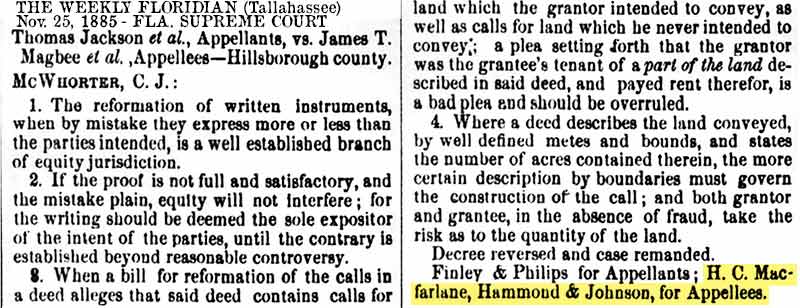
After James Magbee died in Dec. 1885, there
was a legal battle over his estate between
his widow, Carrie Burr Nolan Fisher Magbee
(she was his 3rd wife and had signed a
two-way prenuptial agreement with Magbee),
and Magbee's sisters. Hugh represented
the Magbee siblings for their claim that the
prenup voided Carrie's claim to any part of
Magbee's estate. Complicating matters
was the fact that an old will of Magbee's
was found where he left his estate to Julia
and their adopted son Archie, but the
section about Archie had
been marked "Cancelled." In the end, the
ruling was that Magbee's widow Carrie would
get one-third, and his two siblings would
get two-thirds. |
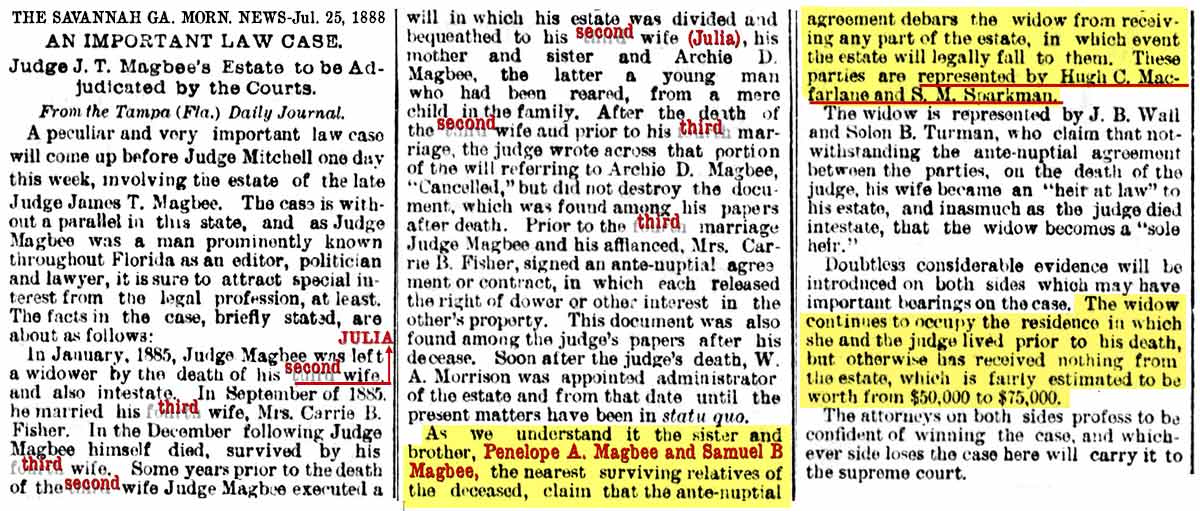
Not long
after the settlement, Magbee's land began being
subdivided and lots sold off, leading to the subdivision
of Tampa Heights and development by W. B. Henderson (who
ironically despised Magbee with a passion like no
other.)
|
|
|
MATTHEW BIGGAR
MACFARLANE ARRIVAL
IN TAMPA
After working for
the Emery, Simmons &
Emery company in
Jacksonville, Matthew came to
Tampa with his
family to study the
law with his brother
Hugh in mid to late
1886. According to a
biography
of Matthew in 1911
"Makers of America,"
Matthew took up
study of the law in
Jacksonville but
makes no mention of
his time with Emery,
Simmons & Emery.
Unlike Hugh, a
Democrat, Matthew
was an avid
Republican, of which
there weren't many
in Florida or in
Tampa. But he
quickly became a
well-known lawyer
and leader of the
party.
|
|
WESTFALL:
Hugh Macfarlane
quickly blended into
the local political
activities, joining
prominent Tampans in
organizing the Tampa
Board of Trade, May
7, 1885.
Unquestionably, the
Board’s most
important
accomplishment would
be its later
inducements to lure
cigar manufacturers
to Tampa.
Some time from
September to
December 1886, Hugh
dissolved his
partnership with
Hammond and
partnered with his
brother, Matthew B.
Macfarlane who had
been studying the
law with him.
|
|
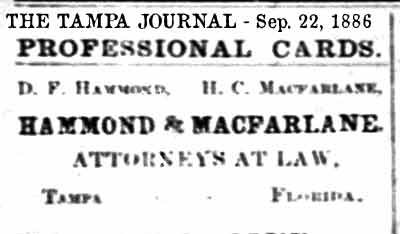
The last published
ad for Hammond &
Macfarlane |
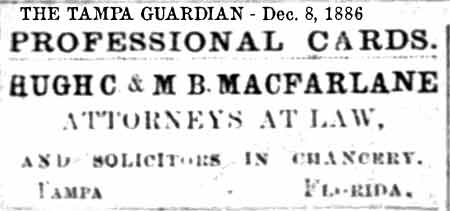
The first published
ad for Hugh and M.B.
Macfarlane |
|
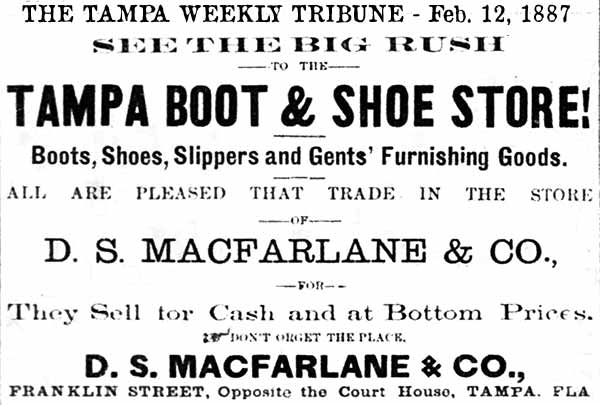
|
April 1887 - Hugh
teamed up with John
R. Jones to acquit
their client of
defamation charges.
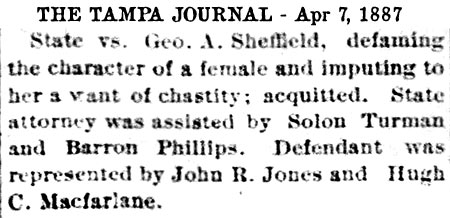 |
|
WEDDING BELLS FOR
HUGH MACFARLANE
On April 14, 1887,
Hugh Macfarlane
married Frances Ida
Pettingill at the
home of her mother.
Frances owned a book
store and
stationers company
named "Pettingill &
Co."
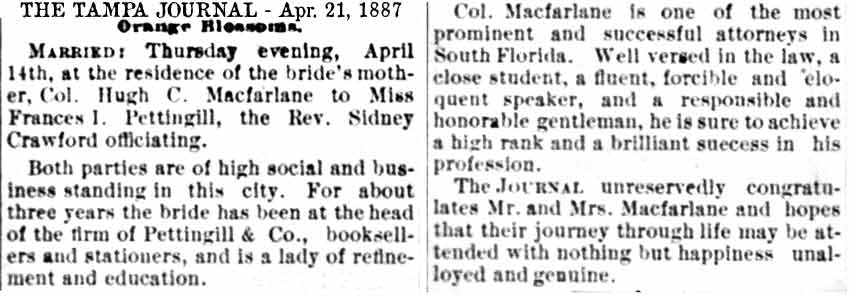
THE PETTINGILLS ON
THE 1885 STATE
CENSUS IN TAMPA
On the 1885 State
Census of Florida,
Frances was living
with her brother "NBK"
and widowed mother
Caroline A.
Pettingill who was
59 and born in
Maine as was her
mother.
Caroline's
father was born in
England.
Frances was 29 and a
merchant. Her
brother, Noah Brooks
Kent Pettingill was
a 22 year old student, probably
studying law.
 |
| |
|
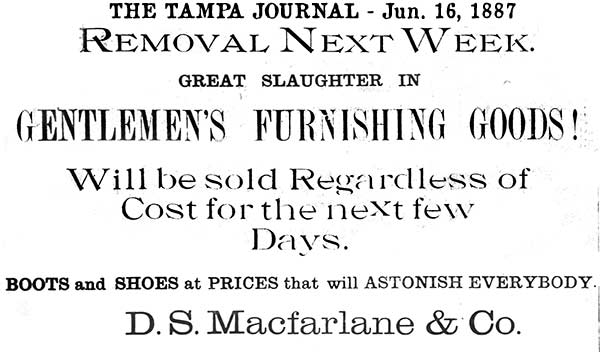
D.
S. MACFARLANE & CO. MOVES TO THE
SPARKMAN BLOCK,
June. 23 1887

|
BELOW
RIGHT:
Hugh's
background
in
coming
to
America,
and his
college
education.
Hugh
practiced
law in
Fall
River
for a
period
of 2
years, 5
months,
NOT
several
years.
Praise
for
Hugh.
Matt
Macfarlane
was only
26.
He came
to Tampa
about
1885 and
was
admitted
to
practice
law in
1886.
It
remains
to be
seen if
Matt
attended
any
college
or
university
at all. |
|
BELOW:
David's
arrival
with his
parents,
his
arrival
in Tampa
in 1884
as
manager
of the
Emery
et. al.
shoe
store,
"but
within a
year he
bought
the
stock
and has
successfully
run the
business.."
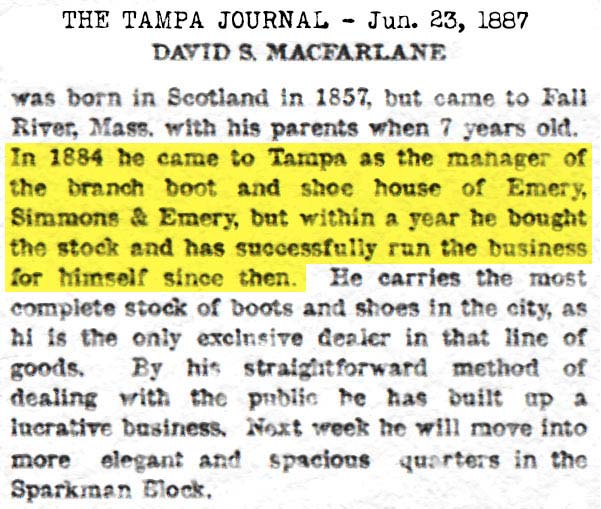 |
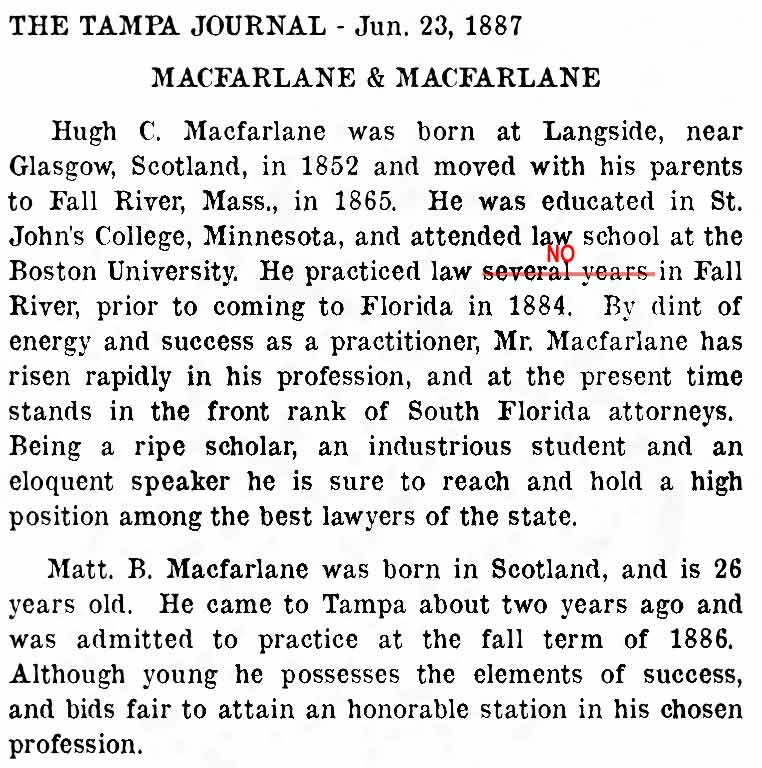 |
BELOW: The
map below has been
pieced together from
four blocks of the
1887 Sanborn Fire
Insurance maps of
Tampa from the UF
Digital Map
collection.
The four blocks have
been moved closer
together to conserve
space thus making
the streets
narrower. The
actual width of the
streets are
indicated by the
outer four corners
of the blue square
at the center.
Macfarlane's new
location is exactly
where the first
Hillsborough Co.
High Public High
School was located
in 1882, in a wood
structure here
before the brick
buildings were
built.
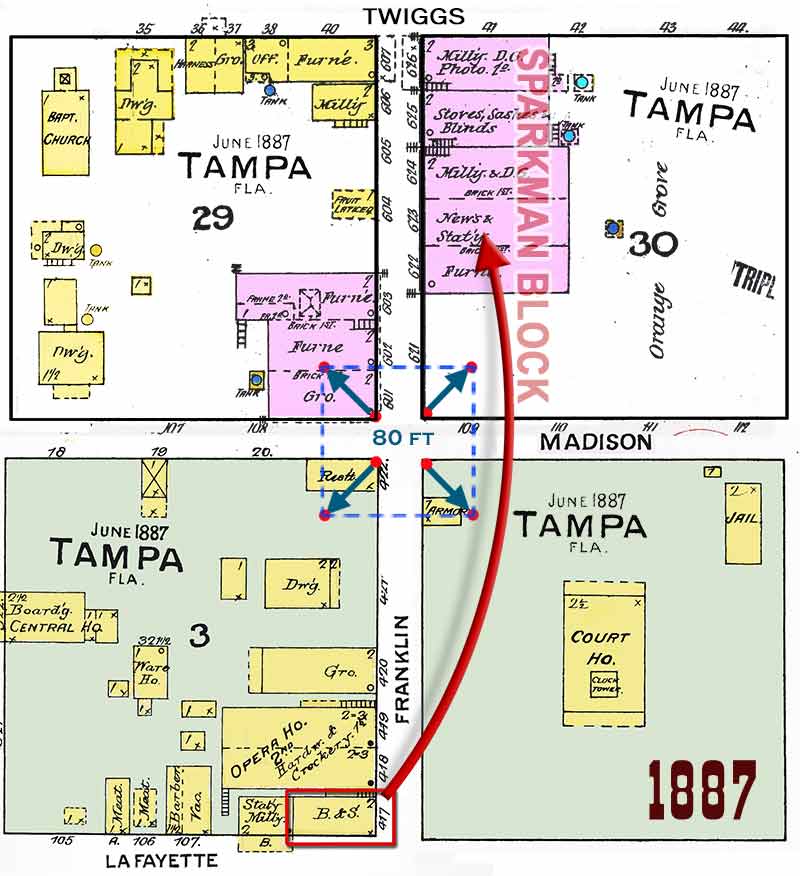
The County Courthouse in use at this time is the one see
below, built in 1852 by John Breaker, the clock was
added in 1886.
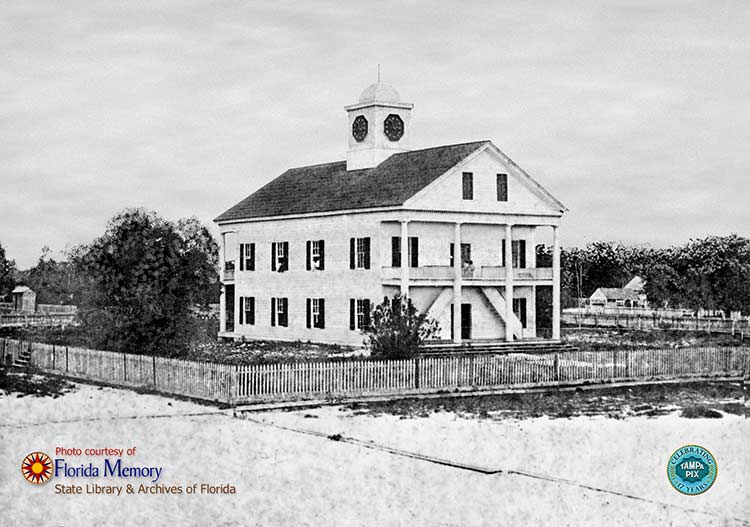

Mostly illegible.
|
THE CITY OF
TAMPA IS BACK
The City of Tampa
was re-established
on June 2, 1887 when
under special act of
the state
legislature, the
Governor signed a
bill that granted
the city of Tampa a
new charter,
abolishing the town
governments of Tampa
and North Tampa.
Section 5 of the
charter provided for
a city-wide election
for mayor, eleven
councilmen and other
city officials, to
be held on the 2nd
Tuesday in July. The
new charter also
greatly expanded the
corporate limits of
the city. Tampa now
took in North Tampa,
Ybor City and some
land on the west
side of the
Hillsborough River.
It was after a mayor
was elected and
seated along with a
city council that
Tampa is said to
have been
"organized" on July
15, 1887.
THE CITY OF
TAMPA'S FIRST
ELECTION
- "...a
disgrace to an
intelligent and
civilized community.."
In a hotly
contested race under
provision of the new
city charter, on
July 12, 1887,
George Bascom
Sparkman was elected
mayor for his 4th
term, defeating
Henry C. Ferris, 283
to 269. Other
elected officials
were J. Lamont
Bailey-Clerk and
Treasurer; W.T.
Haskins-City
Marshal; J. C.
Robbins-Tax Assessor
and A. M.
Fleming-Tax
Collector. City
Council members
included: Charles E.
Harrison-President,
William Benton
Henderson-President pro
tempore, William A.
Honaker, Isben S.
Giddens, Henry
Laurens Knight,
Frederick M. Meyer,
Silas L. Biglow,
Candido Angel
Martinez-Ybor,
Joseph A. Walker,
Charles N. Brigham,
and James E.
Mitchell (died
11/26/1887, and
apparently his
vacancy was not
filled.) Source:
Council Minute Book
2, page 59.
|
Tampa
had 895
registered
voters
in 1887
and the
Tampa
Journal
reported
that
only 575
of these
men
exercised
their
opinion
- only
64%. Mr.
Sparkman
was
elected
as the
new
Mayor by
14
votes.
The
Journal
reported
on the
election
as
follows:
As a
public
servant,
the
Journal
would
be
derelict
in
its
duty
if
it
passed
over
some
of
the
irregularities
and
disgraceful
occurrences
of
Tuesday’s
election
without
calling
attention
to
them.
It
was
such
an
election
as
we
hope
never
again
to
see
in
Tampa.
For
two
or
three
days
before
the
election,
whiskey
was
dispensed
free
by
some
of
the
saloons.
On
election
day
the
streets
were
lined
with
drunken
men;
the
most
obscene,
vulgar
and
profane
language
could
be
heard,
not
only
in
the
streets,
but
in
the
room
in
which
the
election
was
held.
Frequent
rows
and
fights
occurred,
and
during
the
entire
day
and
night
a
drunken
and
riotous
mob
held
possession
of
the
town.
Such
a
state
of
affairs
are
a
disgrace
to
an
intelligent
and
civilized
community,
and
the
Journal
desires
to
place
itself
on
record
as
being
opposed
to
any
such
proceedings.
We
denounce
the
buying
of
votes
by
any
man,
either
with
money
or
whiskey;
we
do
not
believe
in
coercion
or
intimidation,
and
we
call
upon
the
respectable,
law-abiding
and
intelligent
citizens
of
Tampa
to
see
to
it
that
the
like
does
not
happen
again.
|
|
Read more about what
happened during the
election and Tampa's
new charter.
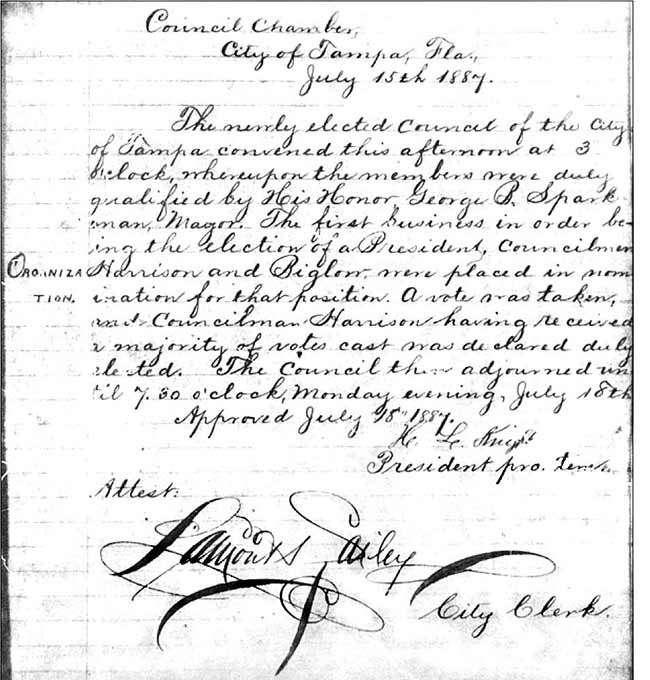
|
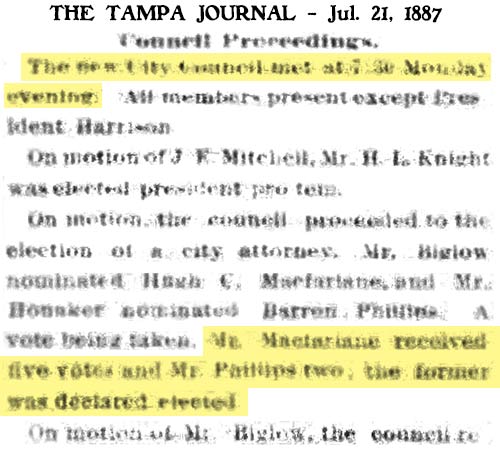
HUGH MACFARLANE
ELECTED FIRST CITY
ATTORNEY
On July 18, 1887,
at Tampa's second
city council
meeting, Hugh C.
Macfarlane was
elected 5-2 over
Barron Phillips as
Tampa’s first city
attorney under the
new incorporation.
Afterwards, numerous
City Council meeting
notes in the papers
mention the Council
making various
requests for the
city attorney to
draft new
ordinances.
Due to the extremely
faded condition of
these Tampa
Journals, much
information about
Hugh's
accomplishments as
Tampa City attorney
are illegible.
At their next
meeting, on July 25,
1887, it was
determined that the
City Attorney's
salary would be $800
per year.

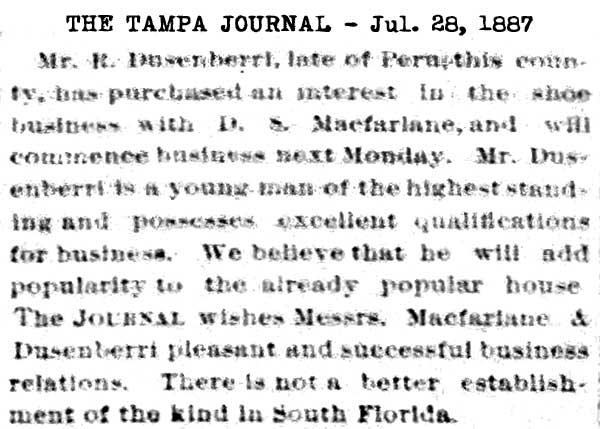 DAVID
MACFARLANE PARTNERS
WITH R. DUSENBERRI DAVID
MACFARLANE PARTNERS
WITH R. DUSENBERRI
This article states
that Mr. Dusenberri
was currently of
PERU in Hillsborough
County, which today
is known as
Riverview. The
usual praise is said
of him, "a young man
of the highest
standing and
possesses excellent
qualifications for
business."
Nothing else could
be found about Mr.
Dusenberri. |
A HOT TIME
IN THE NEW CITY
OF TAMPA
|
Aug 4,
1887 Tampa's fire at
Rotten Row
TAMPA SCORCHED - Tampa Journal, August 4,
1887
Thirty Business Houses and Residences Burned Estimated Loss $50,000
About two o’clock this morning a fire broke
out near the center of what is known as “Rotten Row,” composed entirely
of one and two story wooden buildings, and occupied mostly by small
tradesmen such as fruit stalls, retail groceries, barber shops, etc. on
one side of the street, and principally by saloons on the the other. The
fire seems to have originated either in Cole’s restaurant or Thomas’
barber shop, the flames spreading rapidly each way from the starting
point and soon enveloping the entire block in flames. It was some time
before any kind of effort could be made to control the fire, and for a
time it looked as though the whole business part of the city must surely
go, and the absence of any wind was probably what saved the best portion
of it. The fire department, however, soon got down to business, and by
the almost superhuman efforts of the firemen the flames were prevented
from being communicated to the buildings across Lafayette street,
extending north, thus saving the Opera house, Gunn & Seckinger’s large
grocery store and other valuable business blocks.
It was the prevailing opinion that nothing
could be done to save the buildings on either side of Franklin street
between Lafayette and the ditch, and all the efforts of the firemen were
directed to preventing the spread of the flames to the adjoining blocks,
and that they were successful in this measure was certainly not due to
the completeness of our water works system, but to the untiring efforts
of the people. The old hand engine did good service as long as water
could be had, when bucket brigades were formed and the sides of the
buildings kept thoroughly drenched. . . .
|
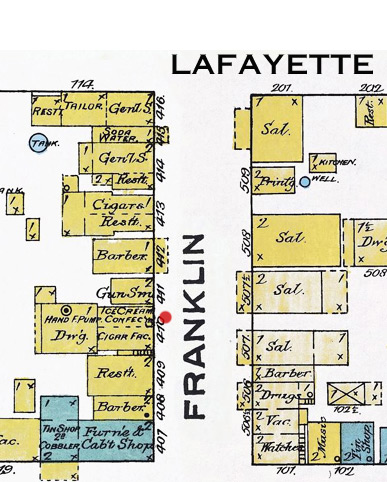
Place your cursor on the map
to see this area in 1889
|
|
By 4:30
o’clock
the two
blocks
above
mentioned
were
burned
to the
ground,
very
little
of the
contents
being
saved,
although
the
utmost
good
will
prevailed,
and
everybody
did what
they
could to
assist
their
more
unfortunate
neighbors.
THE
FIRE
The
Journal
deeply
sympathizes
with all
who lost
their
property
in last
night’s
conflagration.
. . .
But
aside
from the
hardship
entailed
upon
those
who
directly
suffered
loss,
the
effect
upon the
city can
not fail
to be
otherwise
than
beneficial.
Two of
the
finest
business
blocks
in the
city are
now open
for
substantial
and
valuable
improvement.
The real
value of
these
blocks
this
morning
is
greater
than it
was
yesterday;
and we
believe
that
within
one year
from
this
date,
instead
of the
former
shanties
that
stood
yesterday
[as an]
eyesore
to the
citizens
of
Tampa,
will
tower
magnificent
brick
blocks.
|
|
|
Ida Pettingill
Macfarlane closing
down her store,
letting husband Hugh
be the sole
breadwinner of the
family.
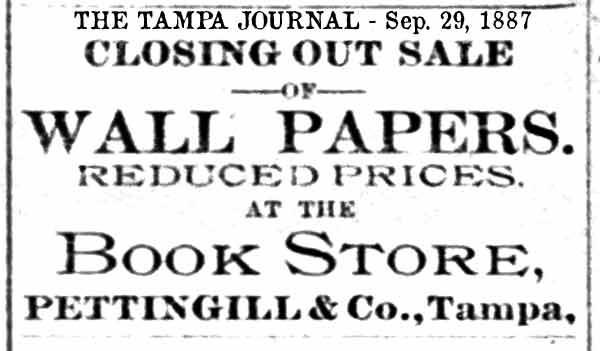
. |
On
May 5, 1888, the
name of Monroe St.
was changed to
Florida Avenue
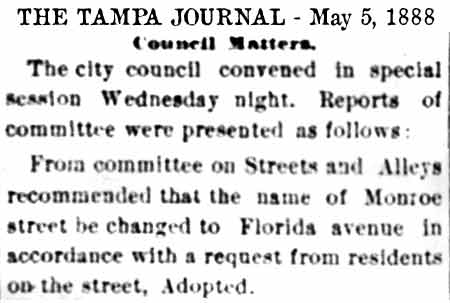 |
|
GEORGE RAE
MACFARLANE
George Rae
Macfarlane was born
in 1861 in Glasgow,
Scotland, the only
currently known son
of Andrew
Macfarlane, brother
of James D.
Macfarlane.
According to his
obituary, he
received a liberal
education in
Glasgow, studying at
Glasgow University
and reading the law
as an apprentice in
the office of Dixon
& Erskine, famous
practitioners in
Glasgow.
Around 1883 he
abandoned the study
of law and gained
employment in the
counting room of a
large wholesale wool
firm. He then came
to America in 1887
arriving in New York
City where he spent
about a year. He
came to Tampa in
January, 1888 and
soon accepted the
position of
secretary and
treasurer of the
Electric Light
Company as well as a
like position with
the late James E.
Mitchell's (d. Nov.
1887) Hillsborough
Abstract Company and
Florida Real Estate
and Loan
Association.
The office was
located on Franklin
Street and Lafayette
at the same 2nd
floor entrance as
the opera house and
the rear of D.S.
Macfarlane's shoe
store.
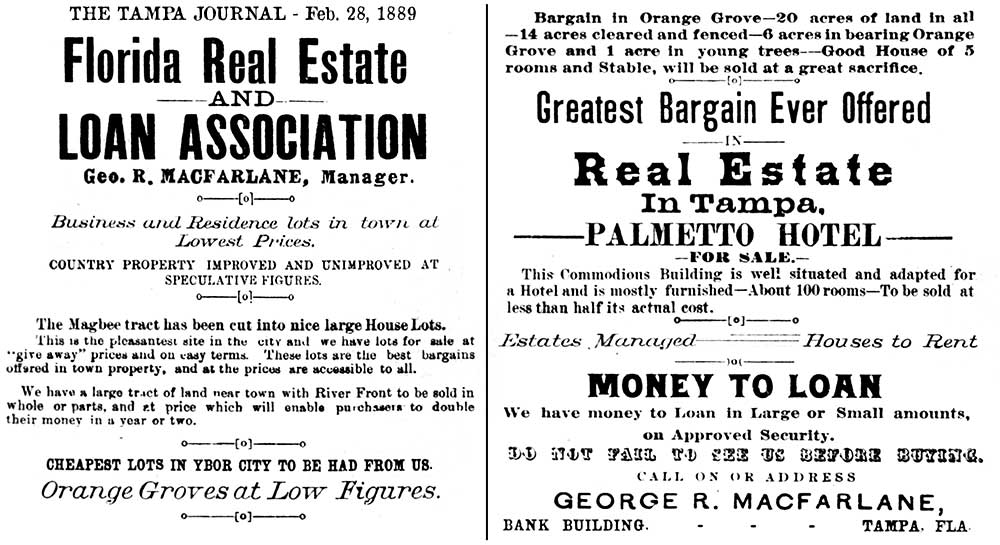 |
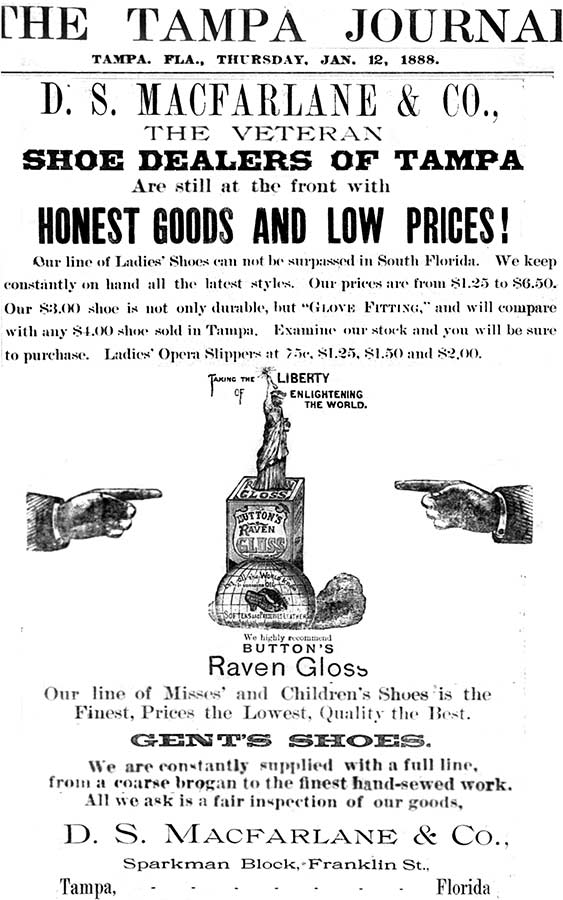
|
During
his term
on the
Tampa
City
Council,
(Mar 4,
1891-Mar
4, 1892)
he was
chosen
to serve
on the
Police
Committee,
the
Streets,
Alleys
and
Roads
Committee,
and also
the
Appeals
and
Grievances
Committee.
Like
fellow
council
member
Henry
Kruse,
he lived
in Hyde
Park.
Owning
much property, George Macfarlane took an interest in
Tampa's fire department and in 1892-93,
he served as Tampa's Fire Chief. By 1892,
he had joined with his cousin Hugh, and Hugh's
brother-in-law Noah Brooks Kent (NBK) Pettingill
(brother of Hugh's wife, Ida Frances Pettingill) to form
the Macfarlane Investment Company. George
also had a position as the United States Customs Office.
George R. Macfarlane died in Tampa on April 27, 1915.*
*From The City Council of Tampa,
5th Edition.
|
| |
|
|
PRE-INCORPORATED
WEST TAMPA (continued.)
The History of West Tampa - Tampa Magazine (tampamagazines.com)
RKP
In 1890, his
legal abilities were honored when Florida's governor
appointed him as the state’s attorney for the sixth
judicial circuit, a great honor to be bestowed upon a
Florida newcomer, let alone an immigrant from Scotland.
With his career as a successful attorney assured,
Macfarlane diversified his involvements in Tampa by
investing in real estate and the cigar industry. In 1891
with the help of various loans and grants, he and his
partners managed to entice large cigar manufacturers
from Key West and New York.
Beginning in 1891, thanks to generous loans and
land grants, Macfarlane and his partners enticed cigar
factory owners to relocate their businesses from cities
like Key West and New York.
|
|
 |
In the spring of 1892, Hugh C.
Macfarlane, who by this time was a prominent Tampa lawyer and real
estate investor, formed the Macfarlane Investment Company to develop
a new cigar manufacturing community west of the Hillsborough River.
The company consisted of himself, his cousin George Rae
Macfarlane, and his brother-in-law, attorney Noah Brooks Kent (NBK)
Pettingill. The Pettingills were a prominent family in
Maine.
After
leaving Tampa, NBK Pettingill became a
Puerto Rico's first appointed federal judge
1899 to 1900. to the U.S.
District Court in Puerto Rico |

|
 |
|
Hugh Campbell Macfarlane
c.1900
Courtesy of Andrew
Macfarlane |
Hon. Noah Brooks Kent Pettingill
c.1899
Courtesy of Portfolio of Judicial
Portraits by David Wells Roth |
George Rae Macfarlane
1891-1892 Tampa City Councilman |
|
|
|
Since
Puerto Rico's change of sovereignty in 1898 when the
U.S. acquired it from Spain, there have been thirty-two
United States judges in Puerto Rico. The first, Noah
Brooks Kent Pettingill, was appointed in 1899 to be the
Judge of the Provisional United States Court established
on June 27, 1899 by the military government pursuant to
General Order No. 88. The Provisional Court was in
existence until the Civil Government for the Island was
formed in 1900 by an Act of Congress. In 1900, Congress
also organized the first United States District Court
for the District of Puerto Rico and provided for one
judge to be appointed for a four year term. Judge
Pettingill was then succeeded by the first true United
States District Judge appointed for Puerto Rico, William
Henry Holt.
|
|
THE FIRST FORTUNE ST. BRIDGE
This is a rare view of
the original Fortune Street bridge built in 1892; the
only surviving one that wasn't taken during its 1926
demolition. Taken Mar. 13, 1924 by Al Burgert, it
wasn't even the intent of his photo. He was more
interested in capturing the "picturesque" landscape and
structures of the Mirabella fish docks on Lozano Ave.
north of the bridge.
In 1892 Hugh Macfarlane financed and
paid for the construction of an iron truss bridge with wooden
roadbed to connect Fortune Street in Tampa to Arch St. on the west
side of the river. This bridge is frequently described as a
drawbridge, but it was not. A drawbridge is opened by lifting one
end of it while the other end remains on the roadway. The
Fortune street bridge was an iron truss swing bridge, which rotated
horizontally at a central pivot point, much like a horizontal wheel
mounted on a vertical axle. By rotating the truss span
parallel with the river banks, tall boats could pass between the
pivoting column and the river bank.
The tract on the west landing of
the bridge was owned by Matthew Hooper who for decades ran "Hooper's
Ferry"
service to cross the river there. In 1890 Hooper had his land
surveyed and filed the plat as "Riverview Park Subdivision." With
Hooper's cooperation and the rest of
Macfarlane's financing, which included land owners on the west side
of the river who provided $15,000 in funds and land, the bridge was
built. No City of Tampa funds were used.
Opening the way for the labor forces to easily commute or even move
from from Ybor City and Tampa it was a major factor in the growth of
West Tampa. Macfarlane had cigar factories built on the west side of the river and enticed large
manufacturers such as Ellinger and Roberts to move there. Many more
followed.
Notice the long approach
to the truss span was on the WT side. This is because
the deepest part of the river was nearer to the east
bank. Also in view at the far right is the
"luxurious" Buena Vista hotel and apartments in West
Tampa.
If you go downtown to the
Riverwalk, near the Cass St. Bridge, you'll see a
historic marker that claims it marks the area where
Bastiano Mirabella started his seafood company and where
their docks were located. Yes, the docks were there,
LATER, but it didn't start there. The area in this photo
is where Mirabella started. In 1895, Bastiano and
Concietta (Spano) Mirabella of Catania, Sicily, built a
fish house fronting the Hillsborough River just north of
the Fortune St. Bridge. In 1900, 38-year-old Bastiano,
along with his 32-year-old wife of 14 years, Concietta
and four children, Josephine, Mario, Francesco and
Maria, lived on Fortune Street near the Hillsborough
River at Spring Street.
The bridge close up is a
crop of the hi-res image provided to me by the
Tampa-Hillsborough Co. Public Library System.
Macfarlane's first West Tampa subdivision was filed
April 22, 1892** and was an eleven block tract that formed the heart
of West Tampa, included a central square at the present
intersection of Main Street and Howard Avenue. The square, however,
never served any public function, and in 1894 the O'Halloran cigar
factory was erected on it.
**The image of the plat of this filing has not yet been located by TampaPix.
|
|
Beginning with his own 200 acre tract of land, between 1892 and 1895,
Macfarlane assembled other interested businessmen,
including Matthew Hooper, W. W. Hooper, Philip H.
Collins, George N. Benjamin, L. B. Skinner, and
A. C. Clewis, who would soon own 90 percent of the
800 acres which became the City of West Tampa
(Jacksonville, Florida Times-Union and Citizen, South Florida
Edition, 1897).
In 1893, his legal abilities were
honored when Governor Henry Laurens Mitchell appointed
him as the state’s attorney for the sixth judicial
circuit, a great honor to be bestowed upon a Florida
newcomer. With his career as a successful attorney
assured, Macfarlane diversified his involvements in
Tampa by investing in real estate and the cigar
industry.
The
recently completed Plant
railroad gave Tampa markets
access to the nation; expansion
of shipping interests, and the
phenomenal expansion of Ybor
City’s immigrant population
convinced him to capitalize on
real estate investments and
cigar making. He purchased two
hundred acres of land which was
nothing more than a combination
of marsh and wilderness in the
late 1880’s. Located on the west
bank of the Hillsborough River,
the acreage was quickly
transformed into West Tampa, the
area’s second industrial
community.
|
|
|
|
|
|
| |
|
|
|
James & Anne's eldest son,
Hugh Campbell Macfarlane, was born Dec. 28, 1851
in Pollokshaws, Renfrewshire, Scotland,
obtained his law degree at Boston University
in 1878, married and had a family, and
practiced law for a short time in Fall
River, Bristol County, Mass. before
coming to Tampa in 1884.
Details of Hugh's life are presented later below.
James D. & Anne's
next eldest son, David Stewart
Macfarlane, was born May 1857 in
Pollokshaws, Renfrewshire, Scotland and
married Emma Simmons in Fall River.
David was a carriage maker, for a short
time, a constable in
Fall River, and a worker in a cotton mill. They came with their daughters to Tampa
in early 1884 from Jacksonville where he was
employed at his brother-in-law's boot and
shoe business, Emery & Simmons. He and
his family came to Tampa by March 1884 when
he was transferred to the Emery & Simmons
boot & shoe store branch location. David
bought the store and was a
successful boot & shoe merchant
for many years in Tampa and served a year on
the City Council. In 1899 he remarried, had a
another daughter and moved to Edmonton, Alberta,
Canada in 1906. More about David is
presented later below.
James D. and Anne's youngest son
Matthew Biggar Macfarlane, Hugh's youngest
brother, was born Mar. 1861 in Pollokshaws,
Renfrewshire, Scotland and spent his youth in
Minnesota and Fall River public schools. He
obtained work in a cotton mill as a loom
fixer for several years in Fall River.
Matthew married Mary Alice Cordingly of Fall
River and came to Jacksonville to replace
his brother David's position at Emery &
Simmons when David moved to Tampa.
Matthew then came to Tampa where he studied law in the
office of his brother, Hugh. He was admitted to the bar in
Tampa in 1885
and entered into a law partnership with his
brother Hugh.** He was a highly recognized
and respected Republican leader in Florida
for many years and in 1897 was appointed by
President McKinley
as Collector of Customs in Tampa. He served for
sixteen years at that position under
presidents McKinley, T. Roosevelt and Taft.
In 1900 and 1904 he was the Republican
nominee for Governor of Florida. He
was a member of the Elks Club, a Knight of Pythias and an Odd Fellow. Matthew was
named for a brother-in-law of his father,
Matthew Biggar, who married James's sister Mary
Macfarlane. More about Matthew is presented
later below.
**"Men of the South, A work for the
newspaper reference library," by numerous editors around
the country including W. F. Stoval of Tampa, pub. 1922
by the Southern Biographical Assoc., New Orleans. La.
ARRIVAL OF THE O'HALLORAN BROTHERS FROM KEY WEST

Other manufacturers mentioned as moving to
Tampa were Teodoro Perez, Manuel Baranco, Fleitas Co, L. Napolis,
Severo de Armas, and A. Zamora
1895 AND 1899 SANFORD MAPS SHOW THE O'HALLORAN CIGAR FACTORY AT THE
CENTRAL SQUARE OF HOWARD & MAIN ST.
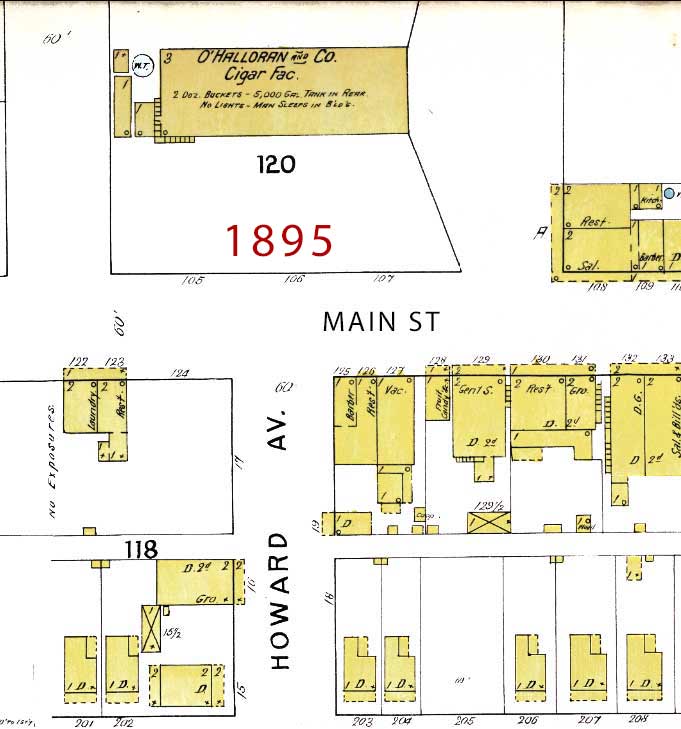
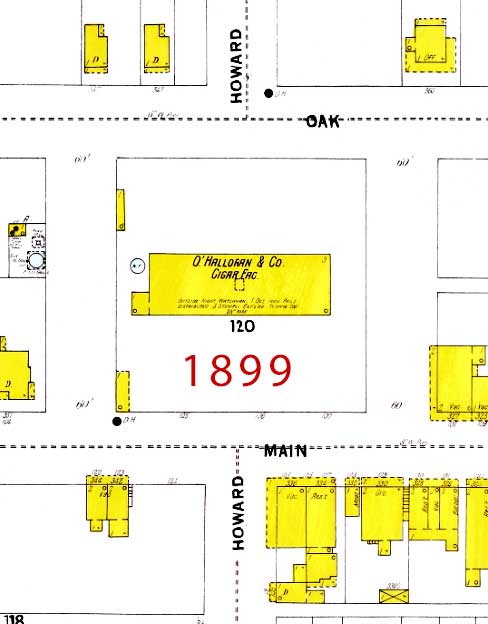
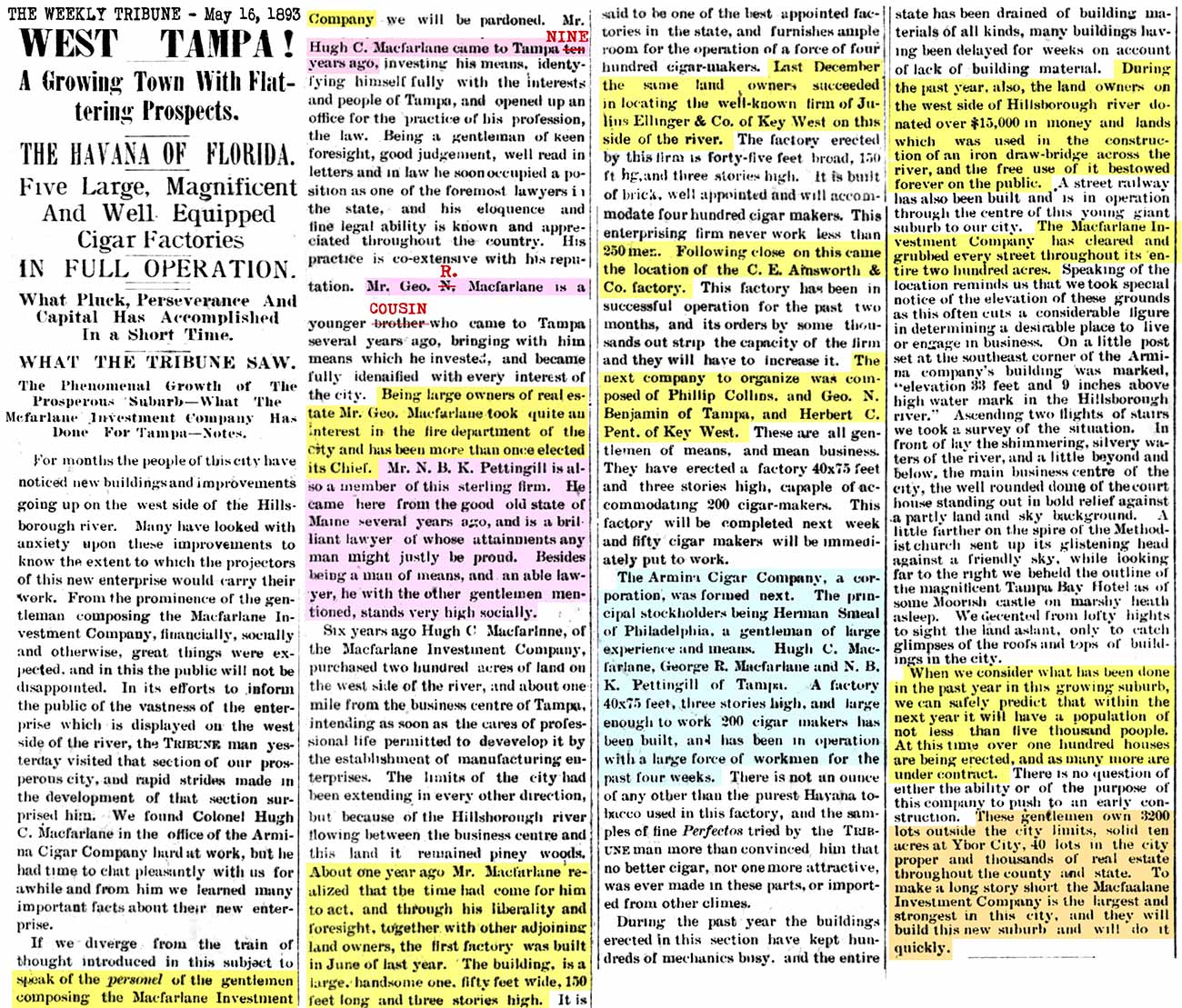
| In 1894, Hugh Macfarlane was appointed to State
Attorney in Hillsborough County. He prosecuted a
number of high-profile murder cases in Tampa, but
resigned in April 2, 1895. |
|
GEORGE RAE MACFARLANE
|
|
DAVID MACFARLANE'S SECOND MARRIAGE, CARRIE PENNOCK,
DUVAL COUNTY, Mar. 8, 1899

David's 1900 census in Tampa shows him living at 1119
N. Florida Ave. with his 2nd wife, Carrie Pennock, whom
he had married less than a year earlier. The first three
daughters were David's by his first wife.
Katherine was his daughter (1 mo. old) by his present wife.
David was born in 1857, not 1859, and would have been 43
here.

|
1901 FIRE DESTROYS THE O'HALLORAN BROS. FACTORY
AND THE HEART OF WEST TAMPA
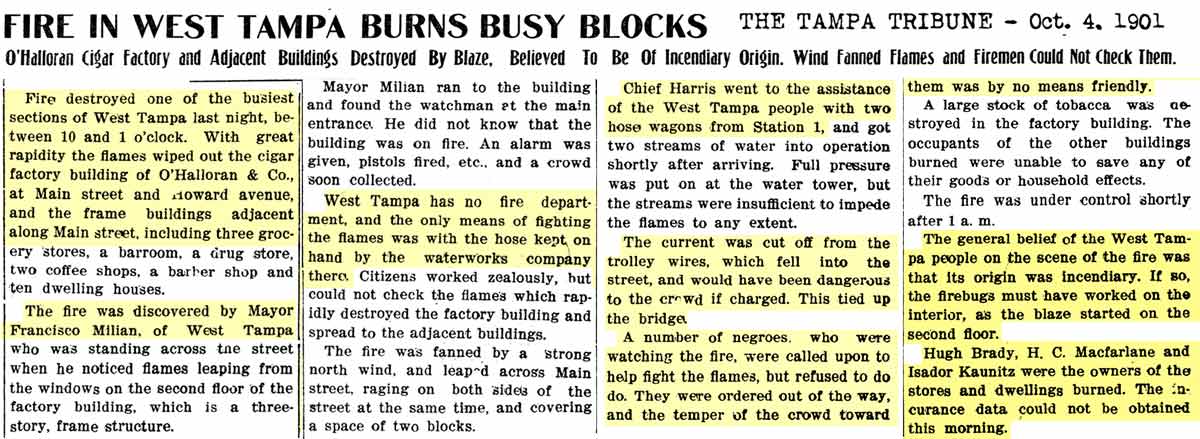
It was at this time that Howard Avenue was cut through the
now-vacant square, leaving only the east third of the square whose
presence is still recalled by the one-block of Ysolina Street between Main and Union Streets (originally Oak St.).
Three new brick structures were built as well as the Fernandez Bros.
factory (wood frame, as indicated in yellow.) Today, the site
of this factory is the West Tampa branch Library.
Place your cursor on the map to see it replaced
with a 1903 map.
Notice the surviving drugstore of Dr. Moreno in 1903.
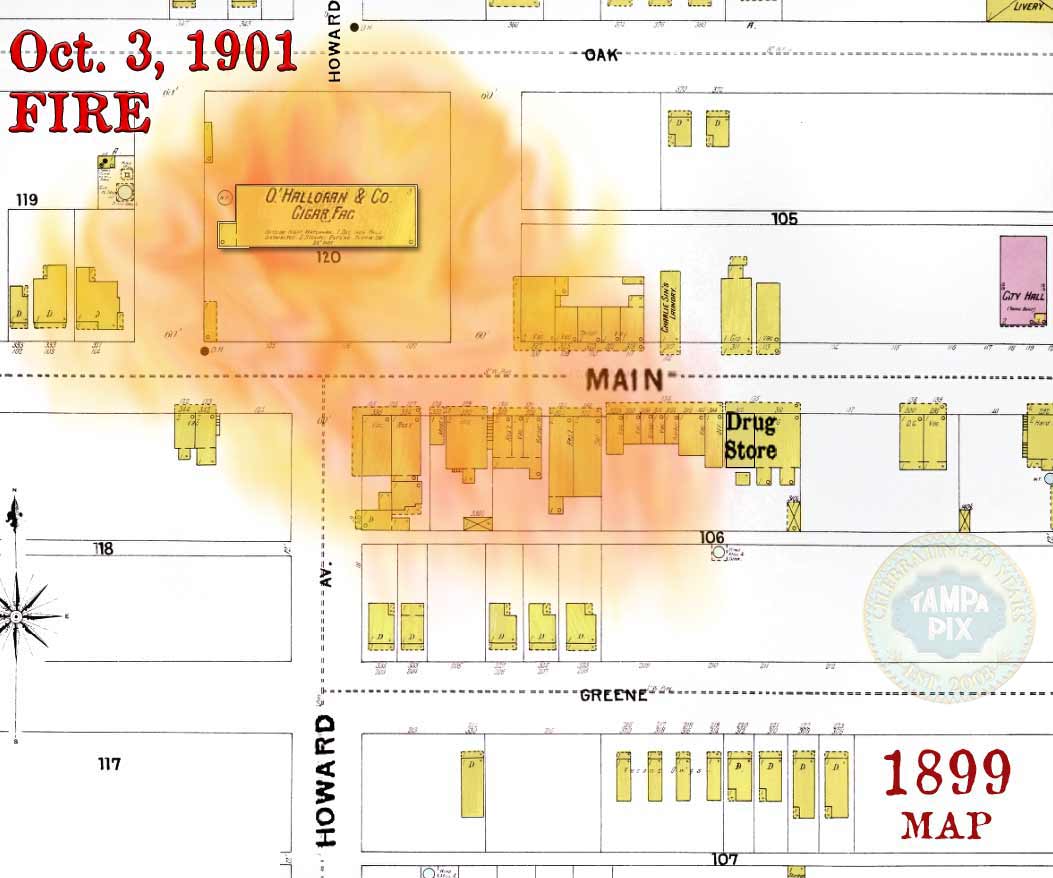
The site of the new 1903 Fernandez cigar factory is now occupied by
the West Tampa branch library at Howard Ave. & Union St. (formerly
Oak St.)
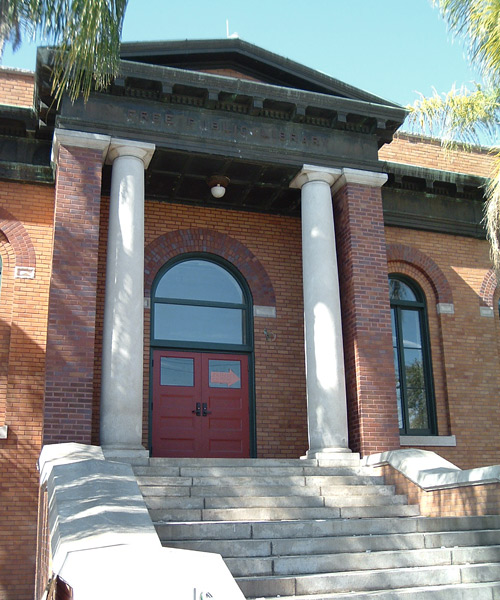
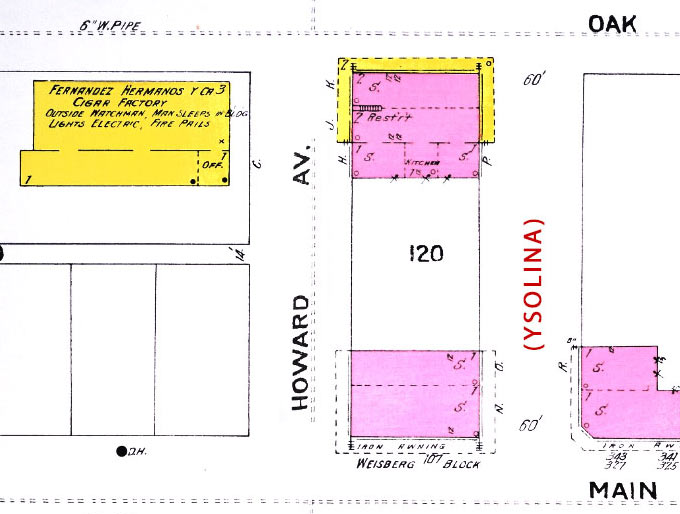
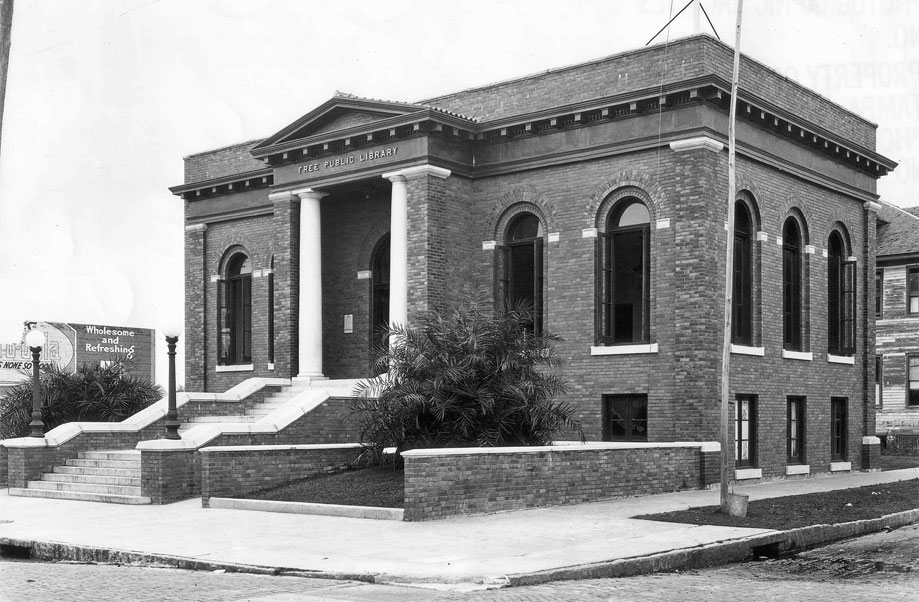
The West Tampa Library, March 6, 1918. Burgert Bros. photo courtesy
of the Tampa-Hillsborough County Public Library
READ MORE ABOUT IT HERE AT TAMPAPIX.
OTHER PRE-INCORPORATION DEVELOPERS OF WEST TAMPA From the
National Register of Historic Places Inventory-Nomination Form,
Sept. 7, 1963 and The Sunland Tribune, (1981) "West Tampa Cigar
Factories Reminders of Area's Past Boom,"
Sunland Tribune: Vol. 7 , Article 22.
While Macfarlane’s subdivision formed the center of
West Tampa, the participation and investment of his partners, and
other developers, the most prolific being John Higley Drew, were
essential to the area’s development, from Michigan Avenue (Columbus Drive) on the
north to Fig Street on the south, from the Hillsborough River on the
east to Himes Avenue on the west.
Dr. Philip H. Collins owned the subdivisions of El
Cerro, Collins’ Addition, and Collins’ Second Addition. His
son-in-law, future WT Mayor (1897-1901) George Nelson Benjamin obtained two large subdivisions in
1892 from William B. Henderson. He ended these orange grove
properties and promoted the growth of West Tampa’s industry, serving
also as Treasurer in the West Tampa Land Improvement Company and as
Director of the Bank of West Tampa.
CLICK ON ANY SUBDIVISION
TO SEE THE FULL SIZE PLAT.
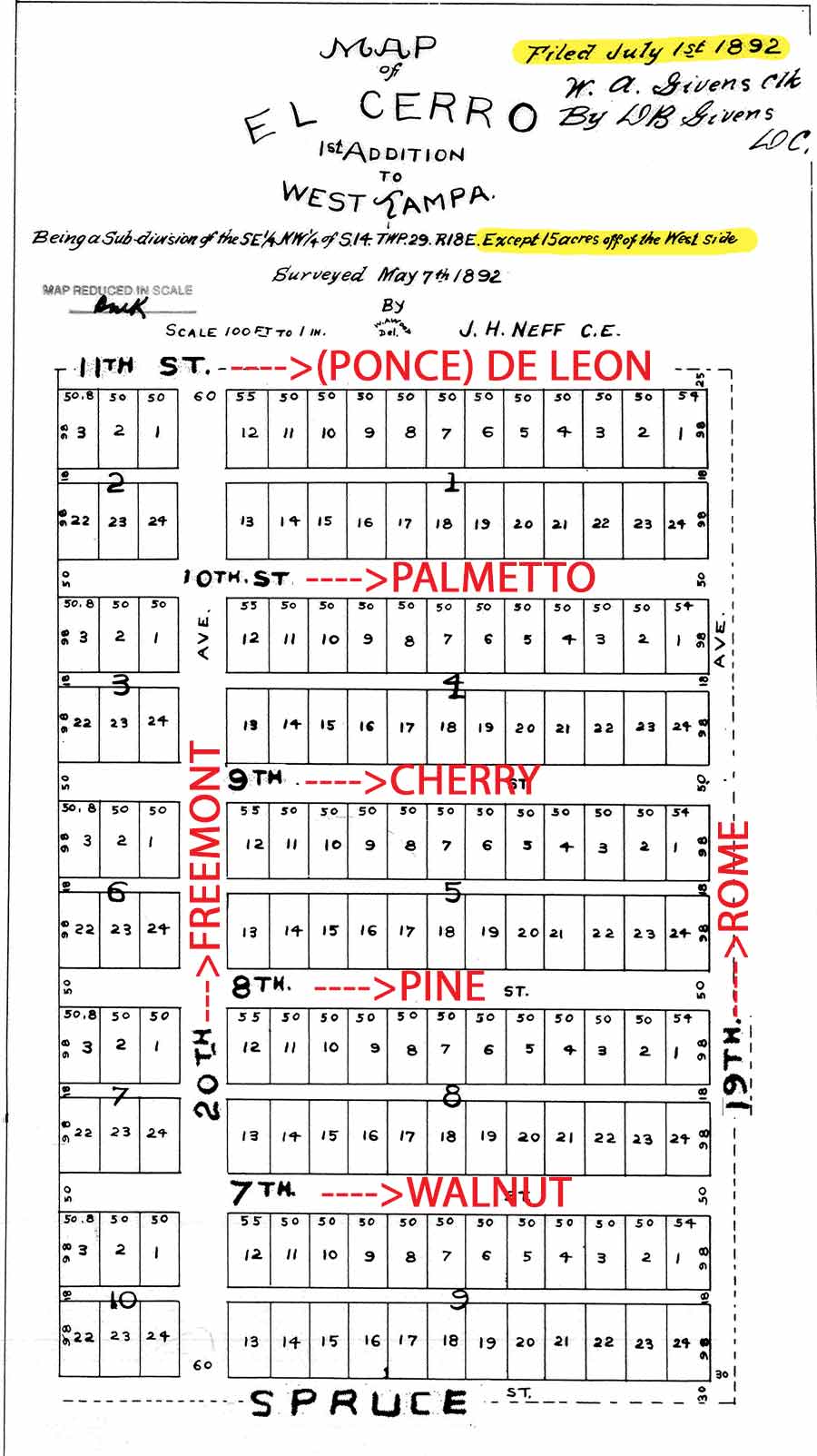
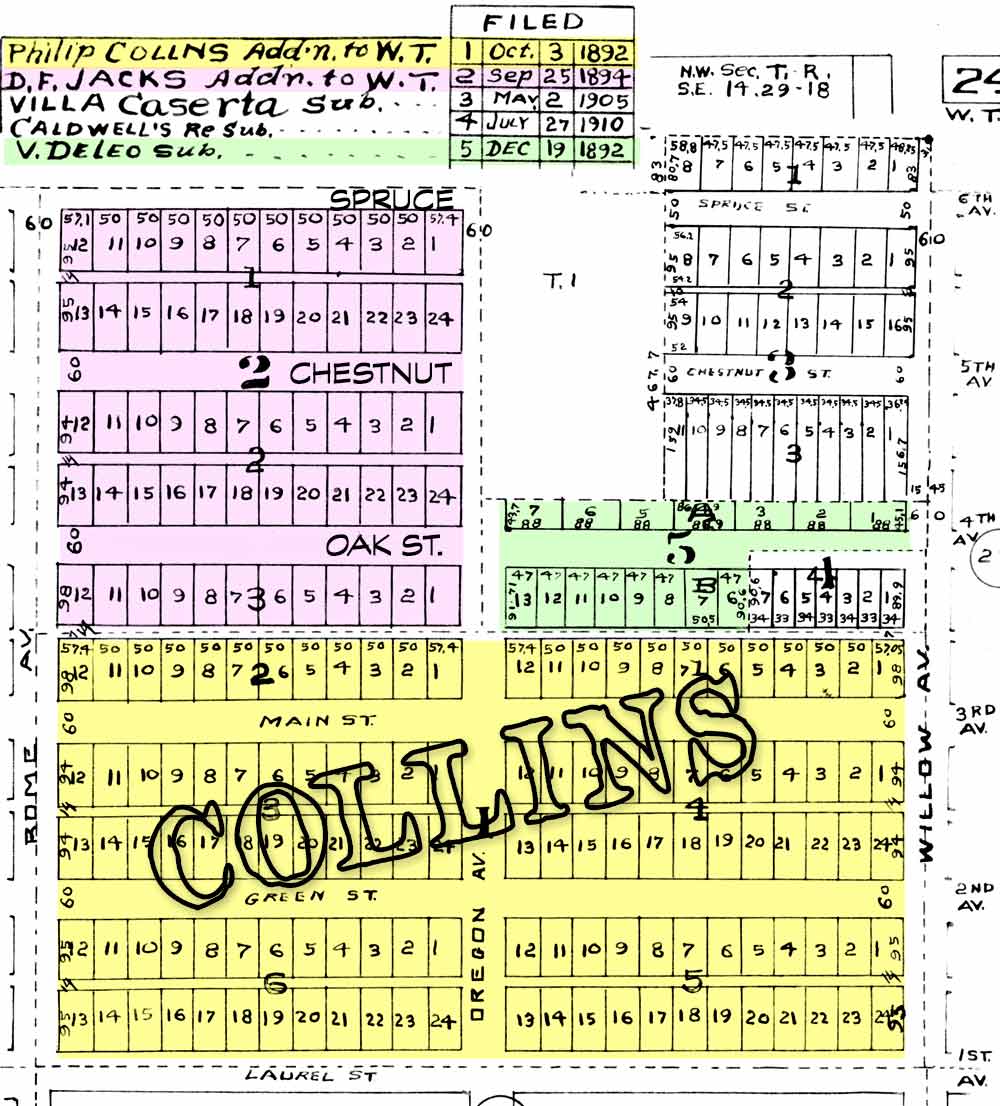
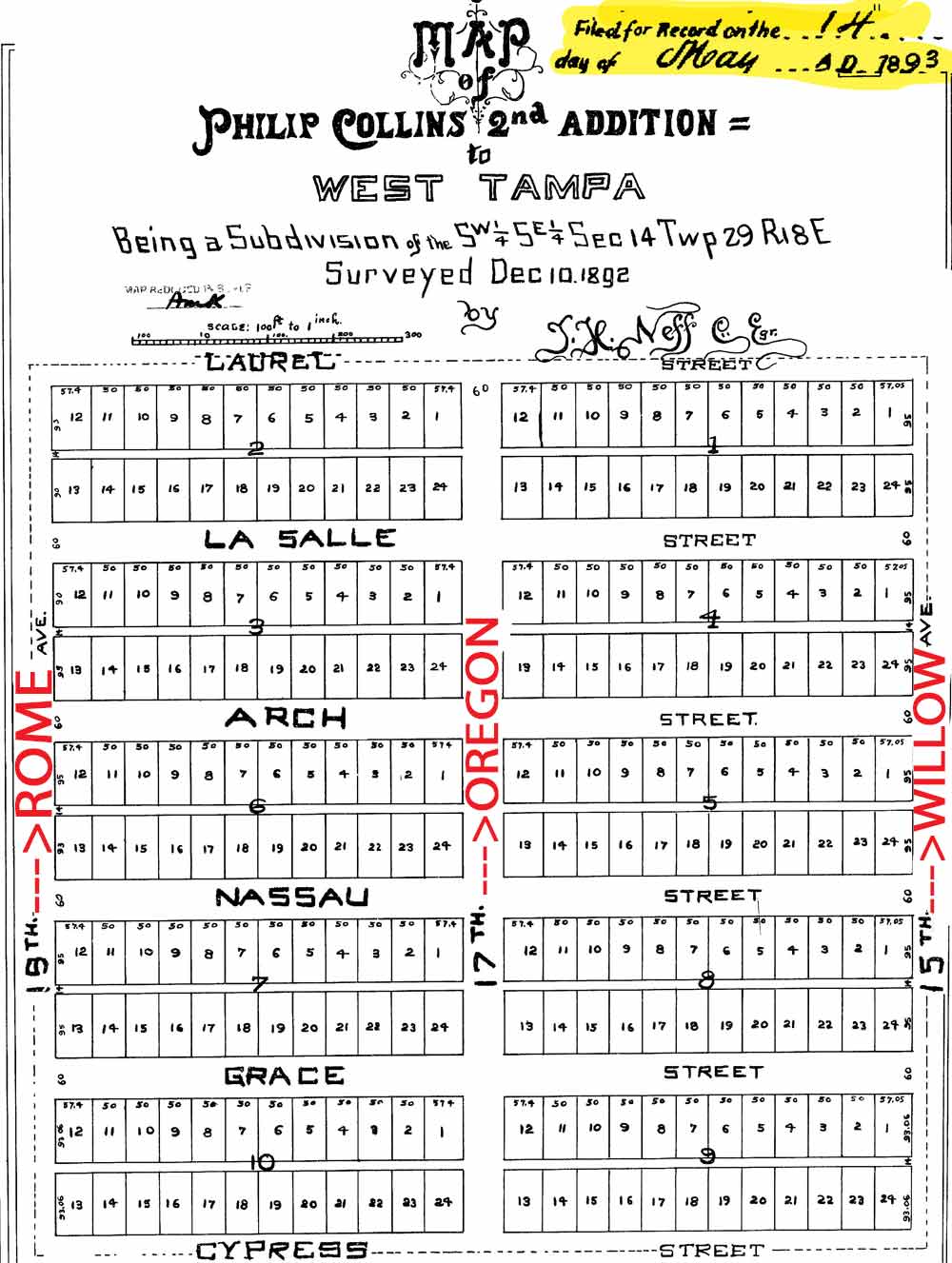
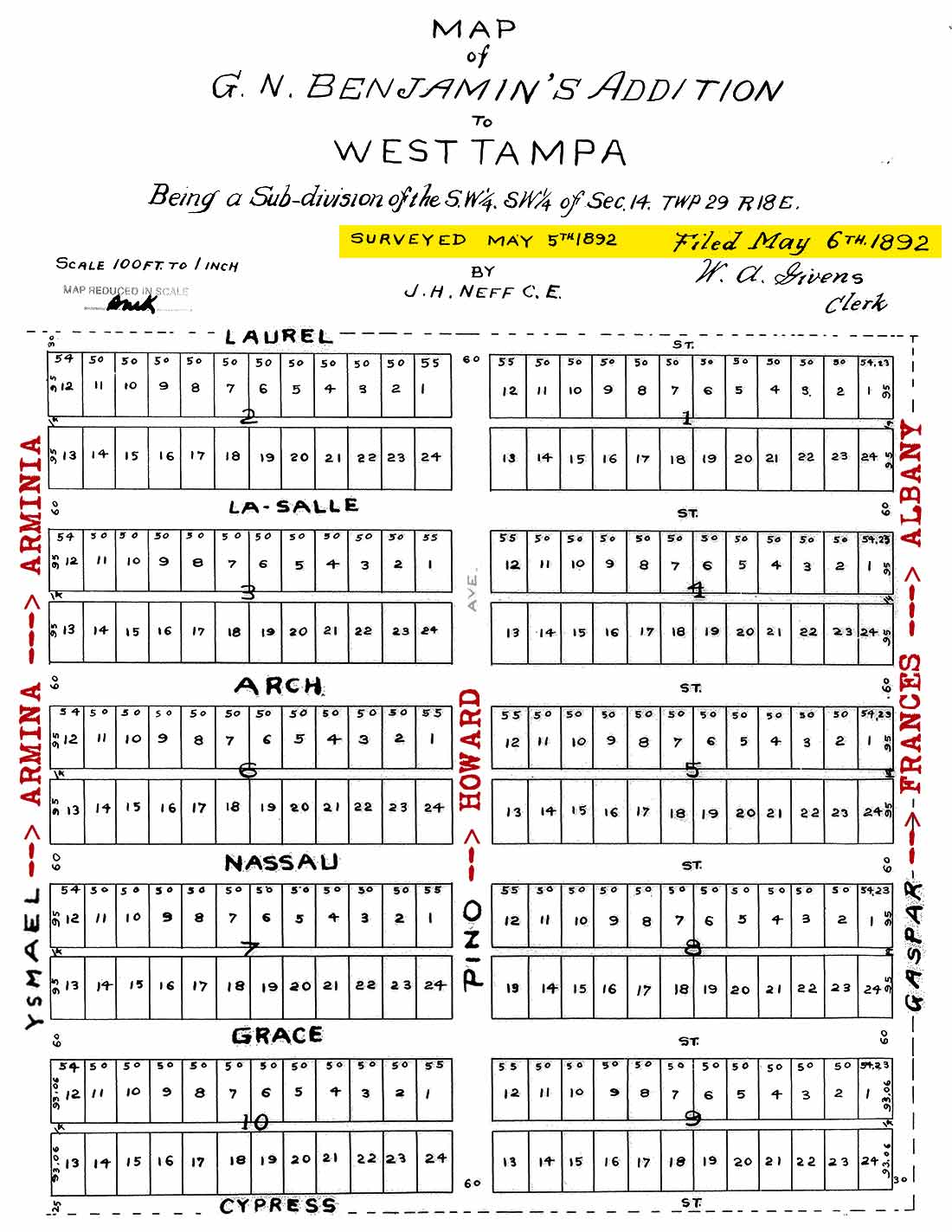
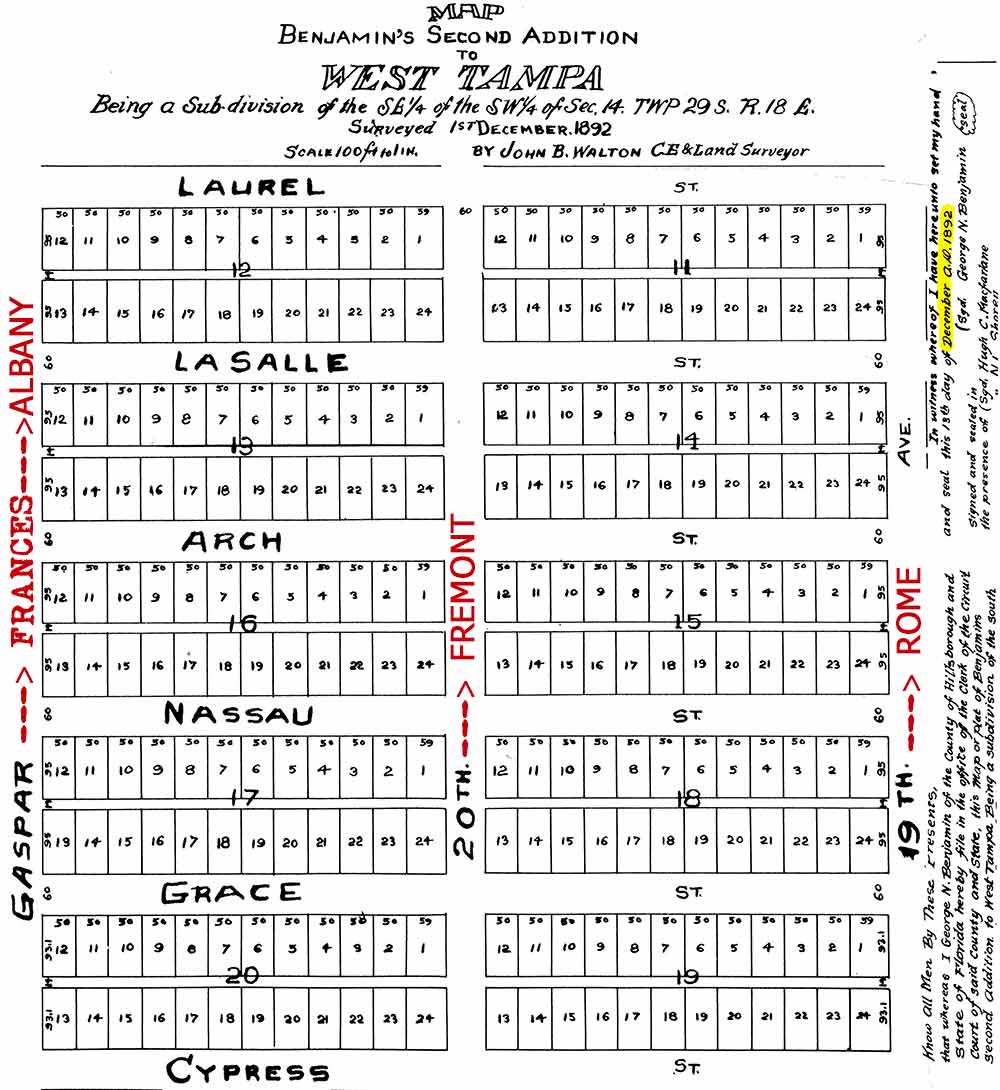
Farmer/businessman Matthew Hooper and realtor William W. Hooper
owned the Munro and Clewis subdivision land and the property which
became C. B. Bouton’s Addition to West Tampa.
Matthew Hooper operated "Hooper's Ferry" across the Hillsborough
River before Macfarlane built the first Fortune St. Bridge there.
His property, Hooper's Landing, was on the west bank of the
Hillsborough River, across from Madam Fortune Taylor's property on
the east bank. Hooper's location probably necessitated that
Macfarlane have him on his team and not be his competitor.
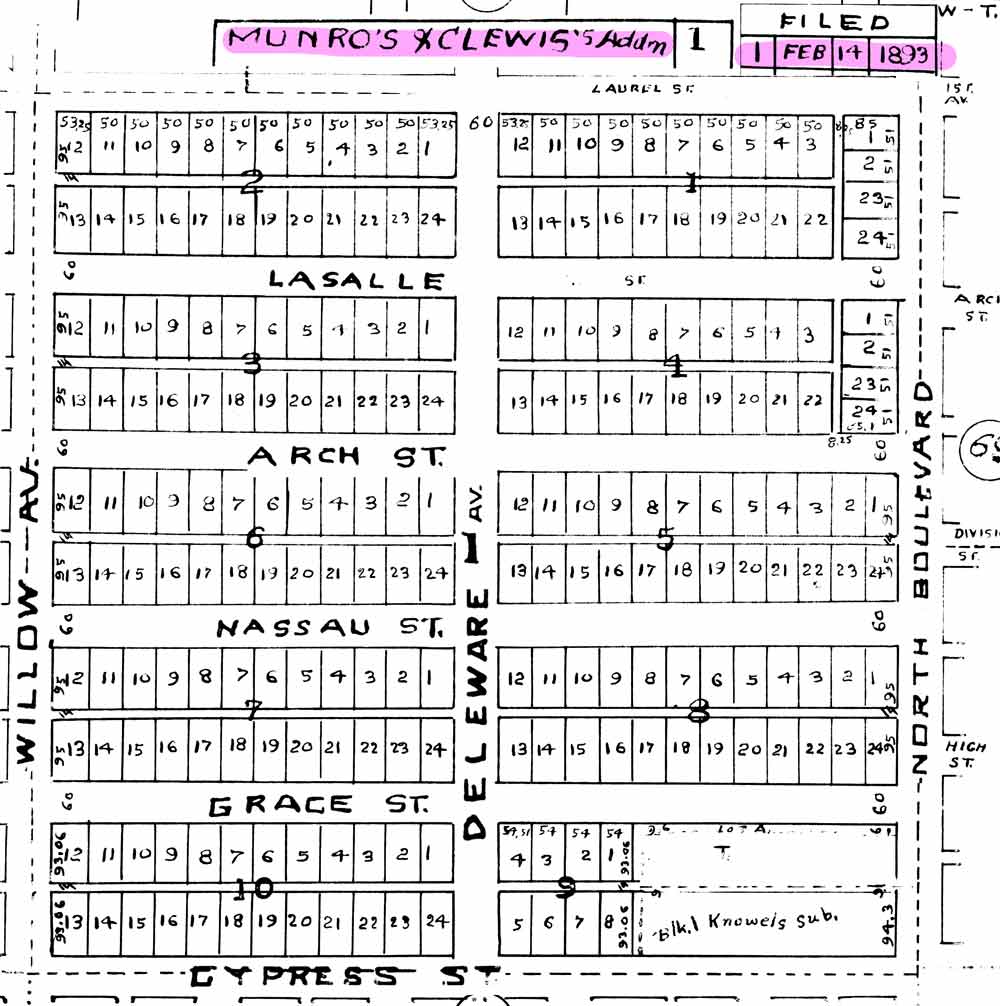
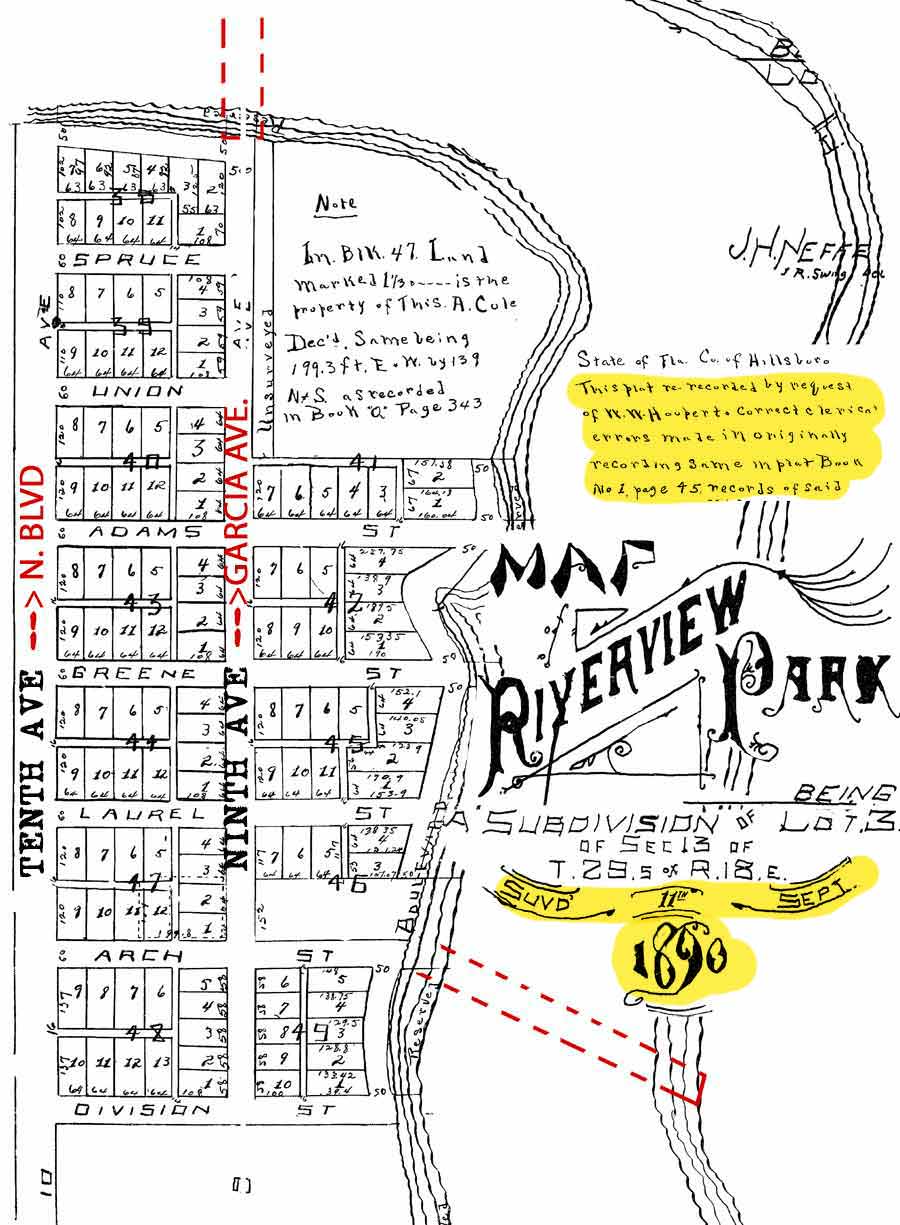
From the
National Register of Historic Places Inventory-Nomination Form,
Sept. 7, 1963 and The Sunland Tribune, (1981) "West Tampa Cigar
Factories Reminders of Area's Past Boom,"
Sunland Tribune: Vol. 7 , Article 22.Alonzo C. Clewis, owner of the Tampa Abstract
Company and an organizer of the Exchange National Bank, was a key
financial promoter of many West Tampa projects. Two other key
associates in the Macfarlane organization were landholder
Christopher B. Bouton and builder Lee B. Skinner. In order to
develop West Tampa as Hillsborough County’s second cigar
manufacturing area, in 1892, Macfarlane and his partners financed
the first bridge across the Hillsborough River, the iron Fortune
Street drawbridge. In the fall of 1892, the Macfarlane Investment
Company helped start a streetcar route from downtown Tampa into West
Tampa, as part of the Consumers Electric Light and Power Company
system. By 1900, good transportation and communication between West
Tampa and Tampa’s port facilities were essential factors in making
the new community competitive with Ybor City and Tampa for new
factories and businesses.
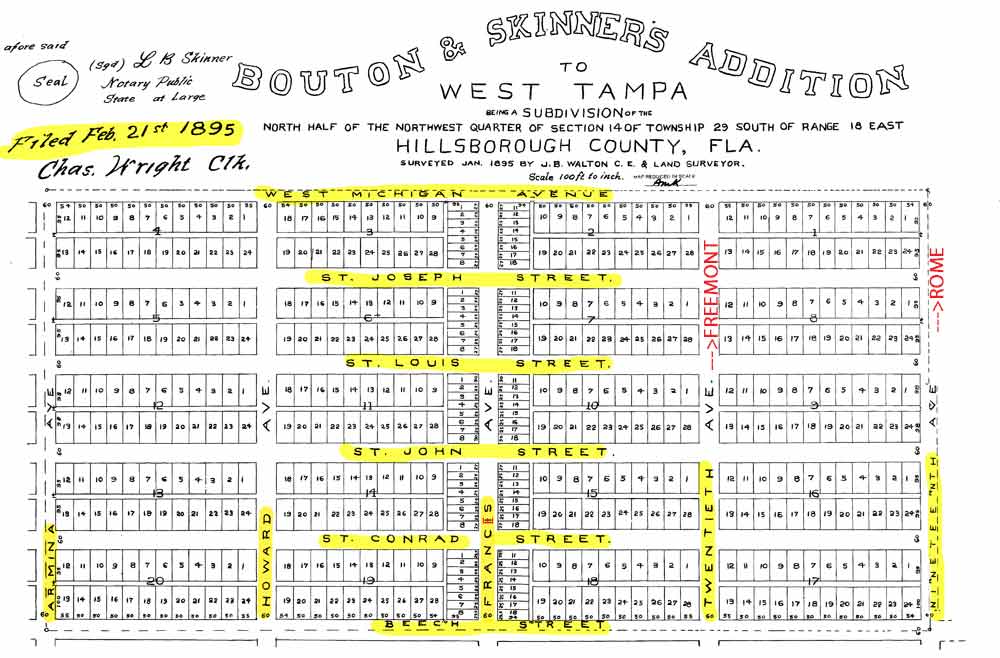
Place your
cursor on Macfarlane's second addition to
see modern day streets.
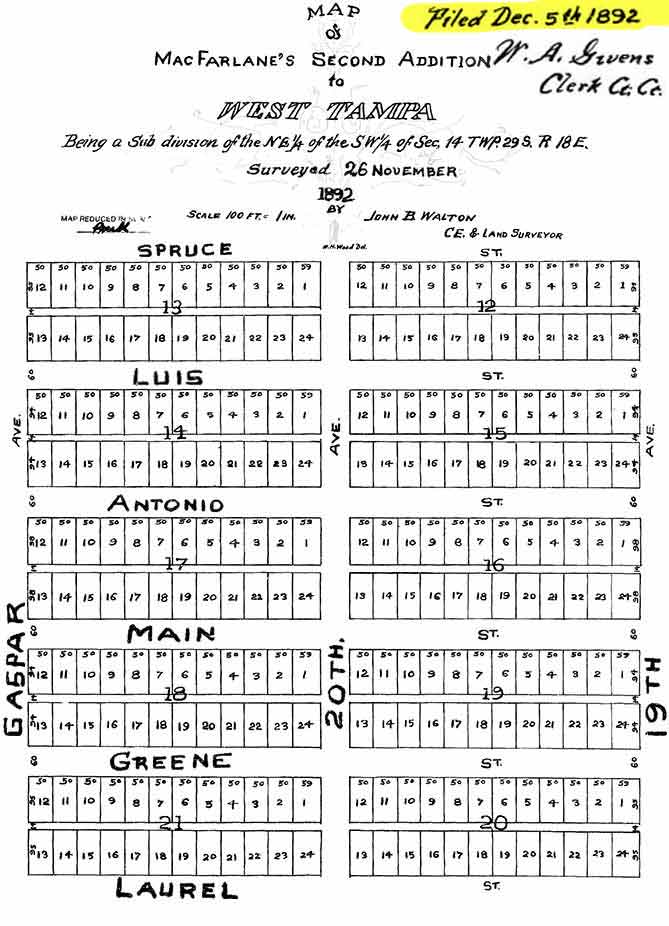
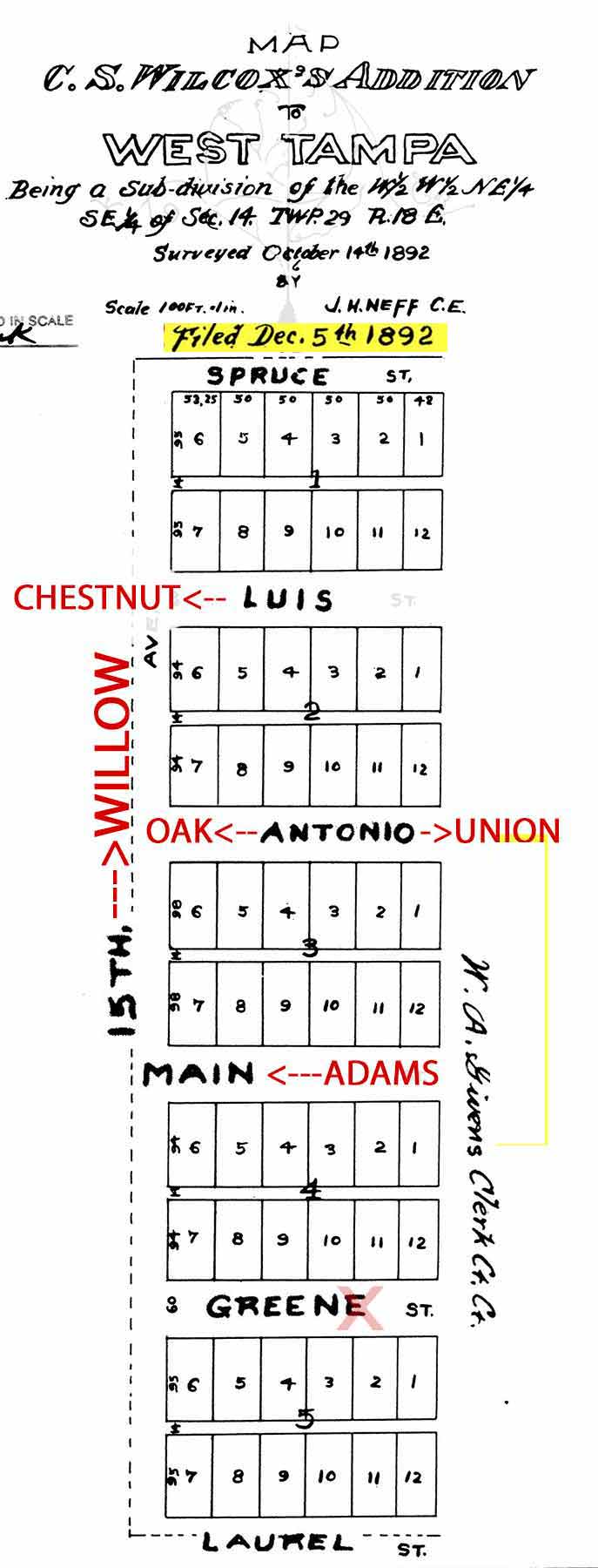
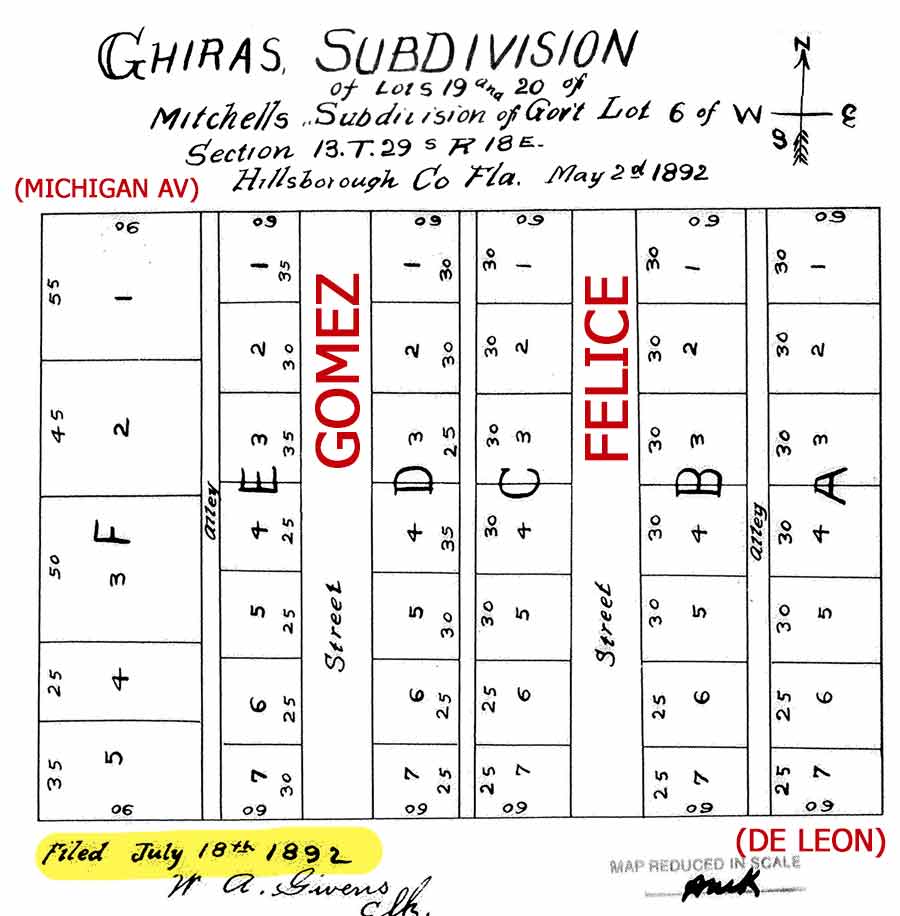
MACFARLANE'S SECOND ADDITION TO WEST TAMPA
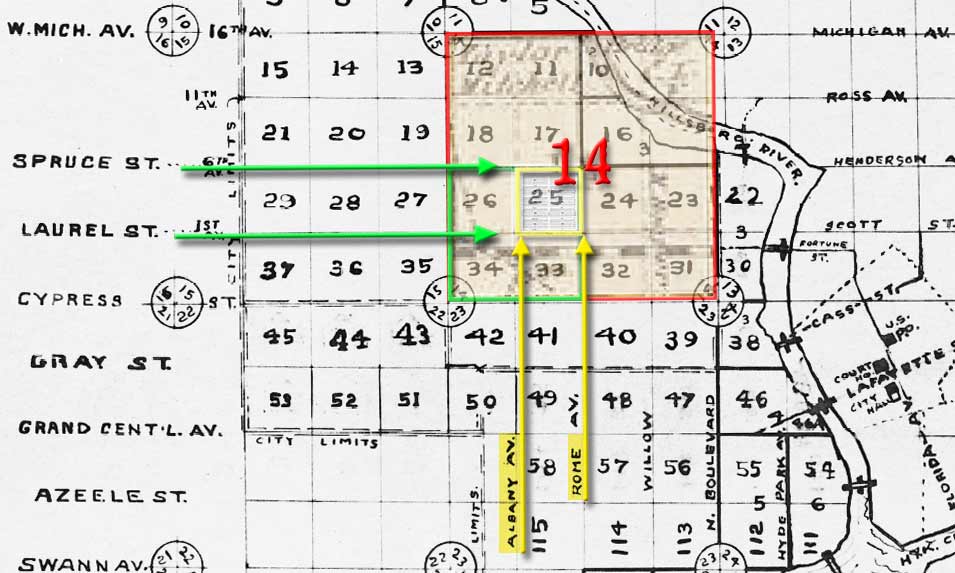 From the
National Register of Historic Places Inventory-Nomination Form,
Sept. 7, 1963 and The Sunland Tribune, (1981) "West Tampa Cigar
Factories Reminders of Area's Past Boom,"
Sunland Tribune: Vol. 7 , Article 22.
COTTAGES AT $400
Duplicating many of the successful methods utilized by Vicente
Martinez Ybor and his Ybor City Land and Development Company, the
Macfarlane group constructed numerous two and three-story factories
and hundreds of cigar workers’ cottages, which they offered to cigar
firms from New York City to Havana. Long term leases and specially
designed facilities were common practices offered as inducements by
most West Tampa developers. The Tampa Building and Loan Association,
headed by A. C. Clewis and M. M. Dobson, constructed many of the
larger commercial buildings along Howard and Armenia Avenues. Lee B.
Skinner, operating from his office at the First National Bank,
offered residential lots at moderate prices, at 20 percent down and
monthly installments catering to the workers’ salaries. George
Benjamin constructed dozens of $400 cottages for cigar workers in
his successful subdivision. The lure of these attractive and
well-advertised developments quickly made West Tampa an immediate
rival to Ybor City as a cigar manufacturing center. Beginning with
the construction in 1892 of the factories for the O’Halloran &
Company and the large Julius Ellinger Company (near the river), the Macfarlane
Investment Company attracted over two dozen large firms and 50
small, family-operated companies to West Tampa during the next 30
years.
|
WEST TAMPA FIRE OF 1904
SPECIAL THANKS TO THE
WEBSITE
OF JAIME MONTILLA which presents the history of Tampa's cigar industry
in great detail with each factory. It is a source of the locations
of many of the factories involved in the WT fire of 1904.
Other sources:
Sanborn Fire Insurance maps of Tampa, UF Smathers Library Digital Map Collection
"A Thesis Submitted to the Graduate Faculty of The University of Georgia in
Partial Fulfillment for the Degree MASTER OF HISTORIC
PRESERVATION" by Brian Koepnick.
Location of
Sam Caro's factory:
West Tampa Historical Trail, 2007 by Steve Rajtar
New York City
signs (Optimo brand) 14th to 42nd Street by Walter
Tampa Tribune article, Mar. 8, 1904 GROWING RAPIDLY-
This article provides some of the most current information of the time period before the
fire as to what factories are in the area befor the fire, but it doesn't name and streets or
addresses, which renders the article almost useless for knowing where exactly they
were. No map or description is given as to what path the "tour" took
other than an alleged street car ride. Many of the sites named are
not on the 1903 Sanborn map and could have been built during the period after
the Sanborn map and before the time of this article. This could be verified
by searching the Tribunes for this period but it isn't the purpose of this
feature to present a detailed history of these cigar factories.
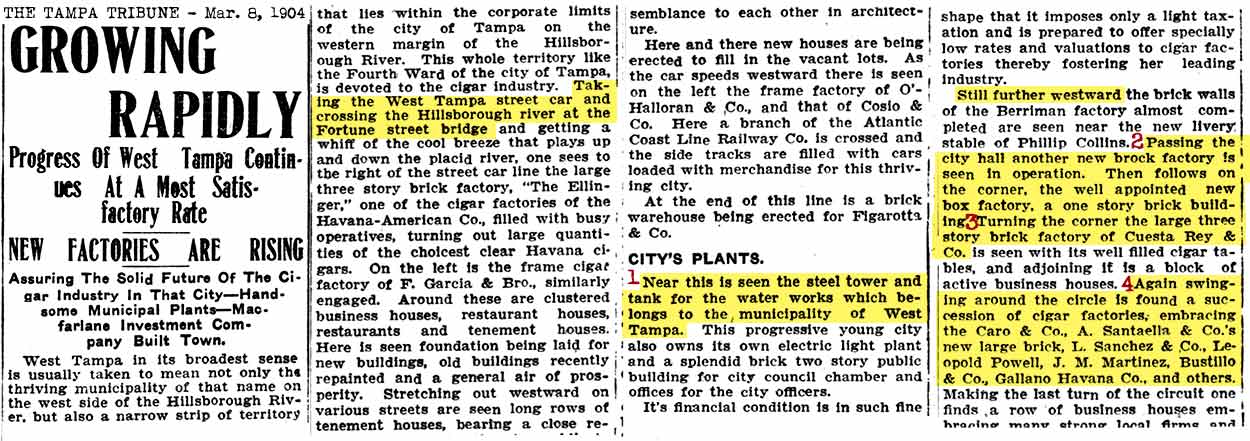
|
1. |
The writer passes WT water works - most likely he is on Main St.
|
|
2. |
The writer passes city hall, (which was located at the corner of
Albany and Main St.) He sees "another brick factory in operation."
(Not on the map.) Then on the corner, a one-story brick box
factory (not on the map.) Is this the western corner of the
block City Hall was located on? If so, it would be Howard Ave & Main
St. |
|
3. |
The writer turns the corner (is this the same corner described
above?) He sees the large three-story factory of
Cuesta,
Rey, which the 1903 map shows is all the way up Howard Ave. at the
northernmost part of the map. He does not mention passing the Leopold
Powell factory's new location, which previously was the
Santaella
factory. Could it be that Powell had not yet moved in? |
|
4. |
The writer says "Again swinging around the circle..." Is he
turning left (south) on Armenia after traveling west on Palmetto or
Beech St? Next, "a succession of factories...embracing the Caro
and Santaella's NEW large
brick..." He is naming the northernmost and southernmost factories, with Caro at
Armenia & Pine and the NEW brick Santaella at Armenia and Spruce.
|
|
5. |
He goes on to mention the Sanchez, POWELL and Martinez
factories. These are the three factories in between Caro & the
new Santaella, in order from north to
south along Armenia from Pine to Spruce. He appears to be unaware that
POWELL has bought the previous building occupied by Santaella, or, the writer
thinks that Powell has not yet moved into the old Santaella factory. Instead of
"embracing.." could he have meant "embraced by..." This would explain the
identification of the Caro and Santaella factories first, which "embraced" the
factories in between. A March 15 article states that
Guerra,
Diaz was moving into the Powell factory on that date. Perhaps
signage had not yet changed on March 8 when the writer passed by. After
naming the Martinez factory, he jumps to the
Bustillo factory which was for many years at Albany and Pine.
There seems to be no logical way he would have gone from the southwest to the
north east section of this map. He also names Gallano Havana Co. |
| |
|
|
Unfortunately, the next Sanborn map isn't until 1915, and as fast as
West Tampa was growing, it wouldn't be reliable to show locations of
these factories in 1904. |
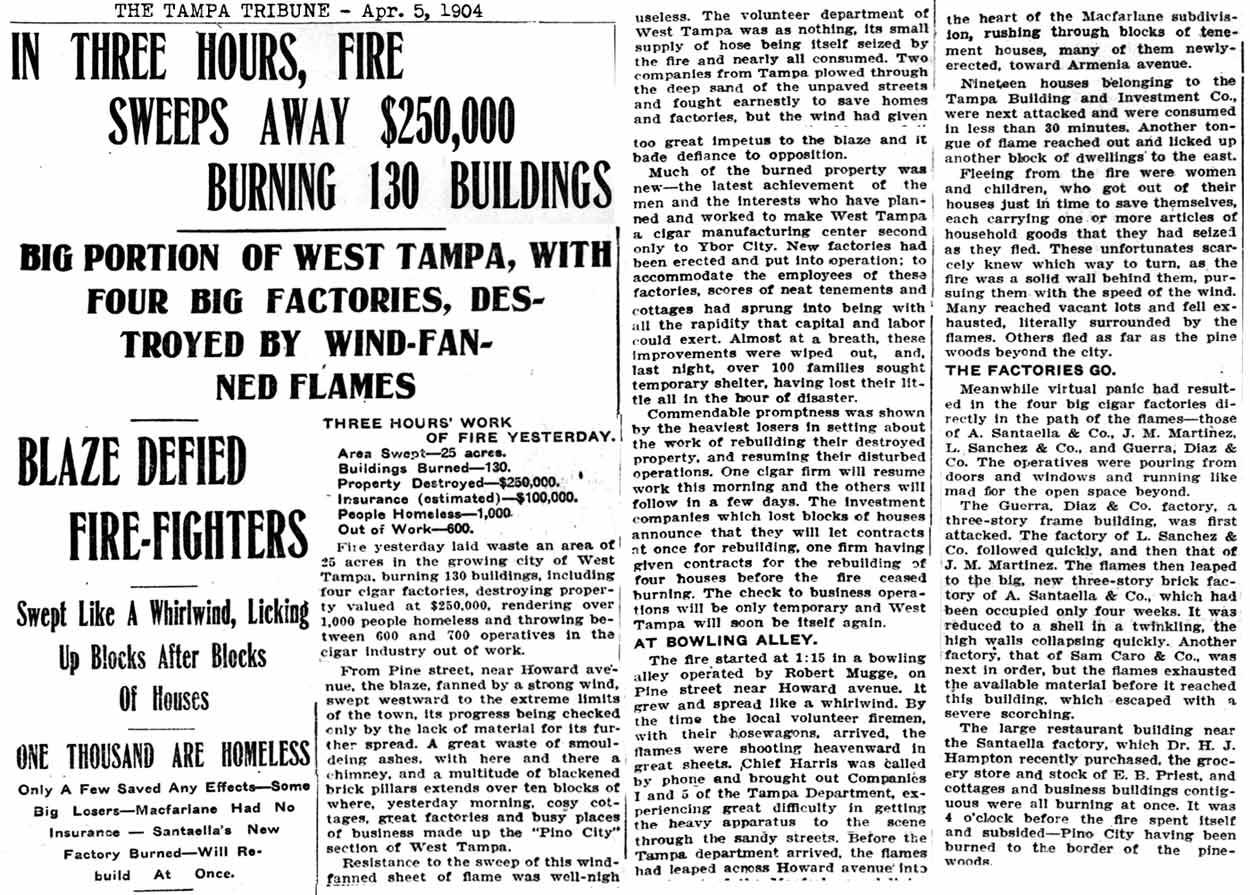
FIRE CHRONOLOGY
| Fire starts at Robert Mugge's bowling alley at Pine
and Howard. |
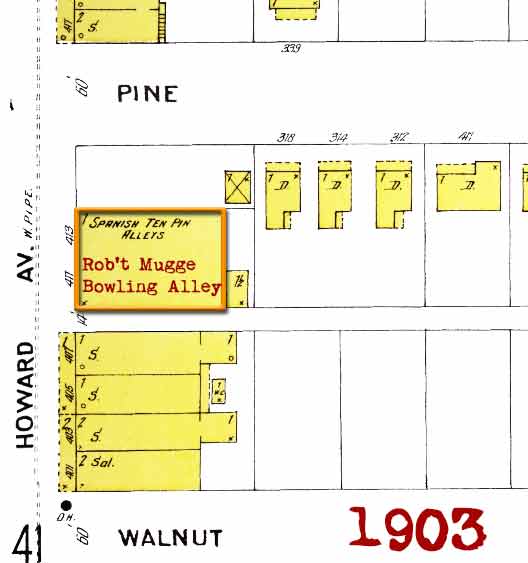 |
| Fire leaps across Howard Ave and burns blocks of
houses toward Armeinia Ave. |
| Nineteen houses belonging to Tampa Building &
Invest. co are destroyed. |
| Flames burn another block of houses to the east. |
|
Guerra, Diaz & Co. cigar factory consumed. |
| L. Sanchez factory quickly follows. |
| J.M. Martinez factory consumed. |
| NEW large brick
A. Santaella factory reduced to a
shell. |
| Sam Caro** factory almost burned, fire stops short. |
| Large restaurant recently purchased by Dr. H.J.
Hampton near Santaella. |
| Grocery store and stock of E. B. Priest, cottages
and business building all burning at once. |
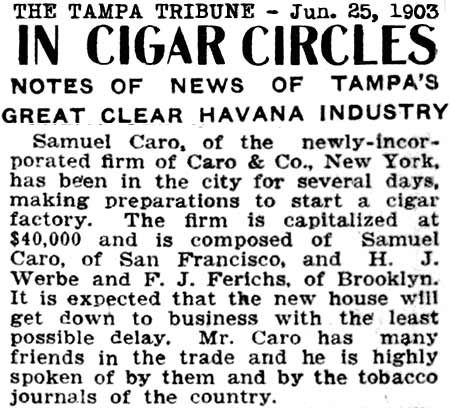 **By Steve Rajtar: Northwest corner of
Armenia Ave. and Pine St. (2202-06 Armenia Ave.) .Site of Juan
La Paz Cigar Factory - A cigar factory on this corner was in
operation by 1895. In June of 1903, it was leased to Caro and
Company, whose 200 workers produced brand La Facultad until the
factory closed in 1906. During the following year, the M. Perez
Cigar Company moved in here and continued in business until 1910.
The building was occupied in the 1920s by Enrique Henriquez (West
Tampa's final mayor) Cigar
Company. **By Steve Rajtar: Northwest corner of
Armenia Ave. and Pine St. (2202-06 Armenia Ave.) .Site of Juan
La Paz Cigar Factory - A cigar factory on this corner was in
operation by 1895. In June of 1903, it was leased to Caro and
Company, whose 200 workers produced brand La Facultad until the
factory closed in 1906. During the following year, the M. Perez
Cigar Company moved in here and continued in business until 1910.
The building was occupied in the 1920s by Enrique Henriquez (West
Tampa's final mayor) Cigar
Company.
Rajtar's comment puts the Caro factory where the Wm. E.
Parsons factory appears on the 1903 Sanborn Map.
|
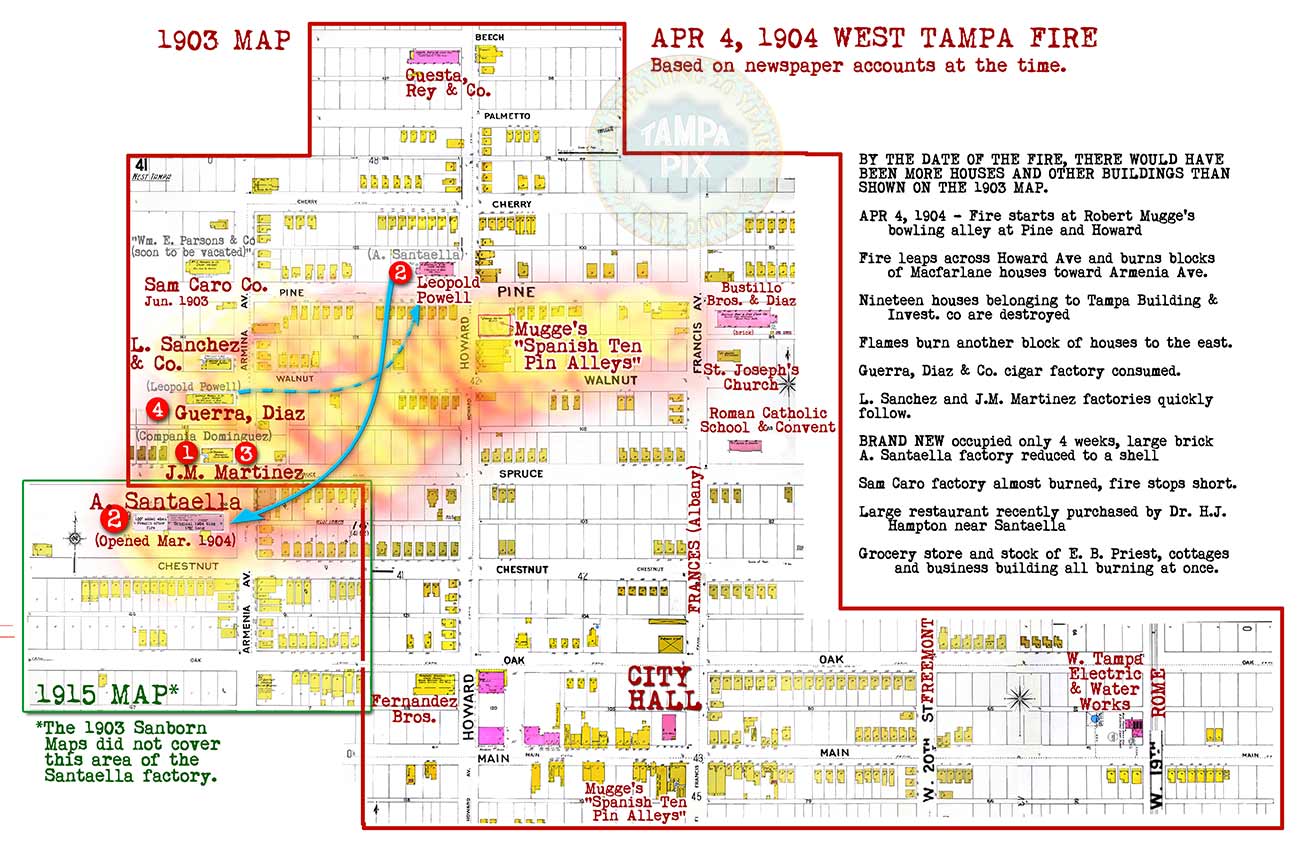
SEE THIS MAP LARGER. WHEN IT OPENS, CLICK IT AGAIN
TO SEE FULL SIZE.

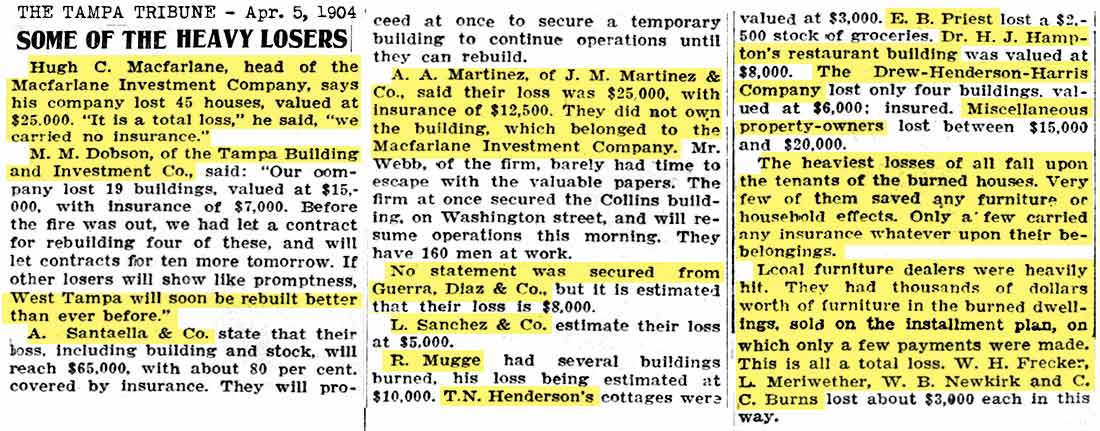
MACFARLANE PARK EARLY HISTORY
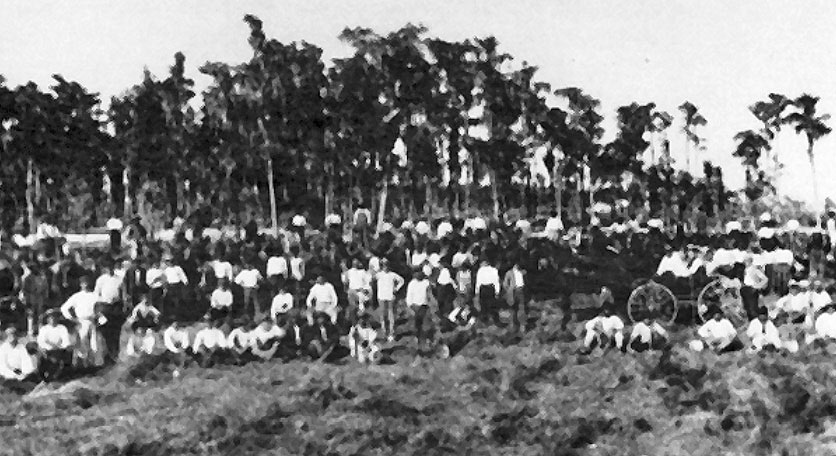
Workers at
Macfarlane park, 1908.
Photo courtesy of
Arsenio Sanchez from West Tampa and the Cigar Industry,
Tampa Bay History magazine Spring/Summer 1991, USF Digital
Collections.
| Our history of Macfarlane Park today states that "In
1908, Hugh Macfarlane donated forty acres of land to the city of
West Tampa for a city park. Workers were
hired by the city to drain and fill the land, and plant trees on it."
However, it appears that it didn't happen in
that order. Work started on the park four months before Macfarlane deeded
the property to the City of West Tampa.
This 1931 Sanborn map is the
earliest to show the area of Macfarlane Park. Place your
cursor on it to see where the park was approximately located on an
1852 land map of Hillsborough County. The area indicates a
forest nearby, but not any swampy land. This would depend on
the time of year as summer is traditionally the rainy season in
Tampa.
|
| |
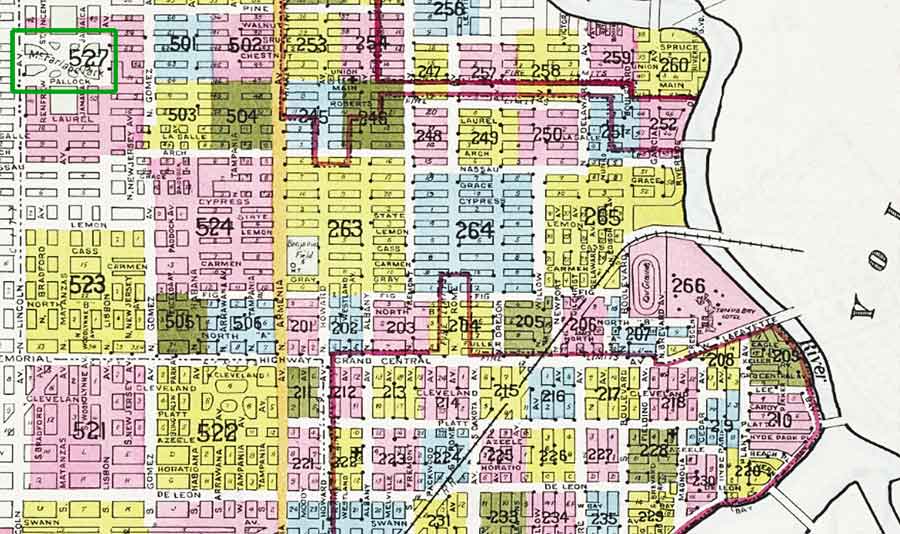
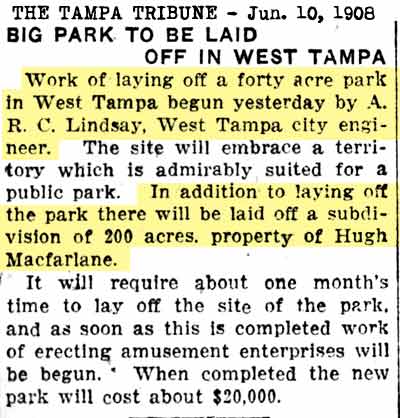
FIRST ANNOUNCEMENT OF BUILDING A PARK IN WEST TAMPA
- MID-JUNE, 1908
This June 10, 1908 article is the
first one found in the newspaper announcing the work of creating a
new park in West Tampa. West Tampa city engineer A.R.C.
Lindsay was busy marking off the FORTY ACRE park.
Also being surveyed was 200 acres of
Hugh Macfarlane's property to build a subdivision.
No reference was made as to who
owned the forty acre property of the park nor was any connection
made to Macfarlane's 200 acres of subdivision being laid out.
The park was expected to cost about $20,000 but nothing is written
about who was responsible to pay the cost.
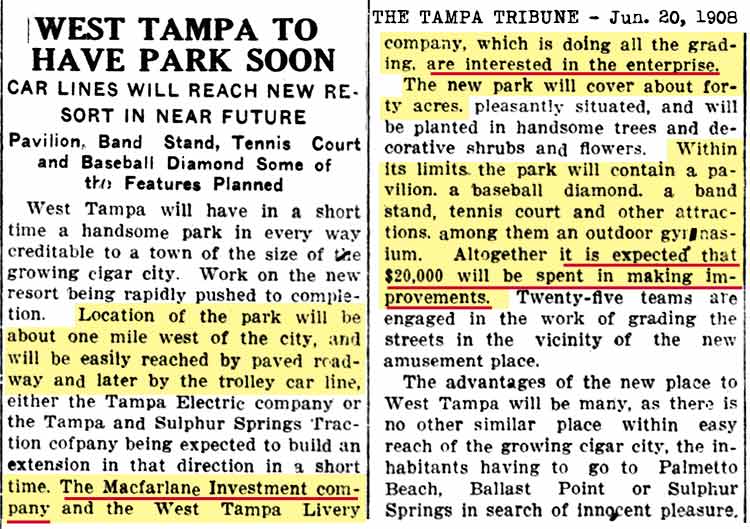
According to the Jun. 20, 1908 article
seen at left, The Tribune reported that the new park in West Tampa was
under way. The "easily reached" location of the park had
already been determined and improvements had already begun.
The Macfarlane Investment Co. and
West Tampa Livery company, who were grading the streets (leveling to
make smooth in prep for paving) were "interested in the enterprise."
This statement makes it appear that neither of the companies were
directly involved with the development of the park at this time, or,
the reporter didn't do much investigation.
The new park would cover about FORTY ACRES.
The reporter describes West Tampa as "the growing cigar city."
NEW WEST TAMPA PARK TO BE AMUSEMENT PARK
This Aug. 29, 1908 article further
below tells of plans to develop West Tampa's new park as an
"amusement park." Work had already begun and was being "rushed
to completion."
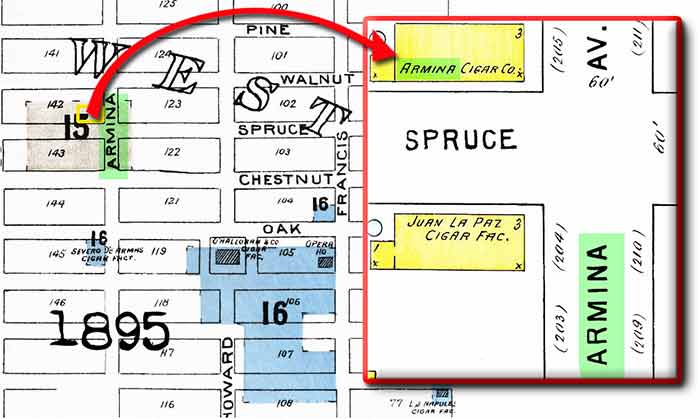
ARMINA AVENUE
The new park was described as
being several blocks from "Armina
Avenue," which was the original
spelling of
present day Armenia Avenue before it somehow changed. This
change was
no official action by the city, it is likely the result of it having
been misspelled on a map or in a newspaper article, or both, then propagated
over time. Armina Avenue was named for the owner of a very
early cigar factory located on this street in West Tampa. When
Macfarlane began to develop the area, the street was named Armina.
Below are Sanborn maps indicating that
in 1899, Armina was still spelled correctly on the key map and the
detail map. But on the 1903 the key map Armina had changed to
Armenia. The detail map still showed Armina. By 1915
both maps showed Armenia.
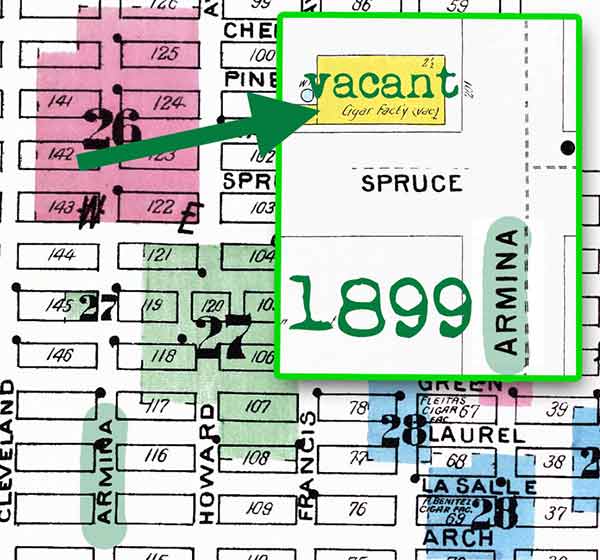
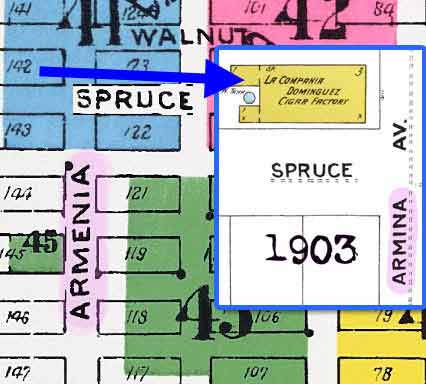
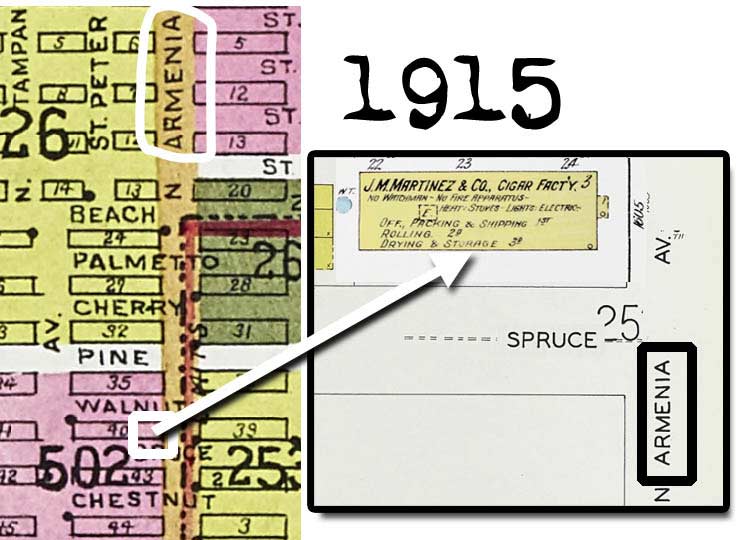
LAND BEING FILLED AND CLEARED OUT -
LATE AUGUST, 1908
The area of the park was "a shallow, dried
out cypress pond, handsomely grown up with large cypress and other
trees." The article goes on to say that the only thing needed
to be done was to
fill in the low areas with several feet of sand and clear out the
underbrush. The low areas were probably subject to
swamping during the rainy season and dependent on the water level of this pond. Plans
included adding ornamental trees, shrubs, and equipment such as
swings, merry-go-rounds, roller coasters and possibly baseball
grounds.
Hugh Macfarlane, who is described as "The
Father of West Tampa," had just returned from New York City.
He was welcomed back home and spent the day driving around town
viewing the improvements that had been made while he was away. The rest of the article tells of how well lit
West Tampa was compared to Ybor City and Tampa, and about the paving work
done in the city.
(The title "...BUILDING BY CITY" means "being built by
the city" and is not being used as a noun to refer to a structure.)
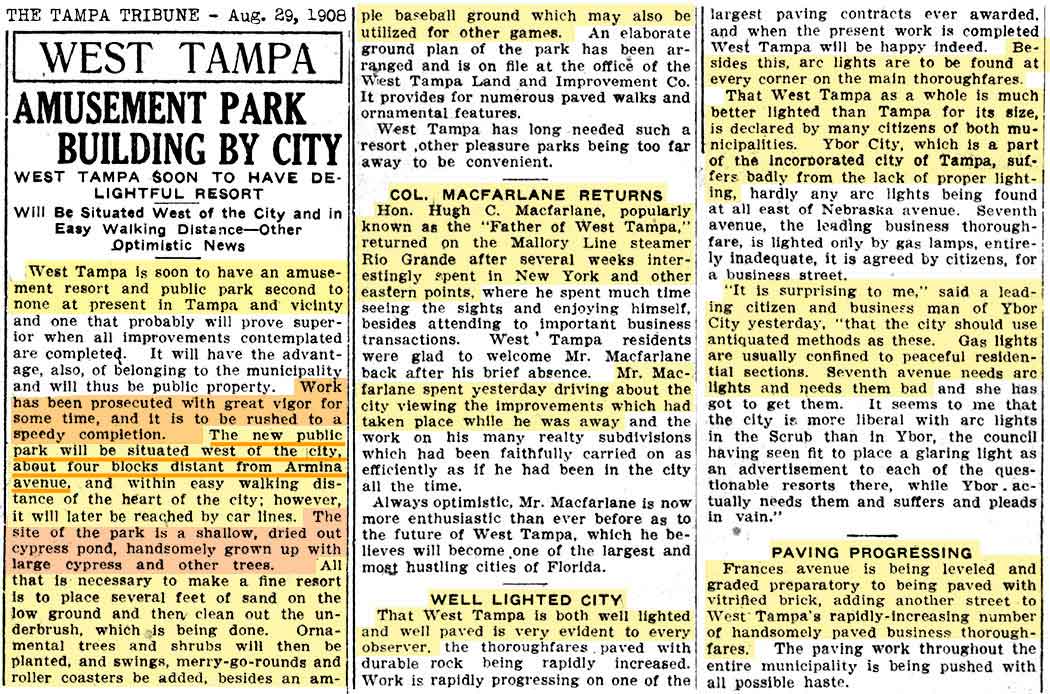
Frances Avenue is the street we now know as Albany Ave. It runs N/S
a block east of Howard Ave. Macfarlane named it for his wife,
Ida Frances Pettingill.
So far, there has been no mention of the park's land
being property formerly belonging to Hugh Macfarlane or the
Macfarlane Investment Company. The June 20 article seems to
imply that the Macfarlane Investment Co. had no prior connection to
the park land other than being interested in the development.
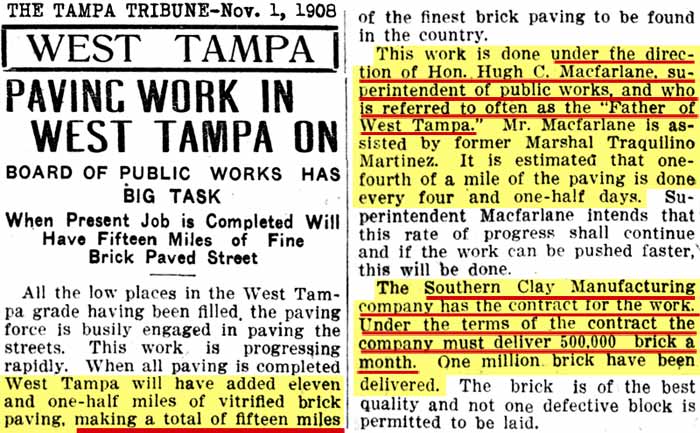
WEST TAMPA BRICK STREET PAVING
In Nov. 1908, West Tampa underwent a
street-paving blitz, under the direction of Hugh Macfarlane who at
the time was West Tampa's superintendent of public works. He
was assisted by former WT marshal Tra(n)quilino Martinez. When
completed, WT would have added eleven and a half miles of vitrified
brick paving to bring their total to fifteen miles. It was
estimated that a quarter-mile of paving was being finished every
four and a half days. The paving was being laid by the
Southern Clay Manufacturing Co. and their contract called for
500,000 bricks to be laid per month.
Being a member of the City of West
Tampa government as the Supt. of Public Works, Macfarlane's job
would have been to develop and build projects within the
City that were NOT at his own or his company's expense, but instead
financed by the City.
BASEBALL FIELD AND LEAGUE PLANNED IN WEST TAMPA
This Nov. 12, 1908 article tells of
work having been started on a baseball diamond located centrally "in
the City Park." Still there is no name mentioned for the park. Local teams were to be organized with a champion to be
determined for the season. The article credits West Tampa cigar
factory workers as some of the best ball players in South Florida
who had represented Tampa baseball in past years.
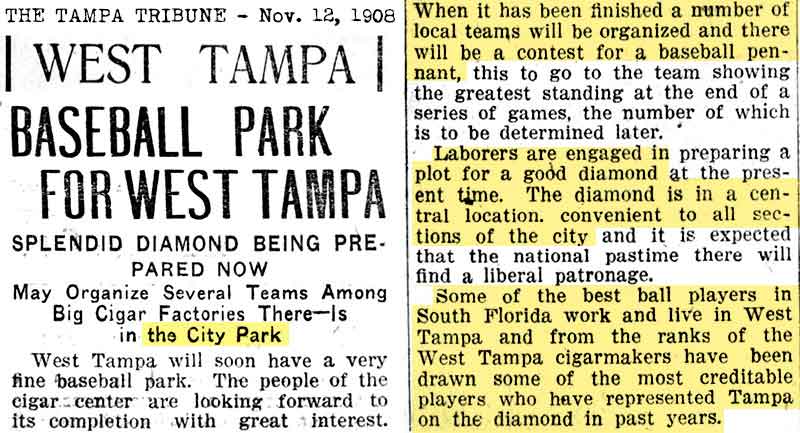
LARGE PAVILION TO BE BUILT IN
MACFARLANE PARK
This Dec. 1, 1908 article is the first one to mention the new park as "Macfarlane Park." A
long-time West Tampa goal of having a large pavilion is finally
being planned for Macfarlane Park. The "rustic pavilion"
was to be 75 feet wide and 150 feet long. No official naming
of the park was found in the Tribune.
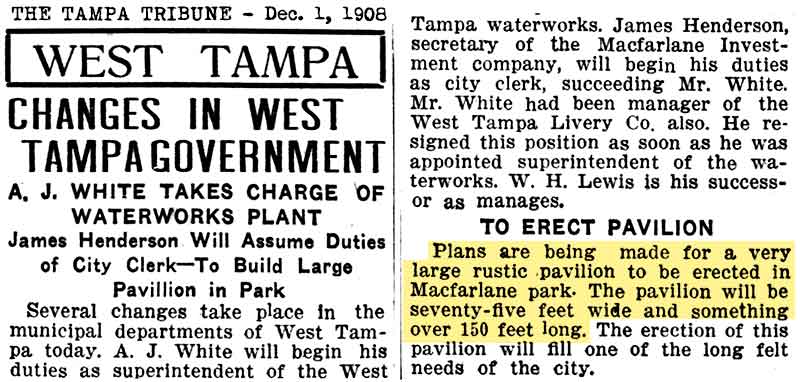
|
|
|
GYMNASIUMS
PLANNED FOR MACFARLANE PARK
This Dec. 3, 1908 TRIBUNE article says
that the board of bond trustees of West Tampa has
planned for two gymnasiums to be built at Macfarlane
Park--one for boys, one for girls.
Notice also the park was having a
perimeter fence put up. |
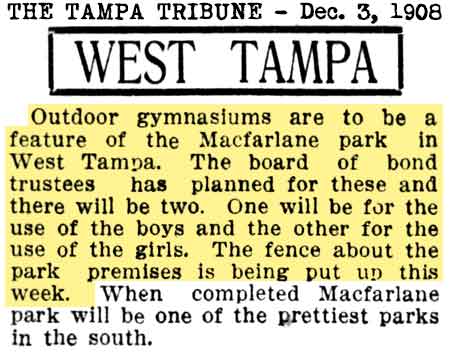 |
ERA OF PROSPERITY IN WEST TAMPA
SEES "COMPLETION" OF MACFARLANE PARK
Things were looking up in West Tampa and expectations
for growth were at a high. The term
"completed" was used loosely as you will soon learn and usually meant the bare
minimum. From that point on, the rest of the construction was
usually described as "improvements" and was often started right
after "completion." In this case, Macfarlane Park was
"completed" but paving was being rushed and an additional crew of
men was put to work on the "improvements" at Macfarlane Park.
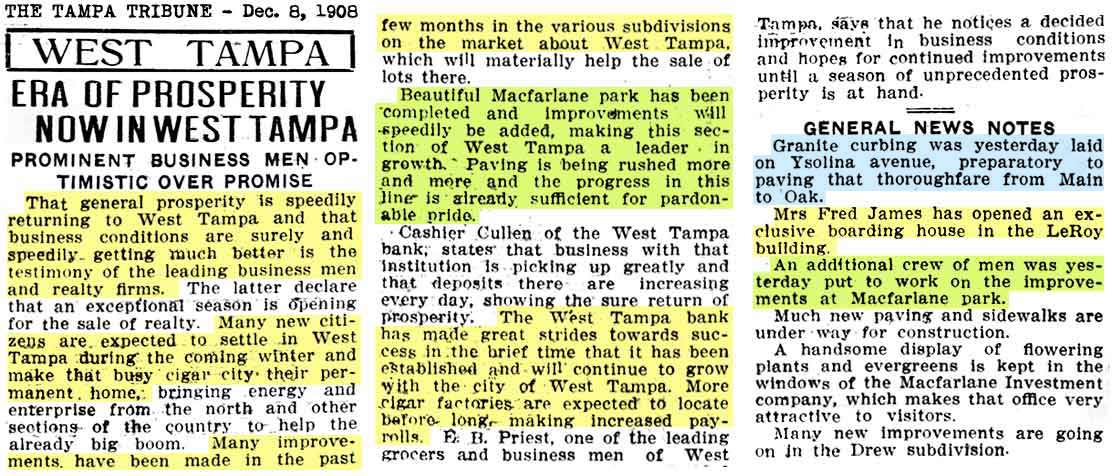
Mrs. Fred James was probably the wife of architect Fred
James, who designed many of Tampa's buildings during this era,
including the future Carnegie Library and many schools.
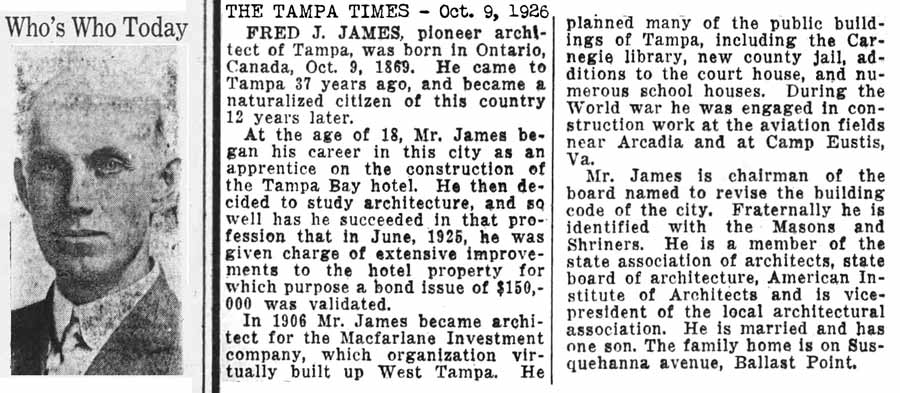
MACFARLANE PARK BACK TO BEING "NEARLY COMPLETED"
These December 10 & 11, 1908 articles describe again
that the park was nearing completion and would open soon. It
was predicted to be a site for the amusement of the "countless
thousands of workers employed in the big cigar factories..." as well
as citizens of "GREATER TAMPA" (not Tampa BAY) Latins and
Americans, and the thousands of tourists within the city's borders
during the winter."
"Endowed
by nature with unusual beauty, giant cypresses rearing their
huge forms a hundred feet into the air, their branches covered
with the witching gray Spanish moss, gray and hanging far down
toward the ground, the acme of fantastic decoration, Macfarlane
Park will have all the natural charms enhanced a thousand fold
by what is added by man, in the shape of rustic benches, summer
houses, shady walks, and tinkling fountains. There will be
awnings for the children and ample grounds for baseball and
other sports for the elders."
Notice here in this article Armina
Avenue has been misspelled as "Armenia" within four months after the August
article displayed earlier on this page.
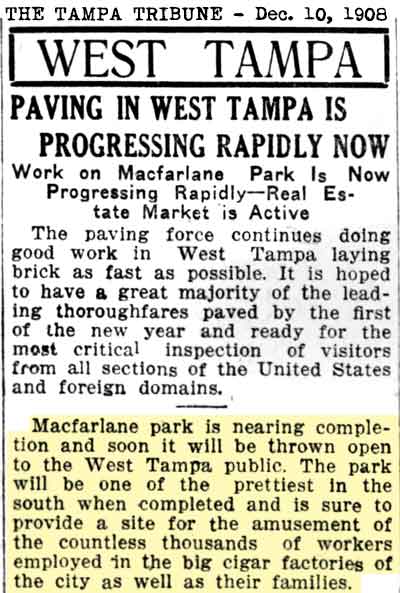
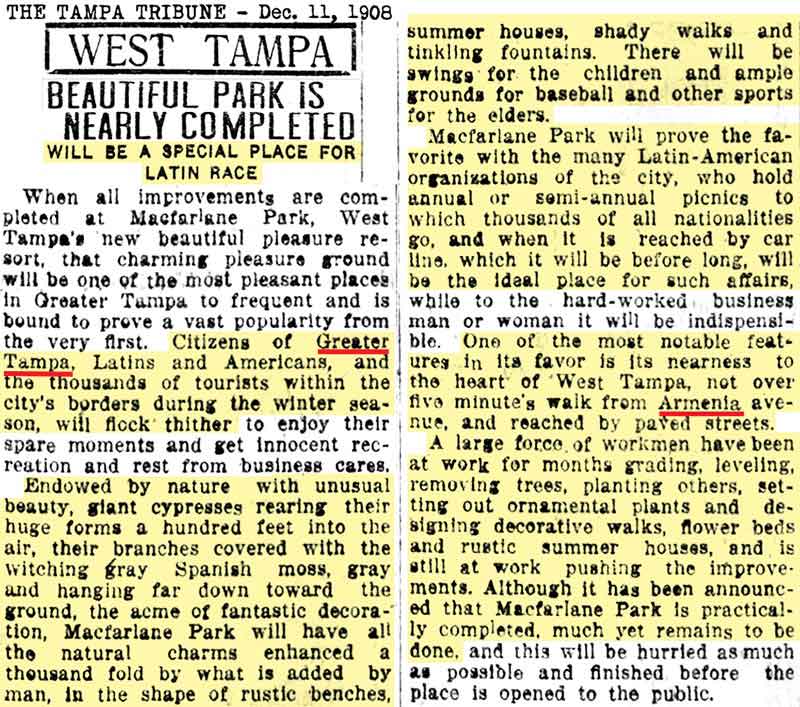
Future improvements aren't mentioned, so the absence
of mention of the gymnasiums and playground equipment doesn't
necessarily mean they've been cut out of the plans. "Much
remains to be done."
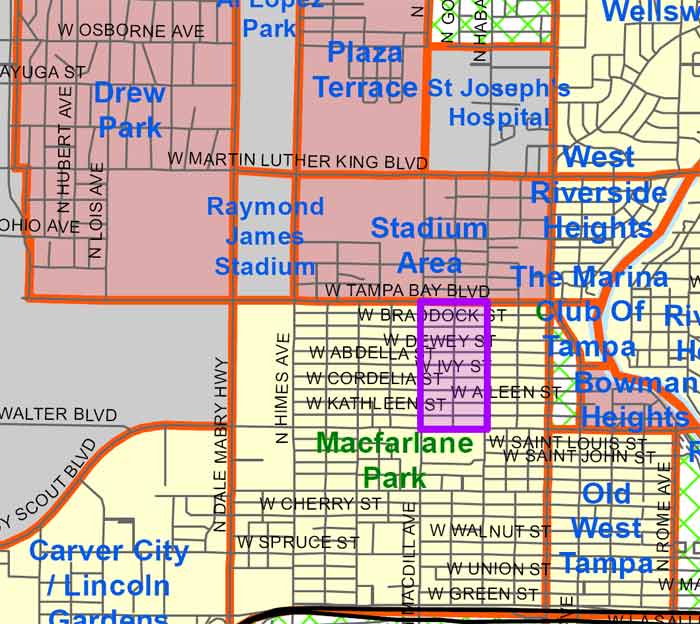
THE DREW SUBDIVISION SHOWING
PROMISING GROWTH
Less than a year earlier, John Higley
Drew filed his plan for a subdivision in northwest West Tampa.
Known as Drew's Subdivision, it included the property between the
city limit at Tampa Bay Blvd on the north, and Michigan Ave.
(today's Columbus Drive) on the south. The western border was
known as "Roosevelt Ave." back then, named for Col. and President
Teddy Roosevelt. Today it's called MacDill Avenue, named for
Col. Leslie MacDill. On the east was Habana Ave.
Today this neighborhood is located in
the northern half of the Macfarlane Park neighborhood,
marked in
purple to the right.
In April 1909, Drew would make his
first addition to this subdivision by adding the area from Roosevelt
Ave. westward to the city limit at Lincoln Avenue, between Tampa
Bay Blvd and Michigan Ave., approximately doubling the area.
LAND VALUE IN WEST TAMPA ON THE
RISE
[SUMMARIZE]
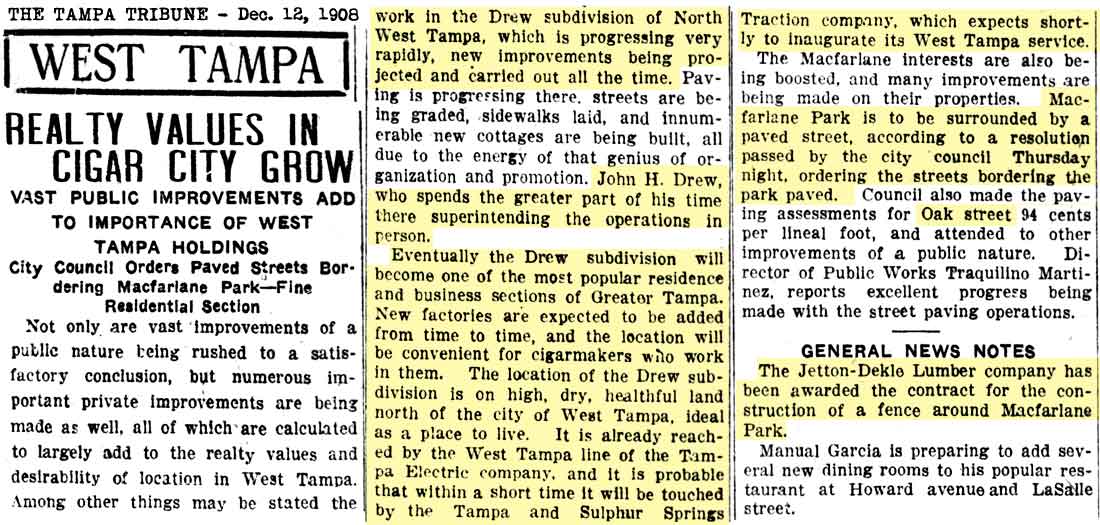
John Higley Drew
Birth: Jan. 8, 1864 Jackson, Clarke Co, AL
Married1: Apr. 18, 1886 Hillsborough Co. (Divorced
Jul. 1911)
Married2: Apr. 13, 1913 Bellaire, OH
Death: Dec. 22, 1938
Occupation: cattleman and land developer
Father: John Wesley Drew b.Mar 2, 1839, Mount Pleasant,
Monroe, AL, d. Feb 12, 1912, Clearwater, FL Age 72 years
Mother: Hannah Hall Wallace b.Jun 15, 1841, Sumter, AL
d. Aug 31, 1932, Clearwater, FL, (Age 91 years)
Wife1: Mary Abdella "Abbie" Rogers b. Mar 8, 1871,
Clearwater, FL, d. 18 Jan 1963, Clearwater, FL
(Age 91 years)
Wife2: Sylvia Deane Hamilton
Children by 1st wife Abdella Rogers
-------------------------------------------
Ivy Drew b.Oct 12, 1887 Clearwater, m. Husb:
William McCubbin Webb, Ivy d. 15 Apr 1973 (11
children)
Cornelia Drew b.Oct. 1889 Clearwater, m1. 7 July
1915, Clearwater to George Rice Smoyer, (3 ch), m2
Wells Cornelia Drew Smoyer Webb d. May 1968, Pinellas
Co.
John H. Drew b.Aug. 1892 d. bef. 1896.
Aileen Drew b.Mar. 31, 1893 m.July 15, 1914 Husb:
George Ray Black (2 daus.), Aileen Drew Black
d.Jun. 11, 1970 Clearwate
John Wesley Drew b.Sep. 17, 1896 m. Jun. 28, 1917 Catherine Nipp,
4 Childr (Div Aug 1933), m2 Dec 1934 Pauline Hawrsk (Div
Nov 1942). J. Wesley Drew d.Oct 1981. Tire Salesman
James Dewey Drew b.Jan 19, 1898, Tampa, FL,, m. Marian
Vila Emma Allen, (1 son), James Dewey died 13 Feb
1987, Pinellas Co, FL, (Age 89 years)
Francis Higley Drew b. Jan 20, 1900, Mar: Katie
Elizabeth Wilcox Nov. 14, 1925. Francis d. Jul 2,
1981 Hillsb co.
Richard Leroy Drew b.May 7, 1905 Tampa, FL, m.June 1928
Charlotte, NC, to Eleanor G. Garrett, (Div. 1947) Richard Leroy died
Sep. 21, 1973 San Antonio, TX
Leland Fitzgerald Drew b. Dec. 11, 1908, m. Jul.
18, 1937 FL to Eloise Ozella Jones. Leland
Fitzgerald died Mar. 15, 1979 in Clearwater, FL.
Children by 2nd wife Sylvia Deane Hamilton
--------------------------------------------------
Jerome Hamilton Drew b. 1915, d. 1990
Clarine Melissa Drew b. 1917, d. 2001
The City of Tampa established a municipal airport at
Drew Field in 1928 on a 160-acre tract leased from
farmer, real estate developer and aviation enthusiast
John Higley Drew. The City purchased Drew Field in 1934
and added new runways, hangers and lighting that were in
large part financed by federal funding through the Civil
Works Administration (CWA) and the Works Progress
Administration (WPA).
JOHN
H. DREW SUBDIVISIONS OF WEST TAMPA
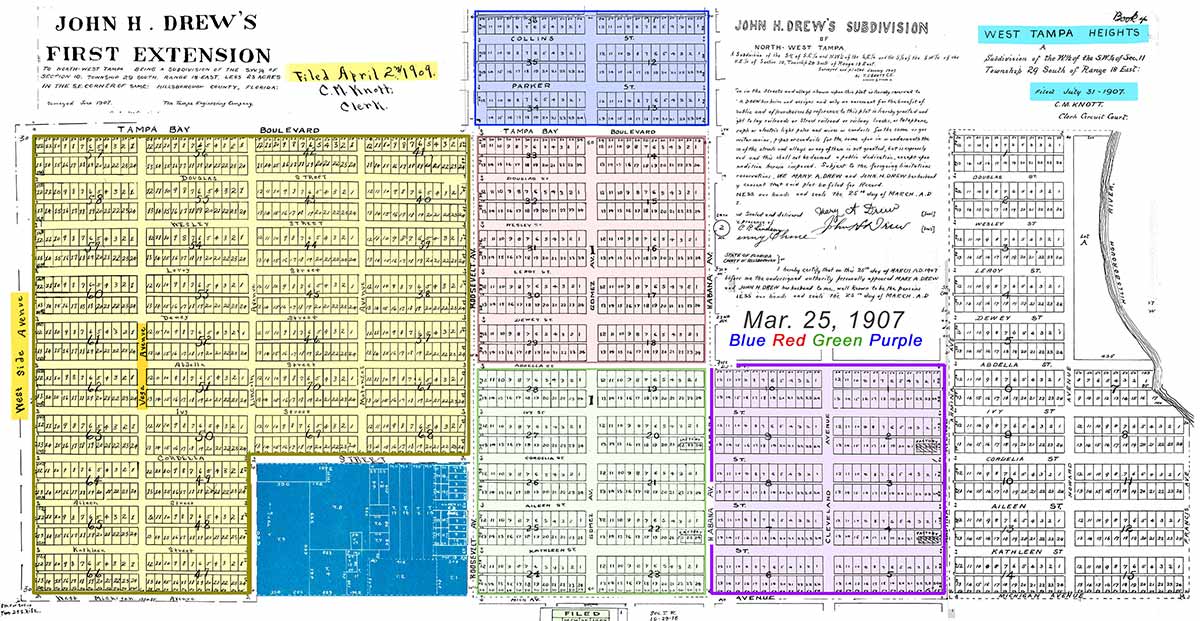
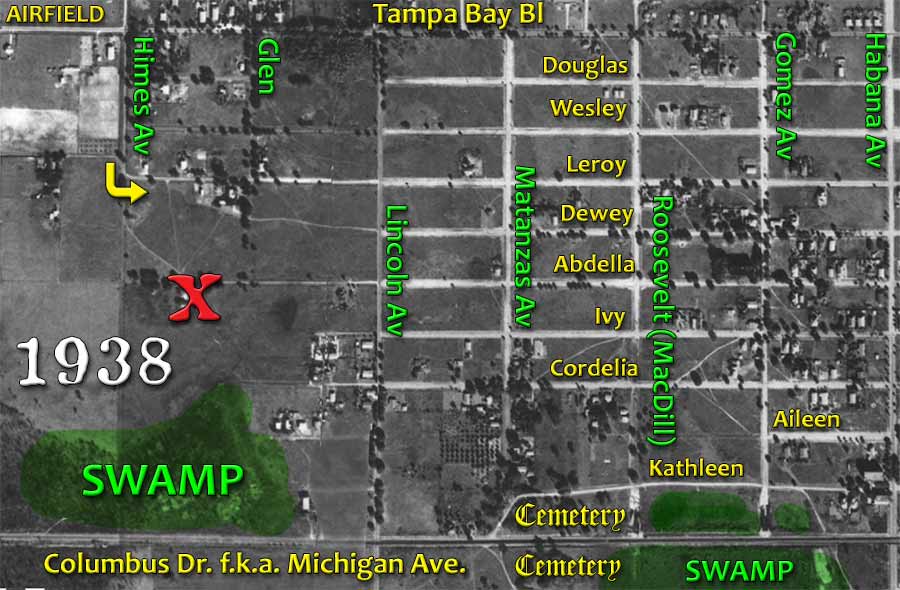
The 1938 aerial photo at right shows
that in the yellow area above Himes Ave had not
yet reached Columbus Drive and streets had not yet been
extended very much west of Lincoln Ave.
Kathleen St. was diverted to Columbus
Dr. at Matanzas due to private properties not yet
acquired by Drew.
The red X marks where a B-17 bomber
crashed from takeoff at Drew Army Airfield in 194-.
|
|
Drew named the E/W streets for family members, some are
first names, some are middle names.
These images are from the
University of So. Fla. Digital Commons,
City of Tampa Plat Books collection.
Click the image to see it
larger, then click it again to see it full size (2000 px
wide.)
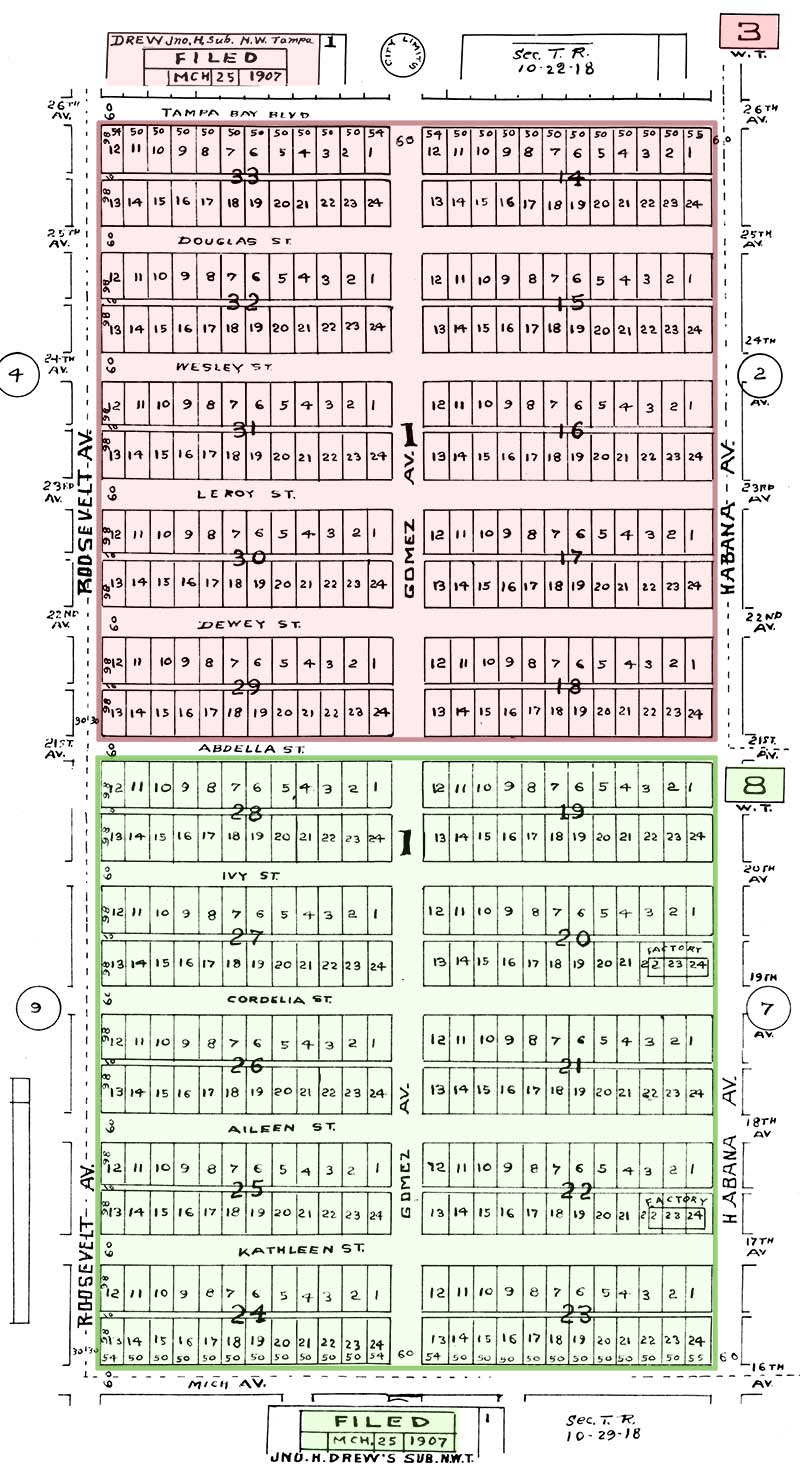 |
John Higley Drew was the other
major developer of West Tampa. On the left are the images of John
H. Drew's subdivisions filed on Mar. 25, 1907.
This is a composite image of page 3 and page 8 of plat
book volume 3. Drew named the streets for his
children, some first names, some middle names, and his
wife.
The long range plat map
below shows the location of the subdivision in relation
to downtown. In 1909 Drew would add areas 4 and 9
extending westward to the city limit at Lincoln Ave.
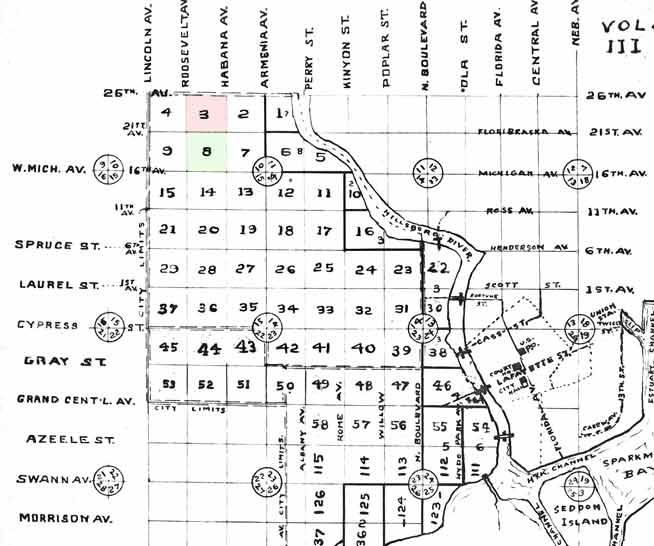
|
|
THE
BIG
HILL
Explosives were being used to blast away
the roots of large cypress trees at the center of the
park so that the pavilion could be built "on a high
mound."
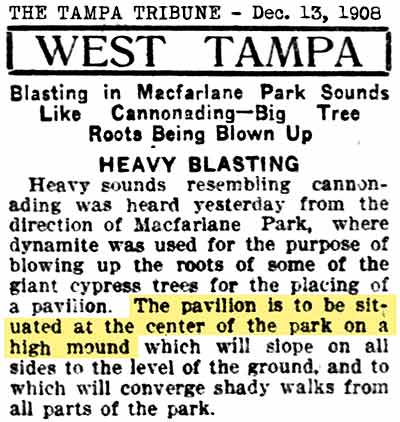 |
MORE IMPROVEMENTS OF WEST TAMPA
[SUMMARIZE FENCE & WATER TANK]
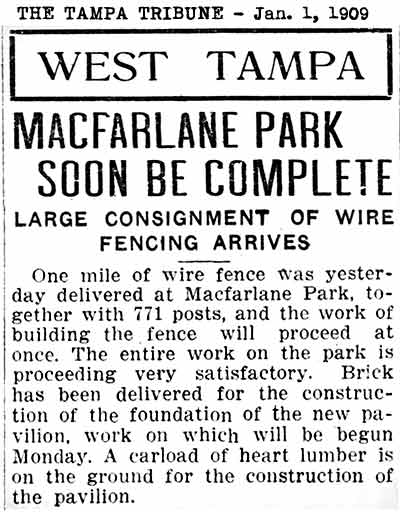
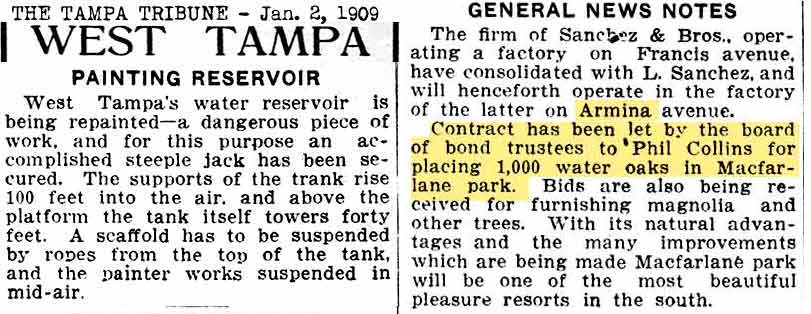
BELOW, these 1903 Sanborn maps (long range and close up) show the
location of the reservoir mentioned above as being painted. The WT water works and electric plant were located at the northwest
corner of Main St. and what is now N. Rome Ave. Back then it
was Main St. & W. 19th St.
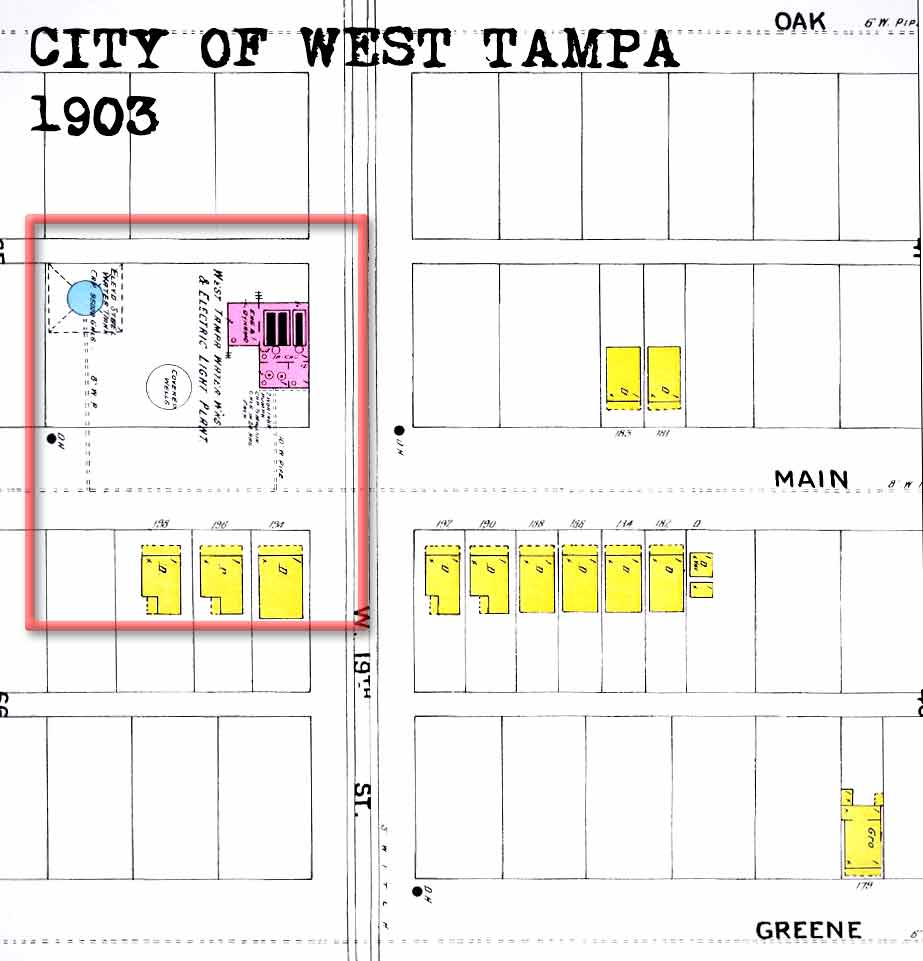
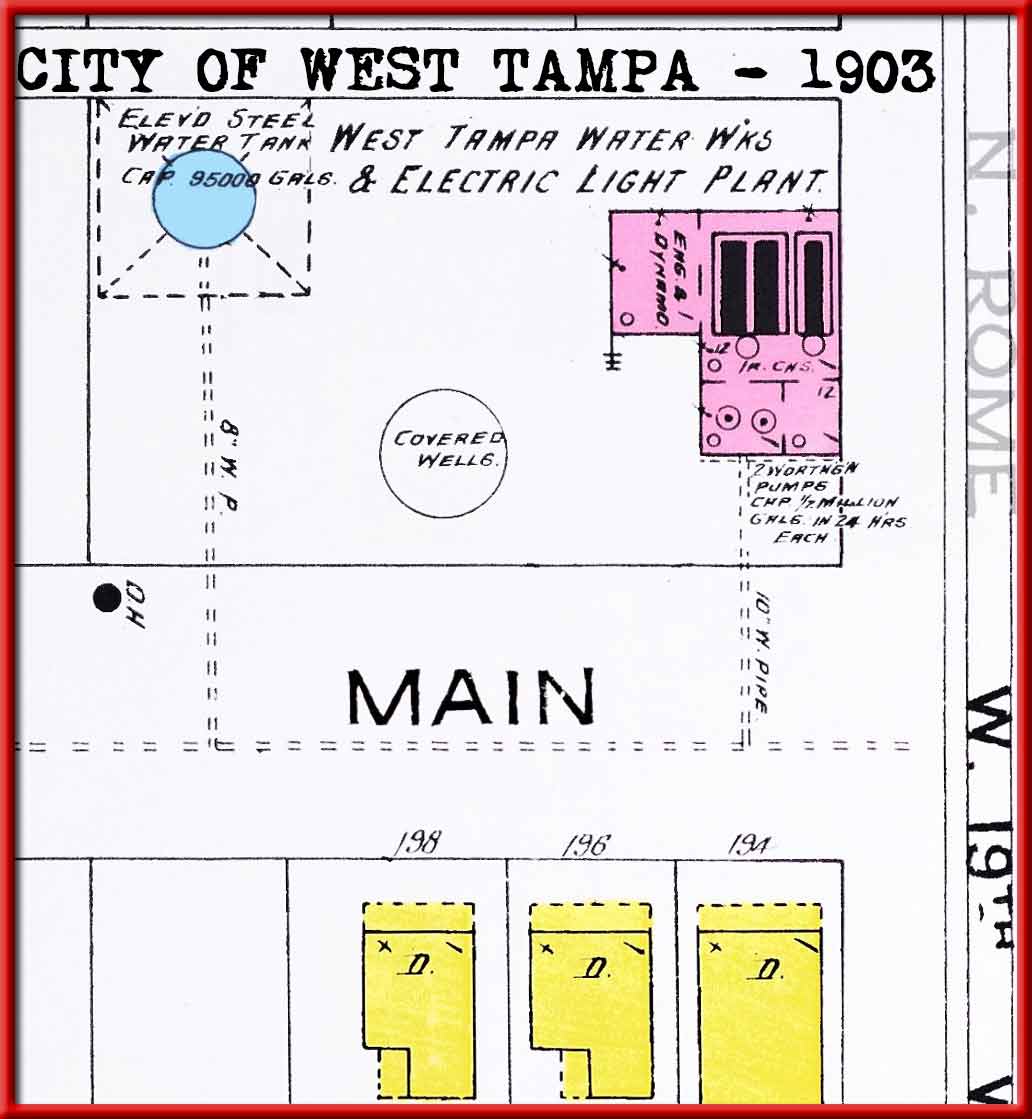 |